
Magazine Spring 2024 VOLUME 87 | NO. 2
Welcoming the Year of the Dragon

Celebration of Lunar New Year at Loomis Chaffee spread across two weekends in February and included dance workshops and performances, a traditional tea ceremony, and a tasty Lunar New Year party with foods from China, Japan, Korea, Thailand, and Vietnam, among other activities.


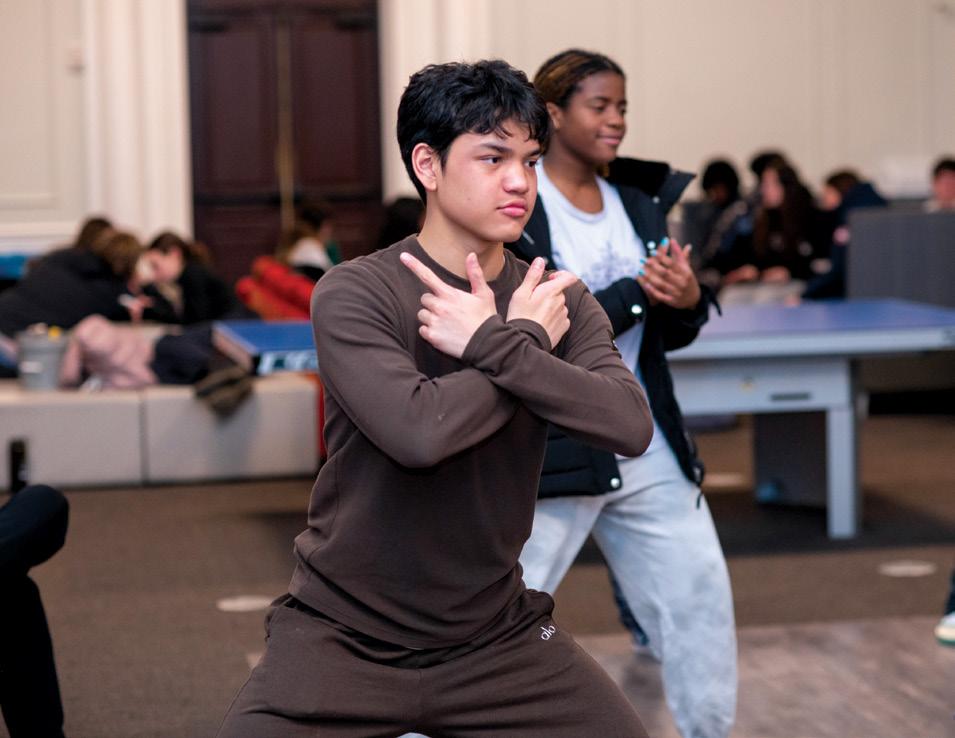

loomischaffee.org 1
Top: Sophomore Claire Cen leads a classical Chinese dance workshop in the Athletics Center Dance Studio. Middle: Students learn Thai Chi from a visiting instructor from Asian Performing Arts CT. Bottom: The colorful guest of honor (along with its helpers) pauses after a Dragon Dance in the Scanlan Campus Center.
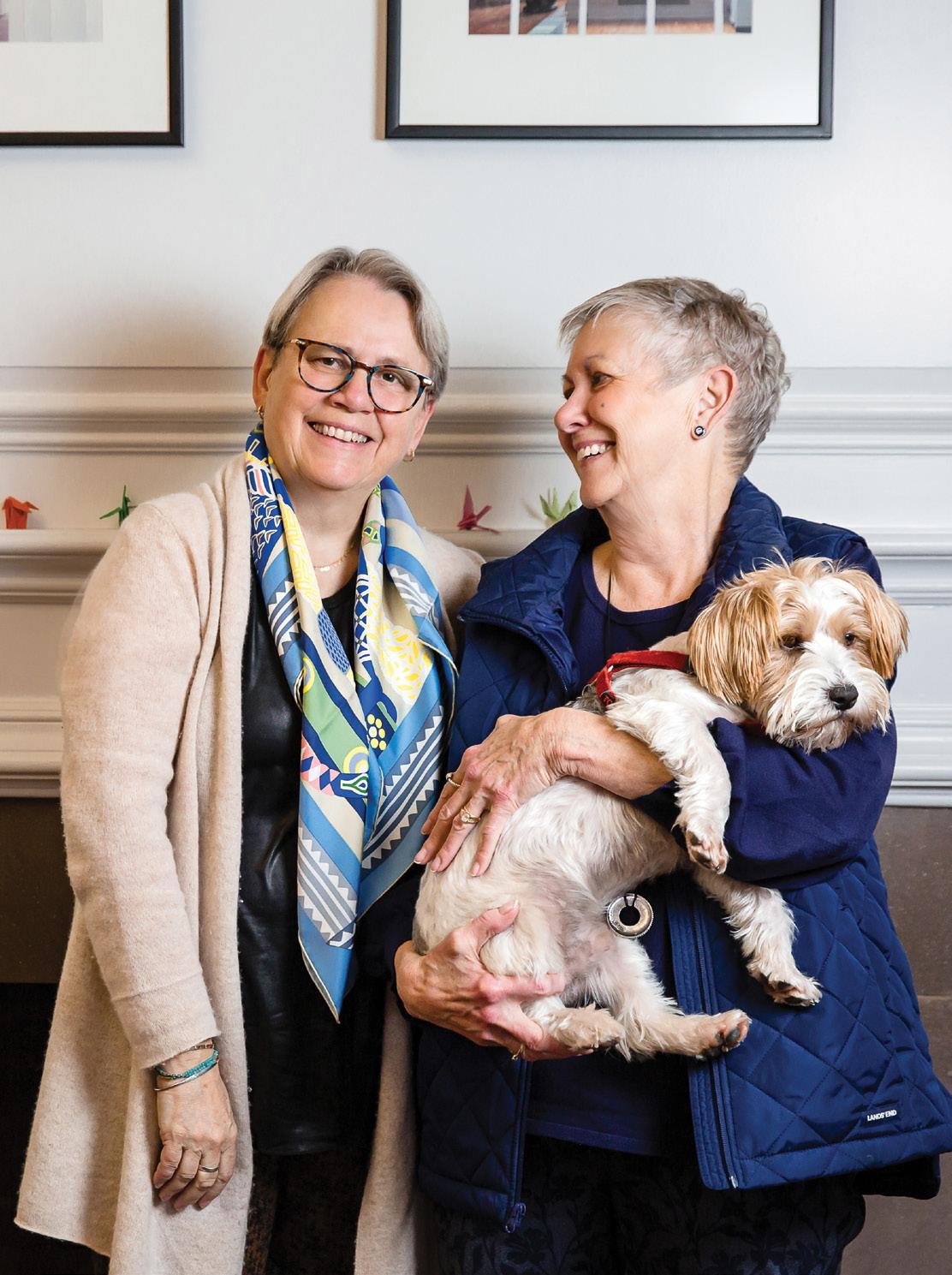
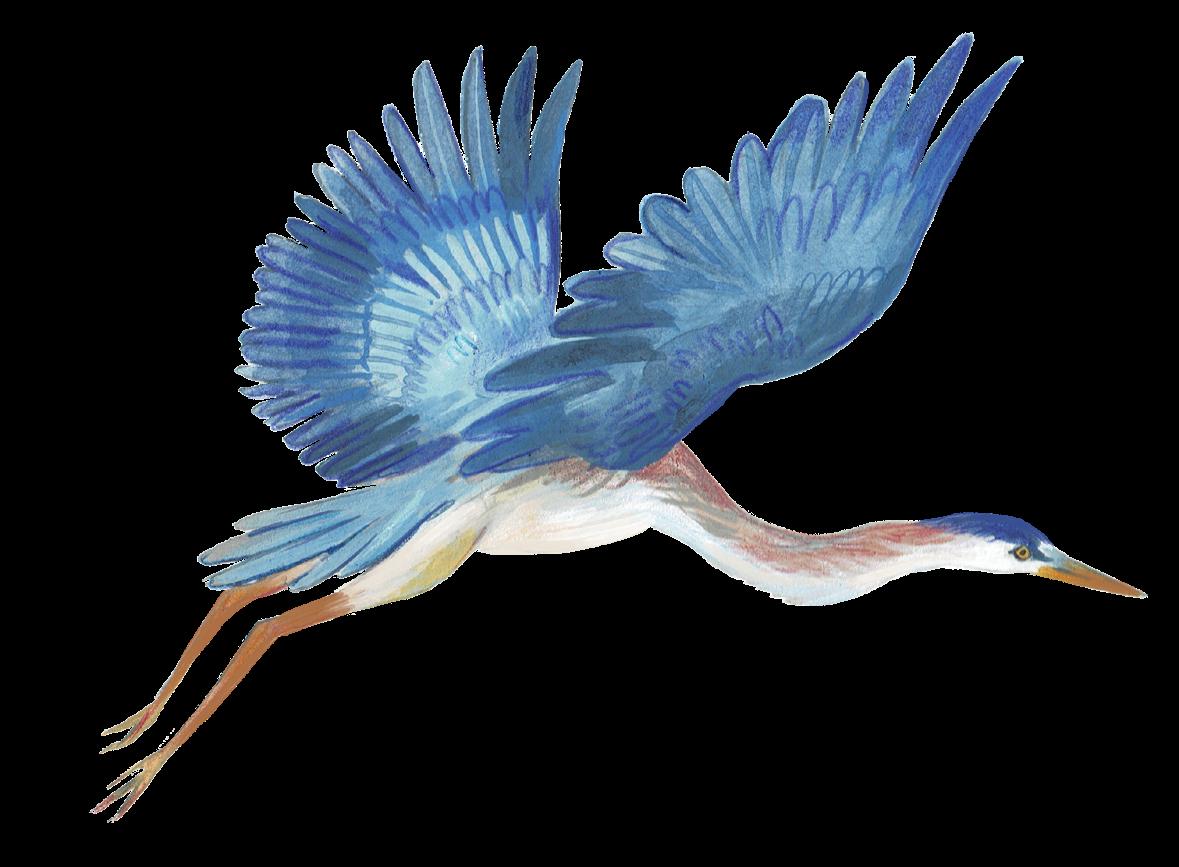

2 Loomis Chaffee Magazine Spring 2024
38 24
Zoe isn’t so sure.)
As her retirement approaches, Sheila Culbert reflects on her tenure as Loomis Chaffee’s seventh head of school.
Creatures of the Confluence
The campus is surrounded by a rich ecosystem of wetlands, meadows, woodlands, and rivers — all bursting with wildlife.
More Than Just a Taste of Success
Restaurateur and entrepreneur Elizabeth Blau ’85 has built a global firm specializing in restaurant planning and development.
EDITORIAL & DESIGN TEAM
Lynn A. Petrillo ’86 Director of Strategic Communications & Marketing
Becky Purdy Managing Editor
Kelley Albert
Senior Graphic Designer
Jeff Otterbein Obituaries Editor
CONTRIBUTORS
Jeff Otterbein
Deidre Swords
Heidi E.V. McCann ’93
Paige Abrams
Lisa Salinetti Ross
PHOTOGRAPHY
Iris Photography
Catherine Johanna Photography
Lynn Petrillo
Jessica Ravenelle
Mary Forrester
Megan Du Plessis
Jeff Otterbein
Defining Studios
Stan Godlewski
PhotoFlight Aerial Media
Kelley Albert
Hugo Juarez Photography
Bill Milne
Kathy Tran
Amanda Gentile Photo
Loomis Chaffee Archives
Facebook (@loomischaffee)
X (@loomischaffee)
Instagram (@loomischaffee)
LinkedIn (The Loomis Chaffee School)
loomischaffee.org 3 Contents Spring 2024 | Volume 87 | No. 2 32 24 38 44 45 FEATURES
Vision & Gratitude
her
our annual listing of recent
by
authors. DEPARTMENTS 4 From the Head 5 Island News 18 Faculty and Staff News 20 Pelican Sports 46 Object Lesson 48 News from the Alumni/Development Office 56 Obituaries 65 Reflections SUBMISSIONS/STORIES & NEWS
may
Editors The Loomis Chaffee School • 4 Batchelder Rd • Windsor, CT 06095
• magazine@loomis.org
Faculty Desks The desk of Associate Director of Innovation Jennine Solomon offers clues to
passions for creating, teaching, and learning. Alumni Writers Browse
books
alumni
School community members
contribute items of interest to: Loomis Chaffee
860.687.6811
You
will
Printed at Lane Press, Burlington, VT Printed on Sterling Ultra Matte
Visit Loomis Chaffee online at www.loomischaffee.org for the latest school news, sports scores, and galleries of recent photos.
also
find direct links to all of our social networking communities. For an online version of the magazine, go to www.loomischaffee.org/magazine.
A Labor of Love
by Sheila Culbert
Over the past 16 years, I have written on a host of different topics related to education and the school—this final column is to say thank you and goodbye. While I am looking forward to my retirement—travel, photography, family, reading, service, and gardening (what’s not to like?)—I also know that I will miss the many friends that I have made during my time at Loomis Chaffee. It has been an enormous privilege for me to have served as head of this extraordinary and very special place. The special feeling that exists amongst Loomis students, faculty, staff, parents, and alumni unites us as the Pelican Nation, and no matter where I go, I will always proudly identify as a Pelican.
In my final year, I have been thinking more and more about our five Founders and their original intention for the school: that some good would come from the harvest of their lives. In the midst of their grief after having lost their own children, they had a vision to use their considerable fortune to create a school where other people’s children, children from all walks of life and from around the world, could thrive and grow and give back to society. The school did not come into existence until after they had all died, and so they had no idea just what they had created. I think, though, if they were alive today, they would be so proud of The Loomis Chaffee School, and they would be astounded at just how much good they have created over the years through the good work of our students, alumni, faculty, and staff. The Founders’ bequest was an act of extraordinary generosity and faith that continues to inspire those of us lucky enough to benefit from their endeavor.
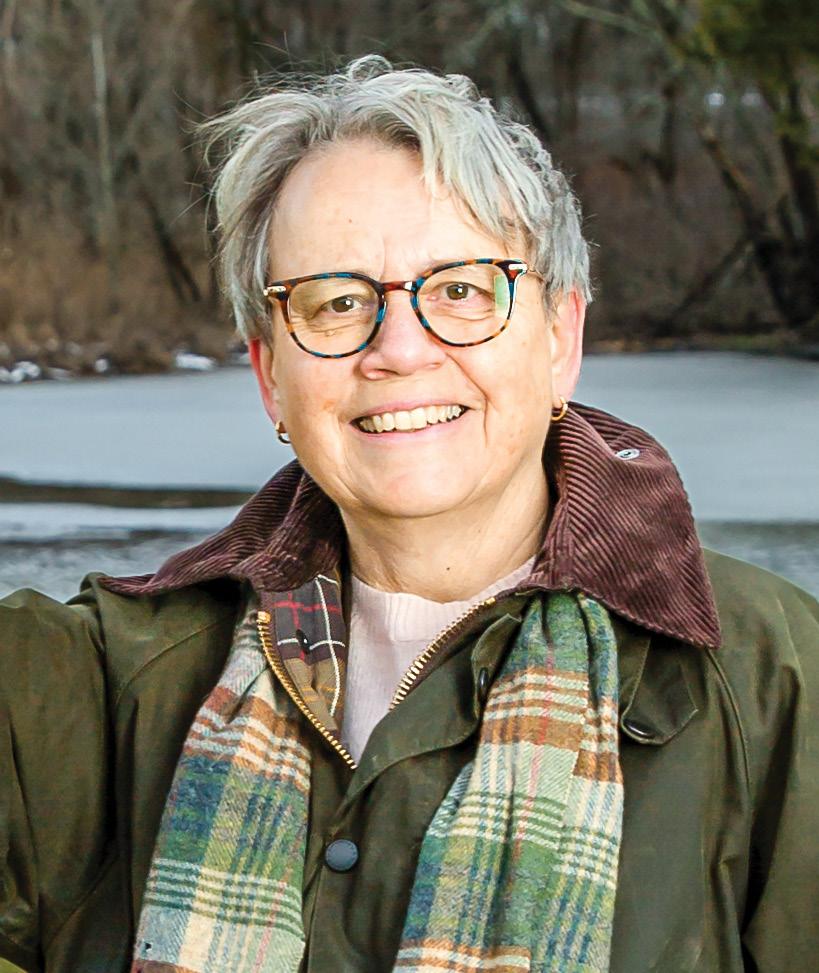
“The Founders’ bequest was an act of extraordinary generosity and faith that continues to inspire those of us lucky enough to benefit from their endeavor.”
— SHEILA CULBERT
I have also over the years been inspired by Nathaniel Horton Batchelder, our first headmaster, and how he built upon the Founders’ vision. I often remind students today of his desire to create a school where it is easy to be good and to be kind; such seemingly simple values that make all the difference in how a community thrives. Mr. B. was particularly eloquent about the need to educate our students to be good citizens, and he often spoke up about world events. In the 1930s and ’40s, he was a strong advocate for world peace, and he had an expansive view of what schools like Loomis Chaffee could do. In 1928 he wrote in the alumni magazine:
Our boarding schools are not private enterprises but public responsibilities. Our task is not merely to furnish college preparation and social amenities for those who can afford to pay for them, but earnestly to seek potential leaders and train them in the arts and duties of citizenship.
Mr. B. recognized the potential for good within young people when they are provided with a superlative education. Loomis, as a leading educational institution, indeed has a public responsibility to ensure that our students understand what it means to be good citizens. Today, Loomis is recognized as one of the finest boarding schools in the country. We attract students from across the country and around the world, and from all walks of life. Our robust financial aid program enables us to honor the legacy of access that was so important to the Founders, and our commitment to excellence fostered so brilliantly by our faculty keeps our programs relevant and innovative. Our students and alumni make a positive difference in the world every day and truly embody the school’s emphasis on the best self and the common good.
Part of our strength as a school is the strong commitment from all community members to the shared enterprise that is Loomis Chaffee and the recognition that each of us has a responsibility for stewarding this great school for generations of future students. Many thanks to all of my colleagues on the faculty and staff, the Trustees, and the many, many students, parents, and alumni whom I have worked alongside these 16 years. It has been a labor of love and I appreciate you all. May we meet again—and in the meantime, ne cede malis.
4 Loomis Chaffee Magazine Spring 2024
FROM THE HEAD

ISLAND NEWS
MLK Week
“Igniting Progress and Well-Being for All”
Fifty years after Martin Luther King Jr. was awarded the Nobel Peace Prize, Loomis Chaffee held its annual celebration of Dr. King and his drive for equality and justice for all. This year’s week of events, held January 8–12, focused on the importance of promoting diversity, equity, inclusion, and justice in STEM (science, technology, engineering, and mathematics) fields.
“In doing so, we ignite progress and well-being for all,” noted Ashley Augustin, chief diversity officer and the director of Loomis Chaffee’s Center for Diversity, Equity & Inclusion (DEI).
The keynote speaker for MLK Week was Raychelle Burks, an associate professor of chemistry at American University in Washington, D.C. An analytical chemist, she has worked in a crime lab and has made significant contributions as a chemist while also advocating for social justice.
As she said, she simply tries to make things better. One example she shared related to
JAZZ POETRY NIGHT
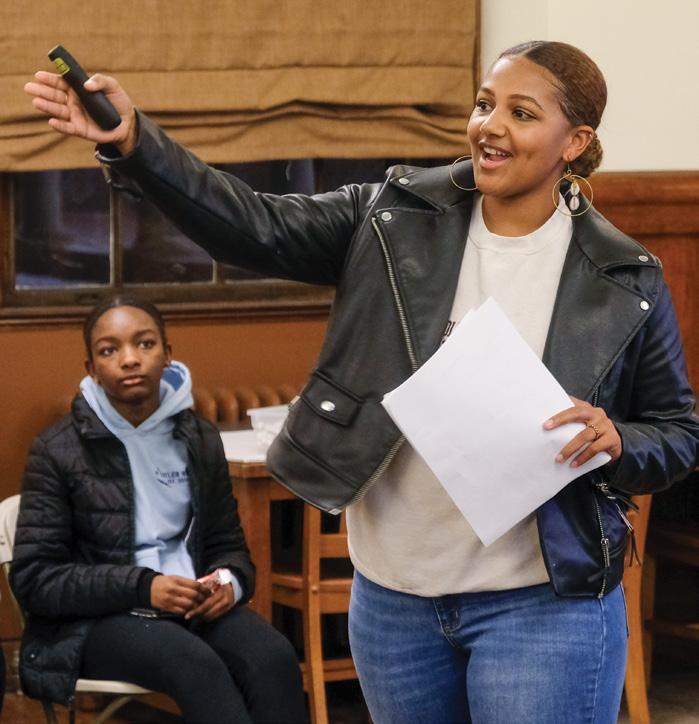
roadside drug tests, which have been documented in article after article as having high error rates and leading to wrongful convictions.
“To me it is a chemistry challenge, but it is also a justice challenge, and that is why we do the work. It is impacting people’s freedoms. ... It can ruin people’s whole lives,” Professor Burks told the students. “A lot of my projects

are like that. I tend to gravitate toward what is the most problematic and how can we make it less problematic. That is a lot of what we do in my lab.”
Her convocation address was followed by discussion in advisory groups then performances by students and a faculty member in honor of Dr. King and his legacy. The Step Team, Dance Company, the Chamber Singers, the Orchestra, solo musicians and singers, and others performed for the school community.
One of the Dance Company performances was choreographed by Lauren Horn ’13. She had been in the dance program when she was a student and now is a professional choreographer/dancer. Lauren said she appreciated the chance to “give back and see where the students are, to be reminded where I was at the time, but to also share my experiences and all that I have learned.”
Also, during MLK Week, climate activist Robin Okunowo met with students in the

6 Loomis Chaffee Magazine Spring 2024
ISLAND NEWS
Norton Family Center for the Common Good and visited classes ranging from College-Level Environmental Science to Topics in Ethical Theory. Ms. Okunowo works for the Captain Planet Foundation, founded in 1991, where she is the program coordinator of Planeteer Alliance, which supports the work of young changemakers.

At the Norton Center, Ms. Okunowo challenged and encouraged the gathered students. “Young people are passing legislation, young people are protesting, young people are boycotting and are making a huge difference, and all of you can do the same,” she said. “Hopefully, you see yourself somewhere in the climate story.”
She also urged the students to be “just and empathetic” in all that they do as they move on in life.

The Norton Center event was a collaboration between the Center for DEI and the Alvord Center for Global & Environmental Studies.
Other MLK Week events included a panel discussion by Loomis Chaffee alumni who attend or attended historically Black colleges and universities (HBCUs) and a jazz poetry night in the SNUG.
An installation in the dining hall for the month of January recognized several environmental activists and artists from around the world who have furthered Dr. King’s legacy of nonviolence and collective action. The installation challenged the community “to consider your connection to the work of social justice and how you can
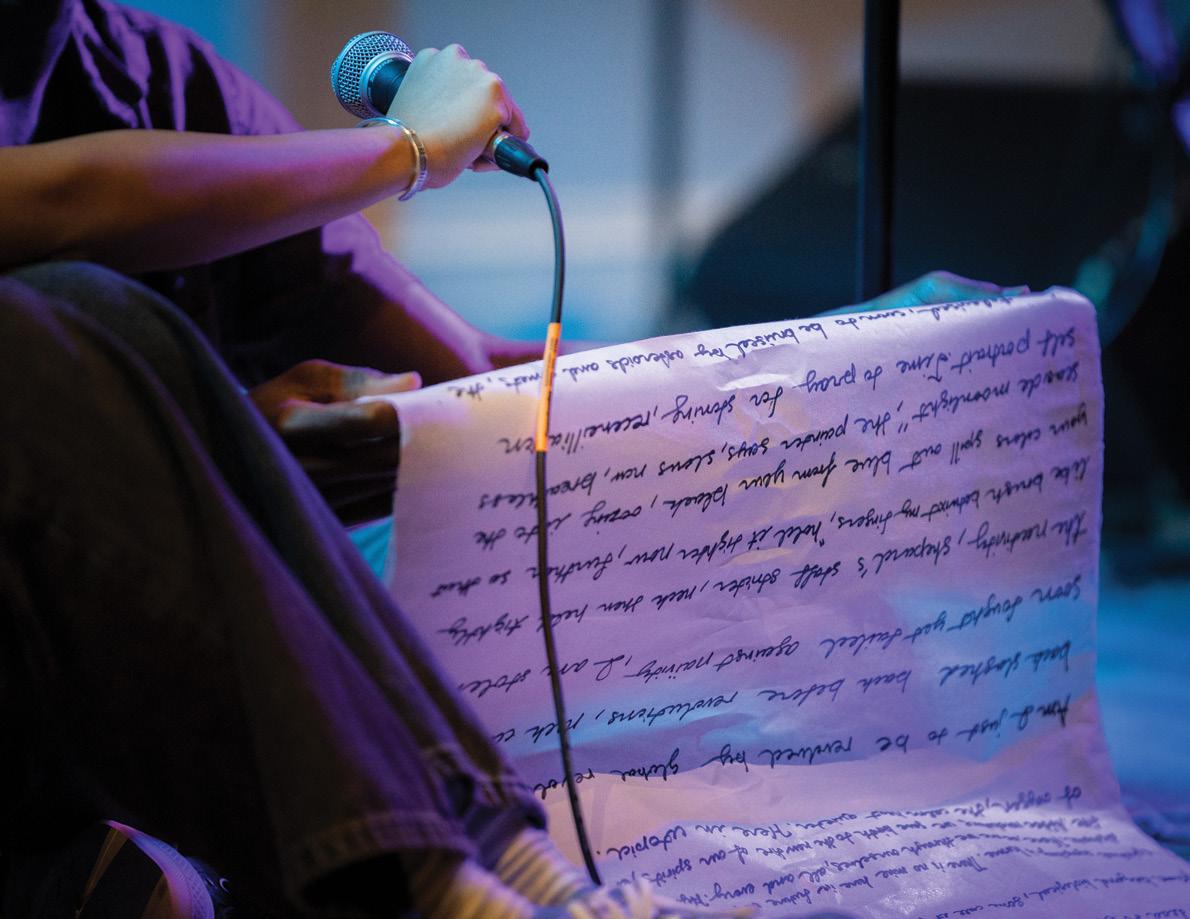
partner and collaborate with others — on and off campus — to do your part in creating a more equitable and just world.”
Opposite page: Climate activist Robin Okunowo speaks with students in the Norton Family Center for the Common Good about being young changemakers. Below: Guest artists and student poets perform in the SNUG for Jazz Poetry Night, the final event of MLK Week. Left: At the MLK Week convocation in the Olcott Center, keynote speaker Raychelle Burks discusses her roles as an analytical chemist, American University associate professor, and social justice advocate. Above: Lauren Horn ’13 works with students on a dance that she choreographed for them to perform for the school community in celebration of Dr. King and his legacy.

loomischaffee.org 7

EXHIBITING ARTISTS
“Presence in the Time of ...,” an exhibition of work by artists Sherese Francis and Alana Ladson, was on display in the Sue and Eugene Mercy Jr. Gallery at the Richmond Art Center from February 1 through March 22 in conjunction with the annual Student Portrait Gallery and featured student artwork in digital and traditional media. Ms. Francis said she wanted “students to feel inspired to grow their own creativity.” Ms. Ladson
said she hoped students “find a sense of hope and peace within my work.” Both artists gave an artists’ talk in the gallery on March 22 and are scheduled to return to campus in April as part of the Adolf and Virginia Dehn Visiting Artist Program.
VISITING MUSICIANS

of pieces composed by Mr. Mokdad when he was hiding from the Islamic State, After the event there was a question-and-answer session with Mr. Mokdad. Earlier in the day the Ekklesia Ballet participated in a workshop with the Loomis Chaffee Dance Company. The visit was made possible with support from the Joseph Stookins Lecture Fund.
VISITING MUSICIAN
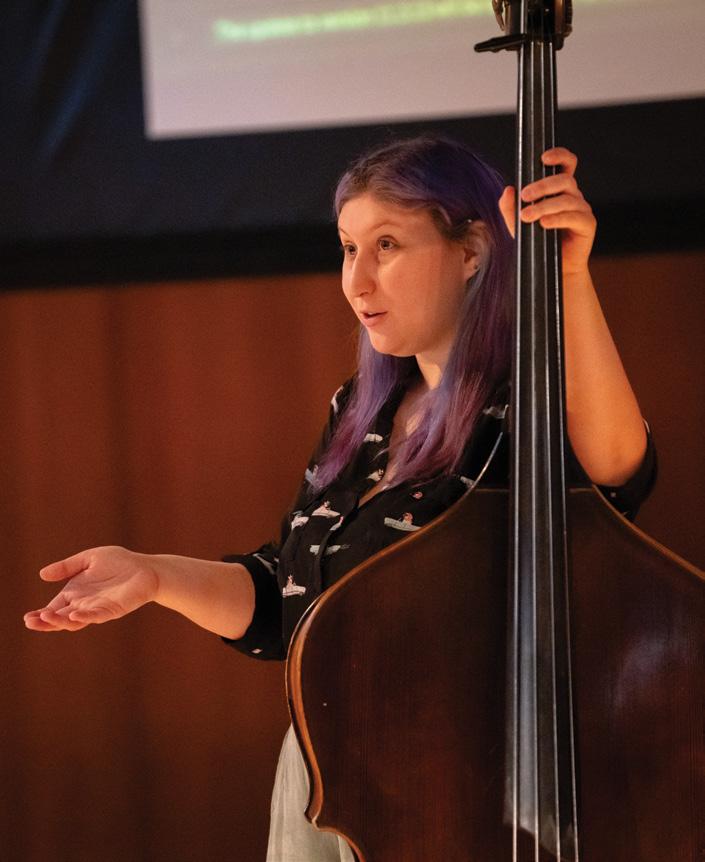
Christie Echols shared her experiences using Ableton Live, a digital audio workstation, in a performance and instructional session in Hubbard Performance Hall in December 2023. The workstation, with multiple tools used to create, produce, and perform electronic music, bills itself as “flexible software that makes music creation and performance fast and fluid.” Ms. Echols started exploring the software’s possibilities in 2019. For her visit to Loomis Chaffee, Ms. Echols brought along her double bass, and during the 50-minute session, she performed and explained what she was doing with Ableton Live. She encouraged the students to experiment. “Once you plug it in for the first time, it will keep getting easier from that time on,” Ms. Echols said. “My suggestion is to rip that Band-Aid off … see what you can do.”
Duo Alterity members Allison Hughes and Joseph Van Doren
8 Loomis Chaffee Magazine Spring 2024 ISLAND NEWS
Top: Artists Alana Ladson and Sherese Frances in Mercy Gallery Above: Musician Christie Echols in Hubbard Performance Hall Left: A performance of Ameen Mokdad’s The Curve by the Cuatro Puntos ensemble and the Ekklesia Ballet Opposite page:
The Cuatro Puntos ensemble and the Ekklesia Ballet performed Ameen Mokdad’s The Curve in January in Hubbard Performance Hall. The Curve is a collection
VISITING MUSICIANS
In 2016, when Allison Hughes and Joseph Van Doren were in their senior year of undergraduate studies at the Hartt School of Music, they won a Hartt Chamber Music competition that gave them the opportunity to perform at Loomis Chaffee in Hubbard Performance Hall. Allison (flute) and Joseph (guitar) were back in Hubbard in January performing as Duo Alterity. Allison is a flute teacher at Loomis. Duo Alterity has been playing together since 2013. The visit was made possible with support from the Joseph Stookins Lecture Fund.
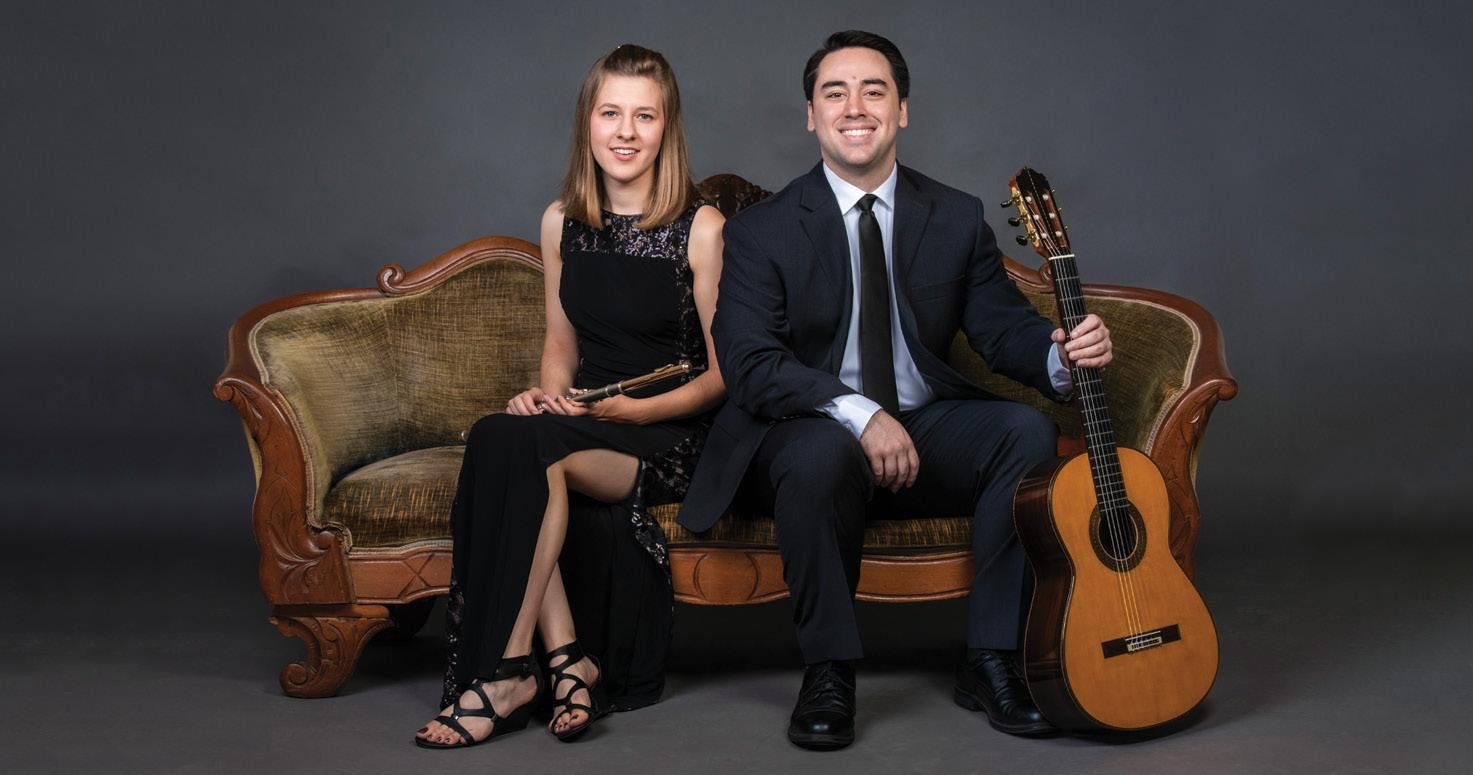
Students Visit U.N. for Holocaust Remembrance
The Loomis Chaffee students sat about six or seven rows back in the General Assembly Hall of the United Nations in New York, witnesses to a unique history lesson as the United Nations observed International Day of Commemoration in memory of the victims of the Holocaust.
The event on January 26 included multiple speakers, from U.N. Secretary General António Guterres to two sisters, Edith Tannenbaum Shapiro and Selma Tannenbaum Rossen, who survived the Holocaust.
“All of the speakers were really interesting,” sophomore Aster Conway-Reppert reflected. “I think the ones that spoke to me were the two sisters. It was so heart-wrenching; they told us there were 1,000 people in their town who were Jewish, and after the Holocaust there were 100. There were only four kids, and they were two of the kids left. I have a twin brother and to think about that ... They said their dad wrote them a letter as he was getting older saying if they had been caught by the Nazis, their parents would have poisoned them with cyanide so they would not have to go to the death camps. Just the thought that the parents had to think about that and then
the children had to know it — it was a lot.”
The trip for the group of 14 Loomis students was a joint effort of the Norton Family Center for the Common Good; the History, Philosophy & Religious Studies Department; and the Jewish Student Union. While in New York, the group also took a guided tour of the Jewish Museum. Faculty members Matt Kammrath, the Keller Family Director of the Norton Center; Lillian Corman, the associate director of the Norton Center; and Eric LaForest, head of the History, Philosophy & Religious Studies Department, accompanied the students on the trip. Funds from the Rubenstein Family Holocaust Education Fund supported the trip. The fund, established by Richard ’65 and Lea Rubenstein, supports the education of Loomis Chaffee students on the horrors of the Holocaust.
Sophomore Sophie Singer said she was struck by the reality that survivors of the Holocaust “will not be around for very much longer, and it concerns me that their truth might fade, get twisted, or even forgotten.”
One of the students who helped plan the trip was sophomore Shane Lischin.
“The journey began as a small group of students brainstorming how to effectively utilize the [Rubenstein Family Holocaust Education Fund],” Shane said. “We wanted to create something impactful and educational, not just for ourselves but for our peers as well.” Their idea gained momentum with guidance from the Norton Center and Eric LaForest, he said.
“It felt like we were part of something much larger than ourselves,” Shane said, “a global community dedicated to remembering the past and shaping a better future.”
One of the lessons Sophie took away from the tour of the Jewish Museum was how the meaning behind a symbol can change. “We were shown a large yellow Star of David, which in World War II was used as a target to take away the humanity of Jewish people. However, in this display it was a symbol of strength and power through its size and place in the museum.”
Shane said the trip was one of his most memorable experiences as a Loomis student, and it “reinforced the idea that we, as students, have the power to initiate meaningful change and contribute to important conversations.”
loomischaffee.org 9
ISLAND NEWS
Loomis Chaffee Hosts AI, Wellness, Sustainability Events
Over the course of three months this winter, Loomis Chaffee hosted conferences for independent school teachers and administrators on three topics at the forefront of education today: generative artificial intelligence, physical and mental wellness, and sustainability.
The well-attended conferences provided space and time for school community leaders to consider these complex topics, learn from experts, and share ideas and experiences with each other. Attendees at each of the conferences said the exchange of information and the sense of camaraderie energized and encouraged them for the work ahead at their schools.
Second AI Symposium Another Success
The more we can learn from each other the better, says Sara Deveaux, the director of Loomis Chaffee’s Kravis Center for Excellence in Teaching.
That maxim has always been accepted in the teaching world, but with the advent of generative artificial intelligence tools like ChatGPT, the stakes seem higher. No one knows exactly where AI will lead, so trying to figure out the relationship between AI and education needs as many minds as possible.
“We have to work together on this,” Sara said. “Sharing wisdom is so important.”
Sharing wisdom is exactly what took place on December 4, 2023, as Loomis and the Kravis Center hosted their second AI symposium for independent schools with about 85 people from 35 schools attending. LC held the previous symposium in April 2023.
“If there is something I have learned in the year-plus this technology has been in the public conversation, it is that there is no shortage of surprising ways you can use the tool and no shortage of things to be aware of,” said Assistant Director of the Kravis Center for Academic Technology Matt Johnson. “It is important we do not silo ourselves at this
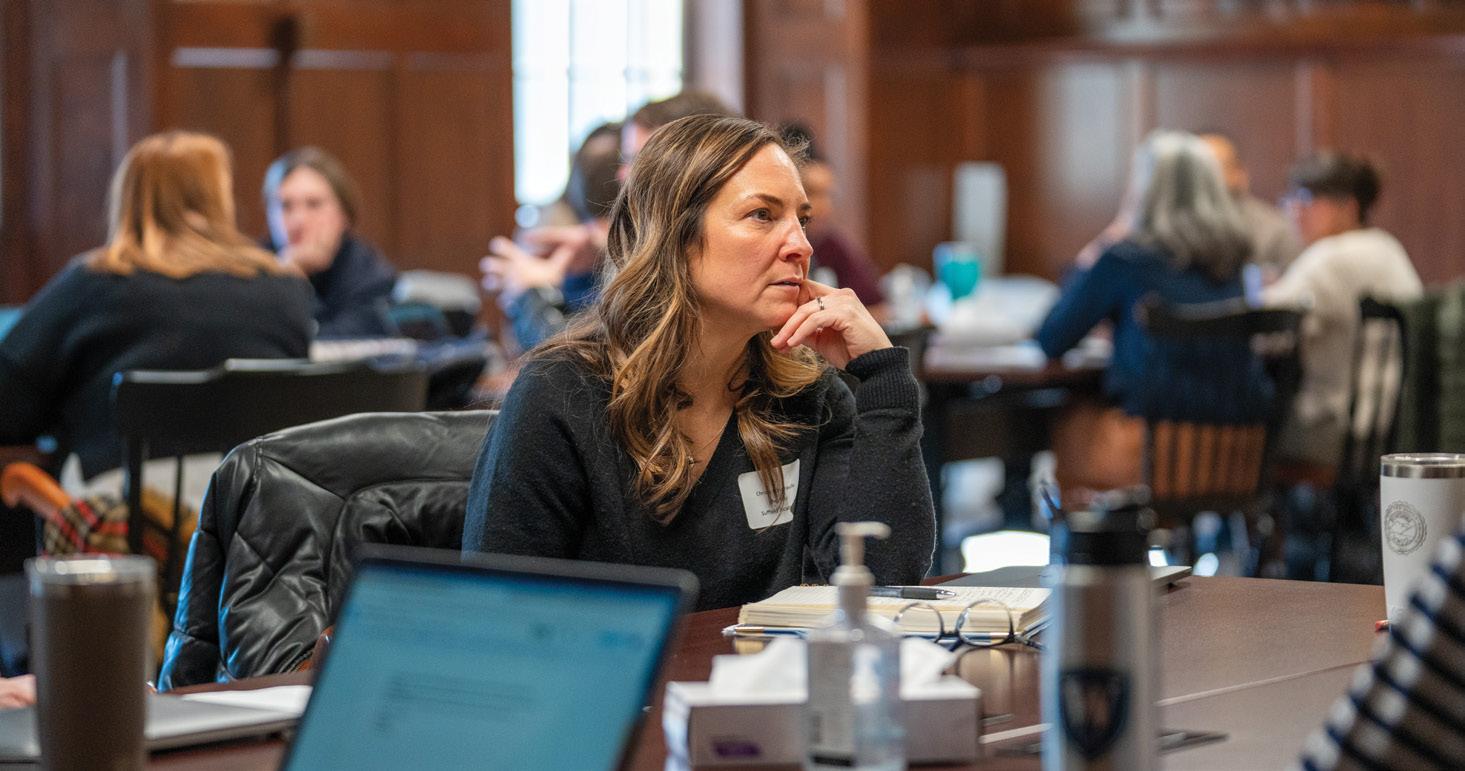

moment, that in fact we live our mission: best self, common good. I think Loomis Chaffee is trying to be our best self in response to this technology and also recognizes that we play a role in serving the common good of our peer schools.”
The symposium was a combination of case studies and workshops facilitated by faculty and others from Loomis Chaffee and peer schools. Topics ranged from “Common Ground Amid Shifting Norms: Fostering Community Discussion about AI Literacy and Academic Integrity” to “Supporting, Not Supplanting, Student Thought” and “Working with AI Interns.”

Wellness Summit: A Time to Share, Learn
The idea started small. Let’s get a few colleagues together to talk about wellness. But it quickly developed into something much bigger because wellness and mental health are a top priority for adolescents in today’s world.
“There is a real need to talk about it,” said Jess Matzkin, Loomis Chaffee dean of student life and wellness and one of the organizers of the event along with Chris Howes, the director of student wellness at Tabor Academy; and Julie Field, Loomis Chaffee’s director of counseling. They knew
Top: Teachers and administrators from 35 schools attended the inaugural Independent Schools Wellness Summit at Loomis Chaffee, which included discussions and workshops like this one in Founders Lounge. Bottom left: Director of Innovation Scott MacClintic ’82 leads a workshop in the Pearse Hub for Innovation (PHI) during the AI Symposium. Bottom right: Mathematics teacher Adnan Rubai leads a session of the AI Symposium.
10 Loomis Chaffee Magazine Spring 2024
ISLAND NEWS
there was a yearning for such a collaboration. The inaugural Independent Schools Wellness Summit took place on February 21 on the Island with about 90 people from more than 35 independent schools attending.
“The world today is so much more complex, and our adolescents are facing a very different set of circumstances than we did,” Jess said in an interview before the summit began. “It's a super complex world for teenagers with technology and social media and [fewer] personal connections than there used to be.”
Interest in and attendance at the summit reflected the immediacy of the adolescent mental health crisis. It also was a hopeful sign that the culture around wellness and mental health is changing for the better. “There are so many good things happening but not a lot of opportunity for us to come together to talk,” Jess said. “COVID was a major wake-up call for mental health in our adolescents, and I think a benefit has been a reduction in stigma around getting help. I think it is easier for schools now to talk about how to take care of one another.”
her presentation at the workshop in Gilchrist Auditorium.
Ms. Cloud is the founder and president of the Cloud Institute for Sustainability Education. The workshop attracted educators and students alike. About 50 people from 10 independent schools attended the joint effort by Loomis and the Global Education Benchmark Group (GEBG), which supports school initiatives surrounding global perspectives and issues. Director of Operations Elsie Stapf represented GEBG.
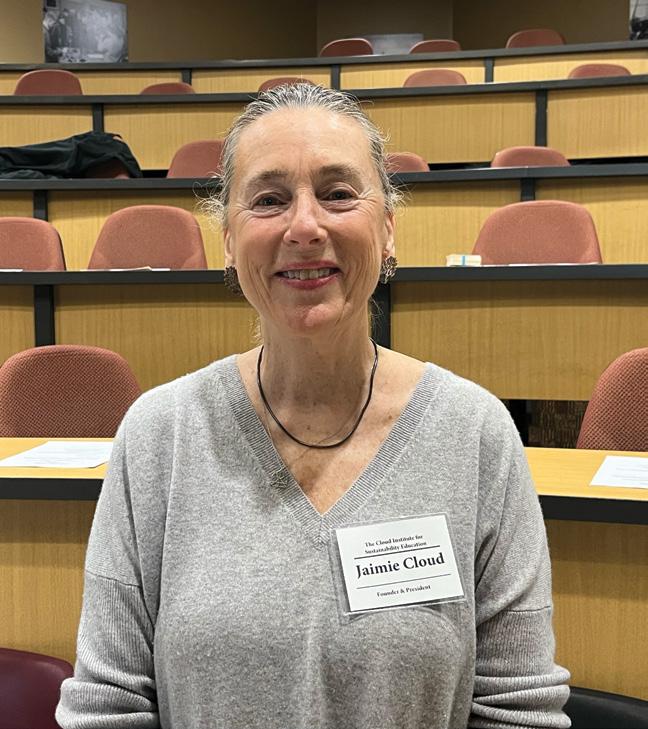
“We wanted to run a workshop on educating for sustainability because we see that when people think about sustainability, they only think about gloom and doom,” said Marley Matlack, the Christopher H. Lutz director of Loomis’ Alvord Center for Global & Environmental Studies and a GEBG globaleducator-in-residence.
“So the focus is to not think about the gloom and doom, but to empower students with new techniques, models, ways of thinking so that we can truly address sustainability.”
Students Experience The Gilded Age
For one afternoon this winter, Founders Lounge was late-19thcentury New York City, and Loomis Chaffee U.S. history students were its denizens, ranging from a political boss to a sweatshop owner to a Black farmer to an Eastern European Jewish woman. The students had stepped into the Gilded Age, and now they had to figure out how to get ahead in the world.
The activity was the Gilded Age Game, and by playing it, the students experienced aspects of this dynamic era of American history in more immediate ways than traditional readings could convey.
Created in 2018 by history teachers Eric LaForest and J.R. Zavisza, the game focuses on New York City because of the city’s dramatic changes during this period. From 1870 to 1900, the city’s population grew from almost one million to 2.5 million. Life in New York also reflected larger national themes during this time, including trends in immigration, industrialization, urban growth, and integration of millions of formerly enslaved people into society.
The day’s schedule included two outside speakers followed by breakout sessions, many of which were led by members of the Loomis community. Much of the day’s programming encouraged attendees to converse, share information, voice concerns, and seek possible solutions.
Sustainability Workshop Attendees Go Fishing for Answers
A Sustainability Education Workshop hosted by Loomis Chaffee on February 22 was a one-day event, but the knowledge gained just might provide an impetus for a lifetime of change.
“I want people to know we can turn the ship around, that it is totally possible to move toward a sustainable future, that it is going to require a different way of thinking, which will then drive a different kind of behavior and lifestyle, which will ultimately lead to kinds of results that we want,” Jaimie Cloud said in an interview shortly before she began
Ms. Cloud led attendees through “The Fish Game,” an activity in which groups try to figure out how to work together to fish for swordfish without depleting the resource. There were many lessons in the game, including the understanding that people need to work together for a sustainable future and the recognition that short-term greed leads to long-term failure.
In the afternoon, attendees explored some sustainability initiatives on campus. Alvord Center Associate Director Jeff Dyreson led the way to the LC solar field and talked about the metrics the school uses to calculate its annual carbon footprint and how Loomis incorporated sustainability initiatives into its curriculum. Another option, led by Alvord Center Associate Director Sarah Griggs, was a visit to the school’s maple sugaring and apiary programs and discussion of the ways that Loomis incorporates them into the curriculum.
“J.R. and I designed the game as a disruption of the typical teaching approaches to the Gilded Age,” Eric said. “We also wanted to emulate games that [longtime former history teacher] Mark Williams had shared with students over many years here. The game is an attempt to introduce race, class, and gender as categories of analysis for this transformational time period in American history.”
Each student was assigned to play one of the 20 possible characters in the game. As the game progressed, the students milled about in Founders Lounge in their roles. “The specific goals of the game differ for each character, though every character is looking to get ahead in some fashion,” according to the game description. “Some characters seek to build fortune, or seek to elevate their status, or seek to become happy or, perhaps, two of the three or all three.”
Junior Eli Krasnoff played the role of a radical reformer. “My job was to get some
continues on page 18
loomischaffee.org 11
Above: Jaime Cloud, founder and president of the Cloud Institute for Sustainability Education, before her keynote address in Gilchrist Auditorium during the Sustainability Education Workshop
Blazing a Trail for More Women in Science
Mireya Mayor, the daughter of Cuban immigrants, grew up in Miami, and her mother was protective of her only child, thinking Girl Scouts was too dangerous. Little did her mother know what her daughter would do as an adult.
All these years later, Ms. Mayor has slept in tents on the side of a mountain, been charged by gorillas and chased by elephants, and has ventured into some of the most remote areas of the world.
She is a primatologist, author, television host, the first female field correspondent for National Geographic, and the director of Exploration and Science Communication at Florida International University.
In December 2023, as part of the Hubbard Speaker Series, Ms. Mayor was the guest speaker at an all-school convocation at Loomis Chaffee. The school theme this year is “The Wonder of the Natural World,” which Ms. Mayor has experienced around the globe, from the Amazon to Madagascar, where in
2001 she discovered a new species of lemur, considered the smallest primate in the world. The mouse lemur’s territory is now a protected space.
Ms. Mayor spoke of her career path and many of her explorations with video and photos augmenting her talk. After the convocation, Ms. Mayor also met with a College-Level Environmental Science class.
Before the convocation started, Ms. Mayor said she hoped the students “would be inspired to care just a little bit more about the planet, but also there is a deep message about following dreams and not giving up that is important.”
Ms. Mayor’s background includes being a former cheerleader for the Miami Dolphins, a mother of six children, and a pre-law major at the University of Miami. She needed to fulfill a science requirement for her degree at Miami, though, and when her first choice wasn’t available, she signed up for an anthropology course. “We started learning about endangered primates on the verge of

extinction and it captured my attention,” she told the students.
Ms. Mayor ended up majoring in anthropology and philosophy at Miami, where she earned a bachelor’s degree. A Fulbright Scholar and a National Science Foundation fellow, she earned a doctorate in anthropology from Stony Brook University in New York in 2008.
She had always loved animals. “My house was basically a zoo growing up,” she said. “Dogs and cats and birds and of course my pet chicken Marguerita. And I collected all sorts of creepy crawlers and chased lizards, but it wasn’t until college that I realized this could be a career.”
After having her first child, who is now 18 years old, she questioned her career choice. This time, her mother, who had once thought Girl Scouts was too dangerous, gave Mireya the encouragement she needed.
“My mom said, ‘You go back out because [being a primatologist] is not what you do, it is who you are,’” Ms. Mayor recalled.
One could also call her a difference maker, which is reflected in another story she told at the convocation.
“If you make a positive difference, you can not only make a positive change in the world, but you can influence someone else too,” she said as the photo of a young boy appeared behind her. “I realized that in Madagascar most kids had never seen a lemur before or been in the rain forest. And how are you going to really want to protect something you don’t know? … When you know something, you can love it, and when you love it, you want to protect it.”
She arranged for field trips from the villages into the rain forest so children could take part in the scientific process.
“This little boy fell in love with this work and grew up to be one of the top national park directors in Madagascar,” she said.
ISLAND NEWS
12 Loomis
Magazine Spring 2024
Above: Primatologist Mireya Mayor connects with senior Nana Achiaa Donkor after the convocation in the Olcott Center.
Chaffee
Turning Dreams into Reality
Btouly Camara never wants young girls to look in a mirror and see limits. She wants them to see possibilities.
When she shared her life story with Loomis Chaffee students in February at an all-school convocation in the Olcott Center, she talked about the power of education, being authentic to oneself, and building community wherever you go.
Ms. Camara herself once stood in front of a mirror and saw what she could become, she recounted in a TedX talk. She had been spurred on by seeing women working hard, playing a sport, experiencing joy.
She could not have known all she would accomplish early in life, but that is understandable. The list of achievements seemingly runs the length of a basketball court for the 27-year-old.
A former professional basketball player in Spain, she previously played on the University of Kentucky and the University of Connecticut women’s basketball teams and, before that, at Blair Academy in New Jersey, where she later coached basketball. She earned a bachelor’s degree in sports management from UConn in 2019 and a master’s degree in 2020, and she is now a doctoral candidate in UMass Amherst’s Sport Inclusion program. Author of A Basketball Game on Wake Street and founder of the nonprofit Women and Kids Empowerment (WAKE), she was named a 2021 Forbes Sports 30 Under 30 honoree and won the Billy Jean King Youth Leadership Award at the 2020 ESPYs.
Ms. Camara started college at Kentucky and transferred to UConn after one year. Both schools, among others, had recruited her out of high school.
“Playing at UConn made me a really resilient person and a thoughtful person,” she said in an interview before the convocation. “I had great teammates and was in a great environment with coaches who took the time to develop us as people and who were very intentional about that.”

“In the middle of all this noise in the world, try to find what’s real, what’s right, what’s true.”
— BATOULY CAMARA
In 2017 Ms. Camara went to her parents’ home country of Guinea to run a basketball camp. “Every single day,” she told those gathered for the convocation, “more and more girls showed up.”
One girl showed up early and would be the last to leave. She told Ms. Camara that she, too, could play for UConn.
“Of course, you can,” Ms. Camara said.
“I just need the tools,” the young girl said. “She was 9,” Ms. Camara said, “and reminded me of my 11-year-old self.”
A little girl with a dream, seeing what she could become. Ms. Camara said she felt a responsibility to help make those dreams come true, so she established WAKE, a United States-based nonprofit supporting girls’
educational and social development needs in New York City and Guinea. To date, WAKE has built two basketball courts in Guinea serving more than 1,000 students daily. An all-girls boarding school in Guinea is being planned.
Loomis students played a role in WAKE’s early success. Students in the Design Thinking for the Common Good course worked with Ms. Camara in May 2020 to develop ways to expand WAKE’s reach through social media.
At this winter’s convocation Ms. Camara left her listeners with this message: “In the middle of all this noise in the world, try to find what’s real, what’s right, what’s true. You’re an amazing community, so enjoy every second of it.”
She also encouraged the students to help others. She alluded to an adage that has been attributed to various people, including Shirley Chisholm, who in 1968 became the first Black woman elected to Congress. “Service is the rent you pay” for your time on earth, Ms. Camara said, “and I hope you choose to spend that time very wisely.”
loomischaffee.org 13
NEWS
ISLAND
Above: Former UConn basketball player Batouly Camara, who founded the nonprofit Women and Kids Empowerment (WAKE), addresses the school community in the Olcott Center. WAKE supports girls’ educational and social development needs in New York City and Guinea.

Magazine Winter 2024
Loomis Chaffee

Chicago, the Roaring Twenties, a time and place when stardom and infamy went hand in hand, and cheating could get you anywhere. So read the playbill for the Loomis Chaffee production of Chicago: Teen Edition. The Norris Ely Orchard Theater production played to a full house from February 14 to 17.




loomischaffee.org 15
Opposite page: Billy Flynn (senior Jonathan Sullivan) and the ensemble proclaim “All I Care About Is Love.” Left: Amos Hart (senior Brigham Cooper) and Billy Flynn hatch a plan. Middle: Mary Sunshine (senior Angela Adu-Boateng), far right, and a gaggle of other reporters collect scandalous news in “We Both Reached for the Gun.” Right: In “Cell Block Tango,” Velma Kelley (sophomore Sonia Barinskaya) and her jailed companions recount their murderous acts from their own perspectives.
The Backstory
Maurine Dallas Watkins (1896–1969), an American playwright and screenwriter, worked for a time on the courthouse beat for The Chicago Tribune. That gave her material for her most famous play, Chicago (1926). It became a silent film in 1927, a talkie starring Ginger Rogers in 1942, and then a Broadway musical in 1975 by Bob Fosse, who won a record eight Tony Awards for choreography.

The Visit
Carolyn Kirsch, who once played Velma Kelly in Chicago, came to the school on February 12 to talk to the cast and crew. She sat at the edge of the stage, fielding questions from the students and captivating the group with stories of a career that included 15 Broadway productions.
Ms. Kirsch was insightful, entertaining, funny, even a bit sassy, somewhat like the musical itself. She even brought some props with her — bowler hats and canes — and at the end posed for photos with the Loomis students. She was clearly in her element.
“For a short period, I wanted to be a fireman, but that evaporated when I got my first tutu,” she told the students. “Firemen didn’t wear tutus.” There was no dousing the passion inside her for what she really wanted to do. “I didn’t have a choice,” Ms. Kirsch said. “I was really driven and that has remained. I still am. I was happy as a clam to come up here and talk to you. I love to be in a theatrical environment.”
Theater Director David McCamish has known Ms. Kirsch since 2007. “We taught alongside each other for a number of years at Wesleyan University’s Center for Creative Youth,” David said. “I was honored to be her fight choreographer in her first Shakespeare performance and thrilled to perform with Carolyn in a production of Hamlet.”
Epilogue
“I am so appreciative how the students came together as an ensemble to create our story of Chicago. I am thrilled with the growth of each student within the role or roles that they undertook. Our seniors’ leadership was as stellar as their performances, onstage and behind the scenes.” — David McCamish
Left: Broadway veteran Carolyn Kirsch spent an afternoon with the Loomis Chaffee cast and crew of Chicago before the show opened. Below: From the tech booth, stage manager senior Cameron Rogers writes down lighting and sound cues for the show. Bottom: Roxie Hart (senior Lauren Sonnenfeld) declares her infamy.

BY THE NUMBERS
Cast members, including seniors
Angela Adu-Boeteng, Jason Chen, Lily Clark, Brigham Cooper, Zaylie Gore, Michael Hoffman, Chloe Pendergrass, Mina Ruffle, Lauren Sonnenfeld, and Jonathan Sullivan. The rest were a mix of juniors, sophomores, and freshmen, meaning a lot of talent returns next year.
Members of the pit orchestra, located in the Black Box Theater, with the music piped into the NEO Theater. Five were Loomis students.
Members of the production team, led by David McCamish, Associate Director Will Eggers, Music Director Melanie Guerin, and Choreographer Kate Loughlin.
Members of the technical crew, including senior Nessa Tang.
Show week tech runners, including senior Andrew Dao.
Members of the workshop build crew, including seniors Audrey Hall and Michael Hoffman.
Stage management: seniors Cameron Rogers, Jamnia Ai, and Sophia Li.

16 Loomis Chaffee Magazine Spring 2024
21
11 6 6 4
14
3
There’s Always More to the Story
Glitter has a way of getting into everything. For neat-niks, the sparkly stuff is a blight that can never be fully eradicated from the playroom carpet. But for writers, it turns out, glitter is an inspiration, as Loomis Chaffee student writers discovered this winter.
Katharine Brush, the well-known author for whom the school’s Katharine Brush Library was named, wrote a novel titled Glitter Goodreads describes the novel as “diving into the sparkling world of the 1920s” and a story that “captures the essence of an era defined by its unapologetic glamour and social changes.”
Inspired by the book title, this year’s Katharine Brush Flash Fiction contest at Loomis used glitter as its theme. Students were challenged to write, in 1,000 words or fewer, about glitter in whichever way their imaginations took them. “The enduring presence of glitter in contemporary life attests to its timeless appeal, as material, as verb, and as metaphor — an art supply thrown by fistsful at parades, a description of light on the surface of a gemstone, or a figure of speech for the hollow promises of show business,” notes the contest prompt. Twenty-one students entered the contest this winter, and the winners were to be announced after this issue of the magazine went to press.
Glitter also was the catalyst for — and the title of — a book by Nicole Seymour, a Cal State Fullerton professor who works in the environmental humanities and who spoke to students on the Island in January. More than 100 years after the Katharine Brush novel was published, Ms. Seymour authored a nonfiction Glitter in 2022 as part of a series called “Object Lessons,” billed as books by various authors “on the hidden lives of ordinary things.”
“I had just finished an academic book that looked at how artists and activists were employing modes like humor and playfulness to draw attention to environmental problems and trying to avoid the doom and gloom and kill-joy environmentalism we are familiar
with in the mainstream,” Ms. Seymour said.
At that time, she said, she was seeing an increasing number of articles describing how terrible glitter is for the environment and calling for glitter to be banned.
“Here we go again with gloom and doom. You know, every little thing we find out is bad and we can’t enjoy it anymore,” Ms. Seymour said. “I also like glitter, felt almost protective of glitter.”
She wondered if this source of bling was as bad as people were saying.
“It felt so random and targeted, so I decided to look into it more,” she said. “Sure enough, it is estimated that glitter makes up 1 to 2 percent of the pollution in the ocean, so 98–99 percent is coming from other sources. Tires, clothing, plastic packaging, so I kind of became a glitter apologist.”
When she spoke in Gilchrist, an event that was co-hosted by Writing Initiatives and the Alvord Center for Global & Environmental Studies, Ms. Seymour encouraged the students to think critically.
“There is always more to the story, there is always something deeper, there are always
connections,” she said. In the case of glitter, she drew connections to gender and the environment. “Glitter tends to be associated with girls and women and LBGTQ people, so one of my ideas in the book is that the backlash against glitter can’t be separated from that association. There might be something discriminatory there, probably not intentional.”
She advised the students to consider cultural assumptions that might be behind any news article or information and “links between things that don’t seem to go together like gender and the environment or sexuality and the environment.”
Ms. Seymour has published four books. Glitter took about 18 months. “I felt like I approached the book in a way that glitter is a beautiful object, and I wanted the writing to be beautiful. I got a little carried away,” she said with a laugh, “being more poetic and using alliteration that I probably wouldn’t do in academic writing.”

As for what glitter-inspired creative expression sprung from the pens — or keyboards — of Loomis Chaffee student writers this year, we’ll have to wait to see the results of the 2024 Katharine Brush Flash Fiction contest.
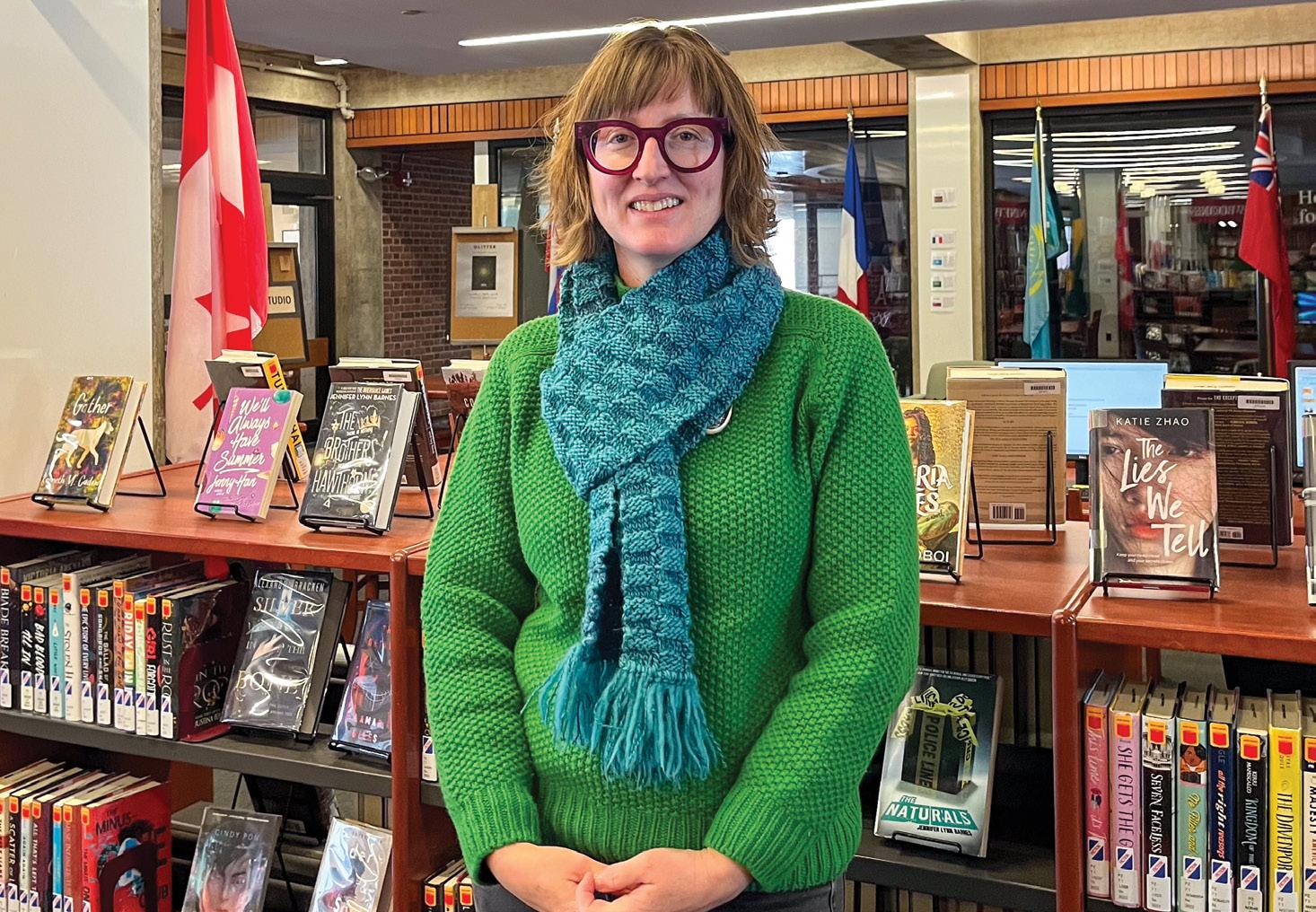
ISLAND NEWS
Right: Author Nicole Seymour in the Katharine Brush Library
Faculty and Staff News
Science teacher and head of Flagg Hall Hannah Insuik and her husband, Duncan Sewall Insuik, welcomed their son, Jaime Quinn Insuik, on January 17.

Math and science teacher Grant Gritzmacher (above) and his Americana and indie folk band, Firetown Road, released their first album, “Here’s to This Life,” on music streaming platforms in February. The album features Grant’s vocals and songwriting and his bandmates’ talents on piano, bass, drums, and saxophone. Several of the album’s 15 tracks also feature fiddle played by Dean of Academics and Curriculum Tim Lawrence.
The Gilded Age
continued from page 11
anarchy going among the working class of New York to disrupt the upper class that seeks to oppress us. To form unity in the working class so they know they are empowered. Get their status up, their happiness up, and lower the amount of their working hours while getting more pay. One thing I learned is what really drives people,” Eli reflected.
Junior Katie Sigrist played a role with power. “I’m a political boss, so I get to
“Based on the alumni that came back to celebrate him, you can see that he made a lasting impression on every single girl that has been a part of his teams.”
— LIZ BUCCERI ’07
A large crowd gathered at Hedges Pool to honor Bob DeConinck, longtime head coach of the girls swimming and diving team, at the final home meet of the winter season. Bob, who also teaches science and is associate director of studies, will retire at the end of the school year. A number of alumnae swimmers returned to campus for the event. Ed Pond, assistant coach of the boys swim
team and a fellow science teacher, spoke to the crowd about Bob’s coaching career. “Bob deeply loves the sport and cherishes the opportunity to share that passion with athletes drawn to the idea of putting on a Speedo and jumping in a pool throughout the long, dark, cold New England winter,” Ed said. Math and science teacher and dorm head Liz Bucceri ’07, who swam on and captained Bob’s team as a student and has been Bob’s assistant coach since 2012, also shared reflections on his profound impact over the last 26 years at Loomis Chaffee. “Based on the alumni that came back to celebrate him, you can see that he made a lasting impression on every single girl that has been a part of his teams,” she said.
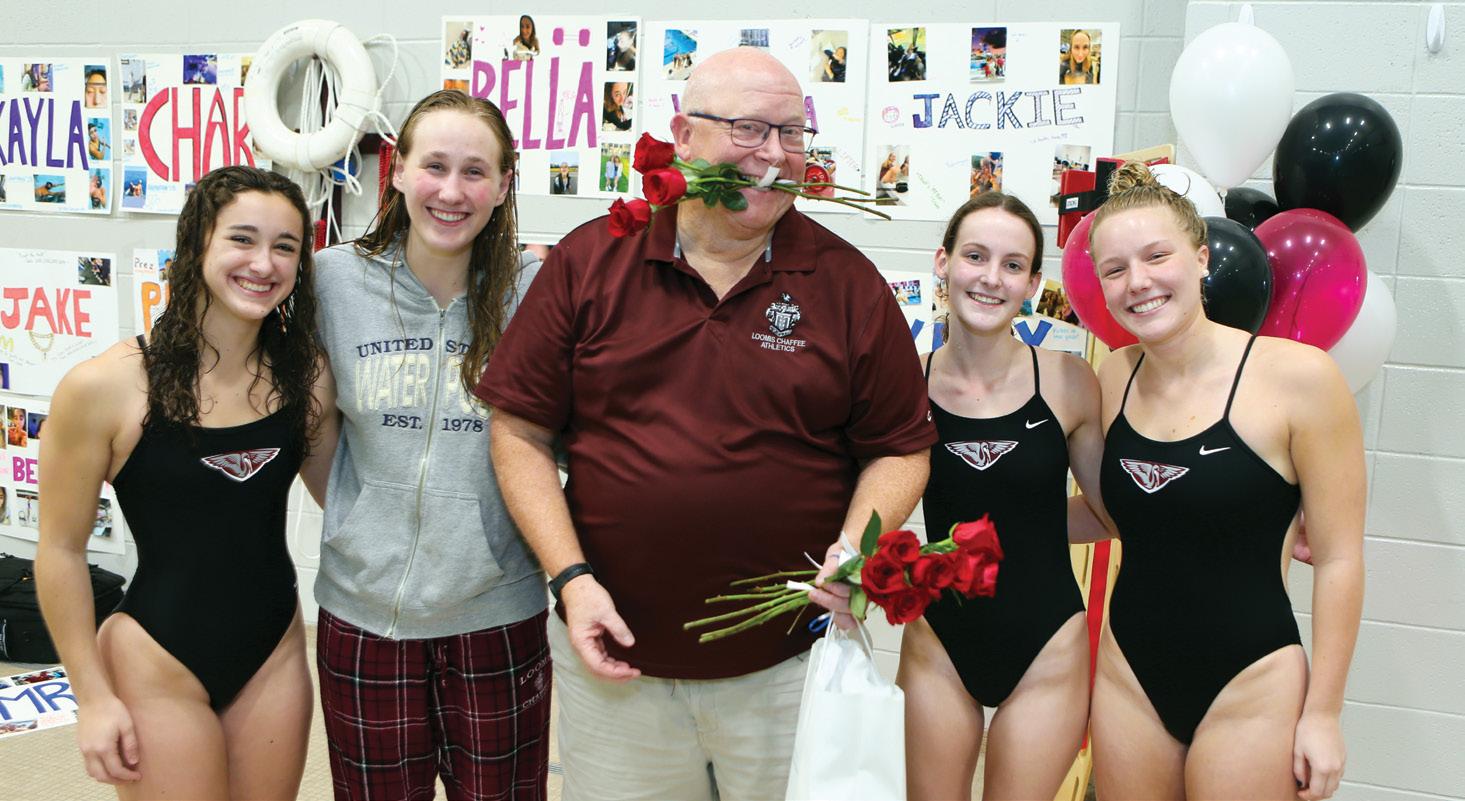
make the deals and be conniving like a political boss would be in the Gilded Age,” she explained. “Doing this contributed to my depth of understanding of this age. It was a lot of fun, super dynamic in that you get to interact with your peers and the characters they are playing.”
Junior Sydnee Denson played a sweatshop owner. “As unethical as that might be, … my character was relatively fortunate because they were middle class,” she said. “I learned how this person is living their life at this time and the gap in wealth.”
In developing the game, J.R. and Eric tried
to create characters who would reflect a variety of societal themes from the era. “We also wanted the game to be true to what each type of person’s real-life options would have been relating to their race, ethnicity, class, gender, etc.,” J.R said. As part of their research for the game, Eric and J.R. spent two days in New York, including meeting with Margaret Kugelman Hofer ’83, then the vice president and museum director at the New-York Historical Society. Once they had written the game, they showed it to Mark (who retired in 2019) for feedback. It was first played in 2019.
ISLAND NEWS 18 Loomis Chaffee Magazine Spring 2024
THAT’S ABSOLUTELY BRILLIANT!
DEBATE
In an extraordinarily successful winter for the Debate Society, eight student debaters qualified for the Connecticut state championship tournament in March. They are seniors Nana Achiaa Donkor and Mike Hoffman; juniors Luke Han, and Julius Kim, and Cindy Lin; sophomores Drew Carmon and Alex Park; and freshman Calvin Weng. By the time the 2023–24 season ends in April, the debate team will have competed in more than 20 weekend tournaments in the two leagues in which it competes, the Debate Association of New England Independent Schools and the Connecticut Debate Association. Among the team’s many successes was a great showing at the 2024 Loomis Chaffee Debate Tournament in January, in which 11 schools competed. At their home tournament, the Pelicans finished first with a 10-2 record. In April, Luke Han is participating in the World Individual Debate and Public Speaking Championships in Canberra, Australia, as a member of the 12-person U.S. delegation. He was invited as a result of his performance at a qualifying tournament in January.
ALL-STATE MUSIC
Thirteen students were selected by audition for the Connecticut All-State Music Festival in April at the Connecticut Convention Center in Hartford. They are sophomore Tristan Buttimer (cello), senior Monica Choi (flute), junior William Chun (viola), sophomore Maleah Cogle (voice, alto), junior Isaac Garcia (voice, tenor), freshman Yoora Jeong (clarinet), senior Max Jiao (clarinet), junior Oscar Kong (violin), junior Kenneth Lee (clarinet), sophomore Matthew Li (French horn), sophomore Deron Lin (violin), senior Jessica Luo (flute), and senior Preston McNulty Socha (voice, alto).
DOUGLASS DAY
Students and faculty gathered to transcribe correspondence and other writings of Frederick Douglass as part of a national transcribe-a-thon on Douglass Day, February 14. Born in 1818, Mr. Douglass was enslaved in Maryland until he emancipated himself in 1838. Mr. Douglass was an orator, author, and activist pushing for racial justice. Douglass Day is celebrated on February 14, his chosen birthday, and helped lead to the establishment of Black History Month. Douglass Day has
given volunteers around the world the chance to transcribe and learn about a specific online collection of Black history and culture. This year the focus was on the Frederick Douglass Papers, which have been digitized and made available through the Library of Congress, which holds the collection. About 9,000 people participated in the transcribe-a-thon at more than 170 sites, including Loomis Chaffee, where the transcription session and celebration was coordinated by LC Writing Initiatives, the Center for Diversity, Equity & Inclusion, and the Katharine Brush Library.
ROBOTICS
The robotics team finished eighth overall at the Connecticut state finals at UConn in February and received the Connect Award for its outstanding community outreach efforts. The team’s outreach has included working with FIRST Lego League teams, mentoring Renbrook School’s VEX Robotics team, and other initiatives. “When the judges gave out the award, they clearly noted that our team’s focus on one-to-one mentorship was something that set it apart from the other teams,” said assistant coach Jen Solomon, a science teacher and associate director of innovation. The robotics team qualified for the state championships in the first event of the season, where the team earned recognition for the innovative design of the claw that the robot used to perform tasks.
BENEFIT CONCERT
The annual Student Council Benefit Concert in February raised money for the Malaria Consortium, a charity organization that works to fight malaria and other communicable diseases in Africa and Asia. Approximately 20 students performed at the benefit in Hubbard Performance Hall, where the high-energy audience sang along and appreciated the performances, which ranged from solo and group numbers to a magic act. Each year the benefit concert alternates between supporting a local charity and a global charity.
SCIENCE TEAM
Two teams of students represented Loomis Chaffee at the Science Bowl at the University of Connecticut in February, and both advanced to the round of 16 from the 40 teams in the competition. Coached by science teacher Koby
Osei-Mensah, the Loomis teams won all of their matches in the round-robin portion of the tournament and moved on to the doubleelimination championship round in the afternoon, where one of the Loomis teams placed seventh overall. The fast-paced, quiz bowl style competition tests students’ knowledge of all branches of science and math.
WOMEN IN TECH AWARDS
Sophomore Judy Kwon won a 2024 National Center for Women and Information Technology Aspirations in Computing High School Connecticut Affiliate Award. She was chosen for her “significantly demonstrated interest and aptitude for computing and technology,” her leadership in the classroom, and her aspirations to use technology in the future to “solve problems and positively impact humanity,” according to the announcement. Senior Zarin Rizvi also earned an honorable mention for this award for her accomplishments in computing and technology.
INTERFAITH PANEL
An Interfaith Panel discussion in February tapped into the diversity of religious faiths and spirituality among Loomis Chaffee community members to encourage students to feel more comfortable asking questions and being curious about these topics. About 30 students attended the discussion, led by Ryan Heckman, the school’s religious life coordinator. The panel comprised faculty members Adam Alsamadisi, Lori Caligiuri, Elliott Dial, David Edgar, Aidan Winn, and Ludmila Zamah. The conversation revolved around questions developed by students in the Religious Diversity in America course taught by Katharine Conklin.
EVENT ON HOMELESSNESS
Sophomore Lilly Oslin led an event in the Norton Family Center for the Common Good this winter to raise understanding of homelessness and unhoused individuals. Through the Faces of Homelessness Speakers Bureau of the Hands on Hartford organization, Lilly arranged for a man named Ralph to come to campus and talk about homelessness, including sharing his individual story. Lilly said she organized the event “to help break the stigma of homelessness.”
loomischaffee.org 19

PELICAN SPORTS

NEW ENGLAND CHAMPS
3-Peat!
The Loomis Chaffee girls basketball team won the New England Prep School Athletic Conference (NEPSAC) Class A championship for the third year in a row this winter, capping off a season that included the Founders League title for the second consecutive year and the best regular-season record in program history at 20-5. The team earned the New England title with a tournament run that included a 65-32 defeat of Andover in the quarterfinals, a 75-51 win over Hotchkiss in the semifinals, and a 47-39 victory over Kent in the championship game on March 3. Junior Abby Congdon was named tournament Most Valuable Player, and head coach Adrian Stewart ’90 was chosen as NEPSAC Class A Coach of the Year.
loomischaffee.org 21
Left: Senior Jess Roy and junior Abby Congdon hoist the NEPSAC trophy as they celebrate with their teammates and coaches. Pictured: assistant coach Chloe Alexander ’12, Jess, junior Alicia Mitchell, senior Ke’iara Odume, junior Catherine Chadwell, Abby, sophomore Lauren Wright, junior Aniyah Neal, junior Tyrah Mack, junior Sam Lehman, junior Liv Westfort, senior Samantha Mancini, and freshman Anna Sigrist.
VARSITY RECORDS
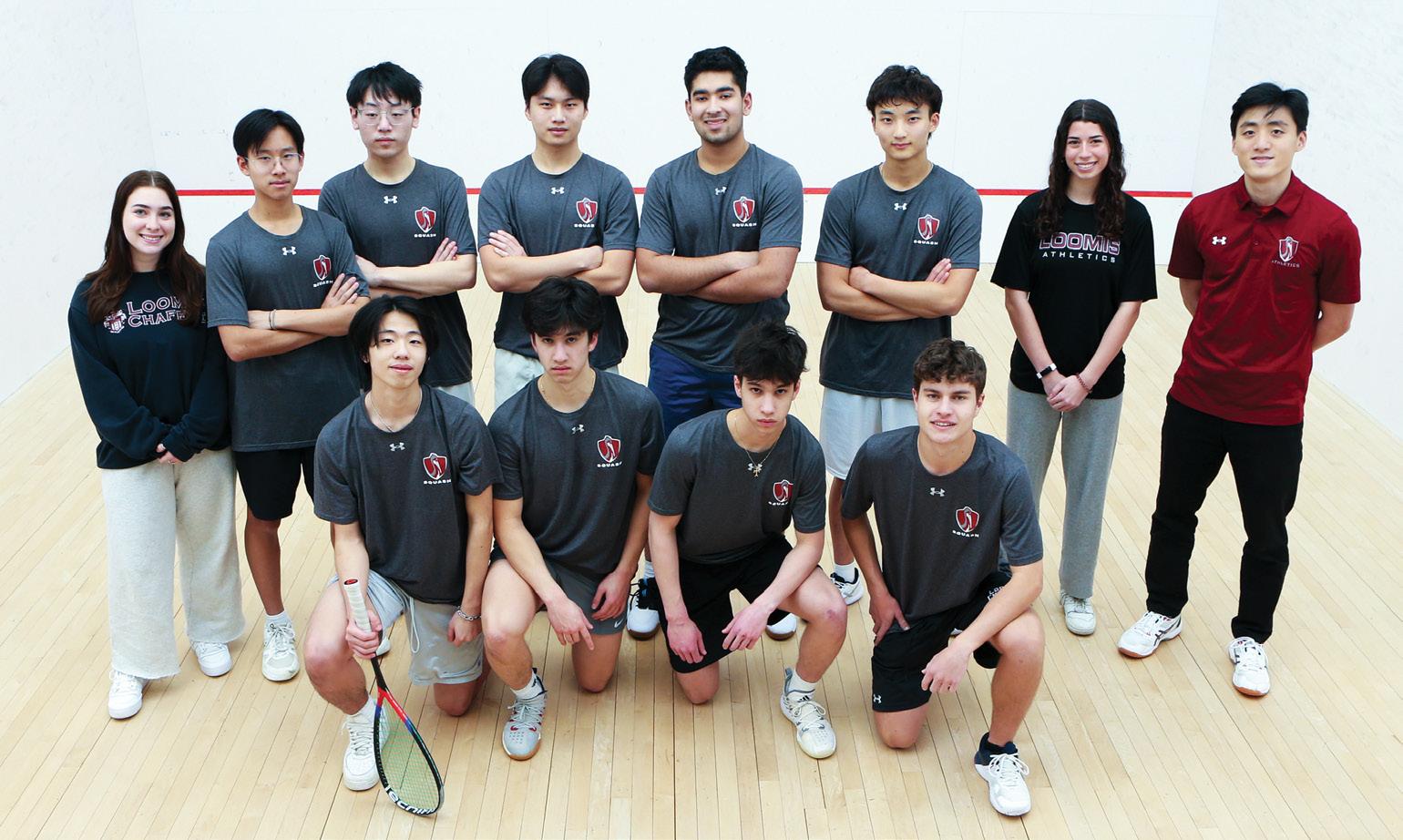
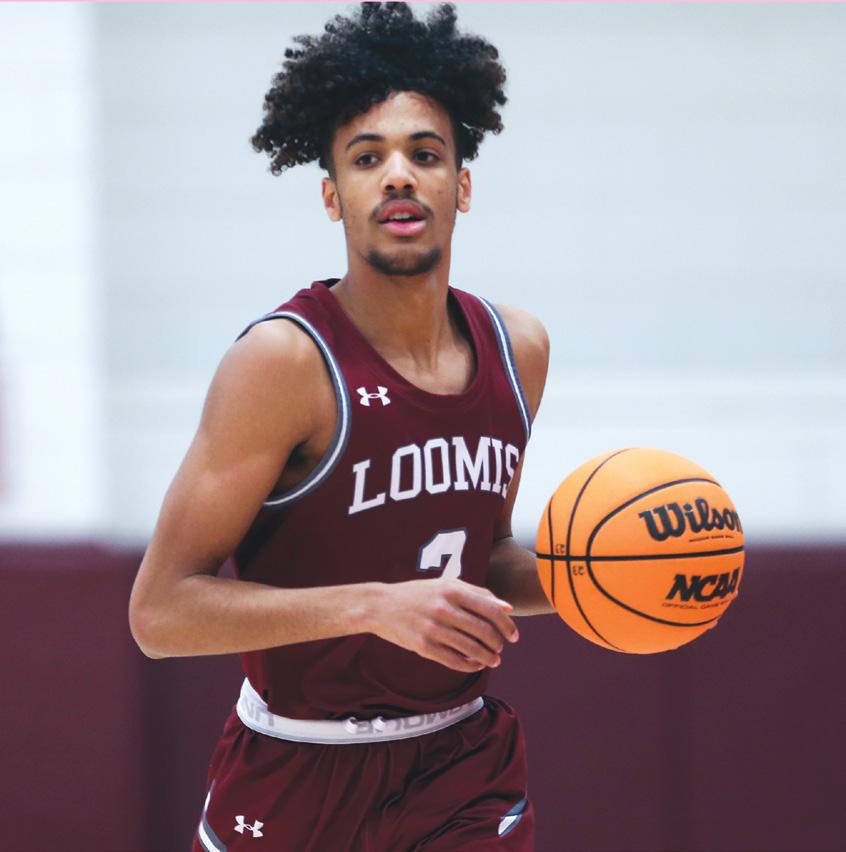
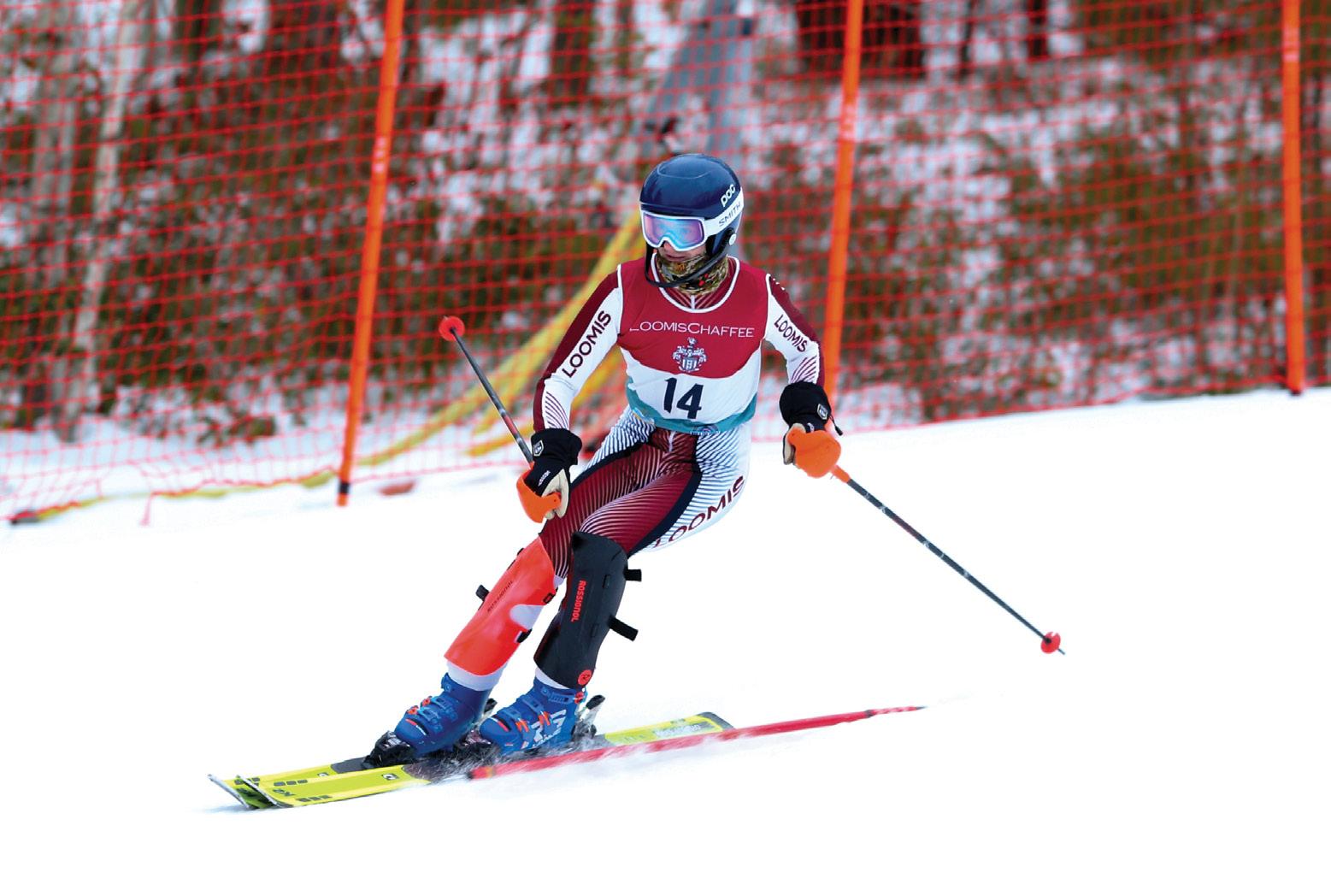
22 Loomis Chaffee Magazine Spring 2024 1: NEPSAC Class C Champion varsity boys squash team and coach David Kim 2: Senior Ben Bradford 3: Senior Simon Vulliez 4: Sophomore Chris Zeng 5: Senior Annie Nichols 6: Senior Bella Flowers 7: Senior Jess Roy 8: Sophomore Jack Daly 9: Junior Chloe Obser 10: Senior captain Leah Ozgun BOYS BASKETBALL 16-9 New England Class A Quarterfinalist GIRLS BASKETBALL 23-5 Founders League Champion New England Class A Tournament Champion CO-ED EQUESTRIAN 4 shows IEA Regional Finals, 4th Place BOYS ICE HOCKEY 14-10-1 GIRLS ICE HOCKEY 19-6-2 New England Chuck Vernon Elite Bracket Semifinalist CO-ED SKIING New England Class B Championships, Boys 11th, Girls 7th BOYS SQUASH 10-7 New England Class C Tournament Champion GIRLS SQUASH 11-6 New England Class B Tournament, 8th Place BOYS SWIMMING & DIVING 5-4 Founders League Meet, 2nd Place GIRLS SWIMMING & DIVING 7-2 Founders League Champion New England Division I Meet, 4th Place 3 1 2

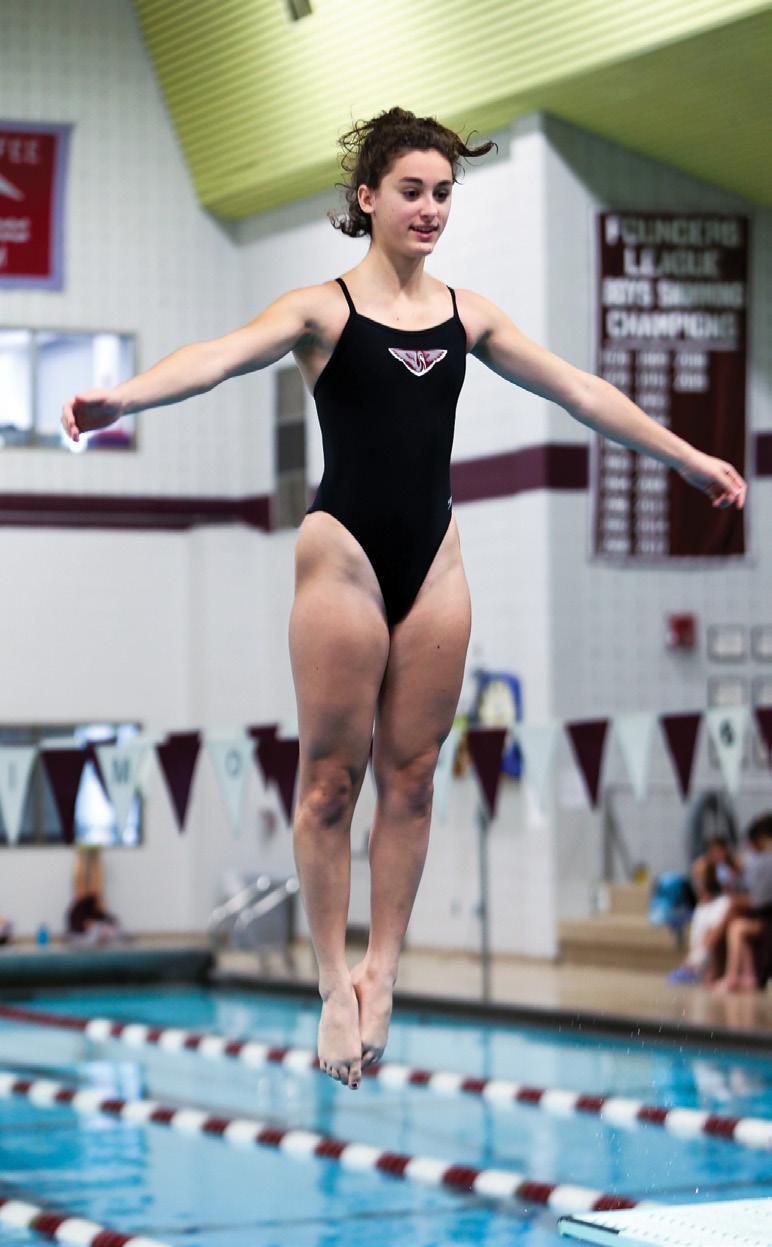

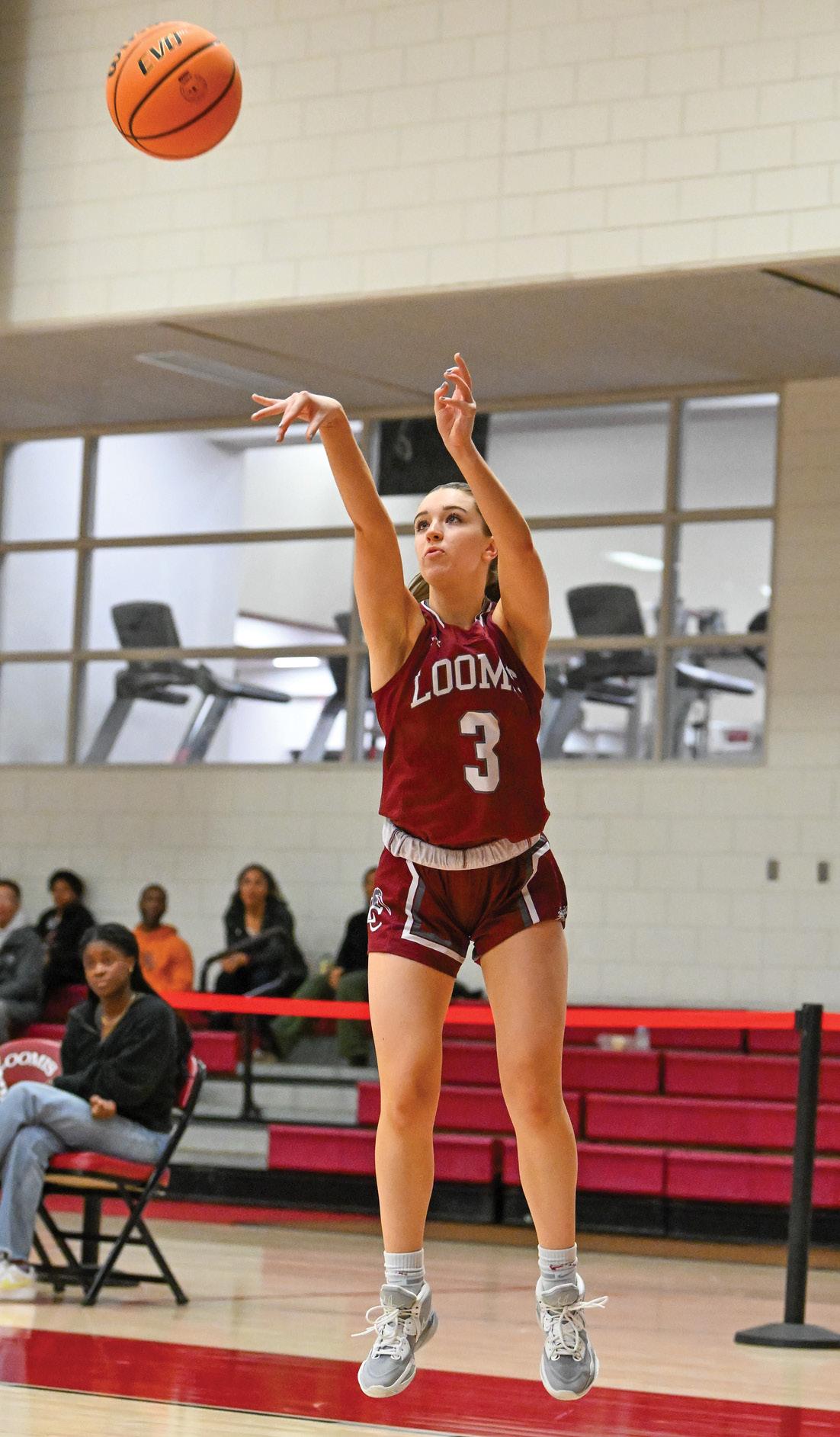



loomischaffee.org 23 8 4 6 7 10 9 5 8
In all areas of Loomis Chaffee, Sheila pushed the school forward. Admissions became far more competitive, dropping the school’s admit rate lower and lower and its yield percentage higher and higher, while attracting more and more highly qualified and talented students. Through the centers and changes in the curriculum, the academic and social lives of the faculty and students became broader and richer. In athletics, Loomis Chaffee became one of the best schools in New England, nearly always appearing in championship draws and winning more Founders League titles than any other member school. In fundraising, the school notched many of its best years in total voluntary support that led to a larger operating budget, to a significantly larger endowment, and to the construction of dormitories and facilities like the Scanlan Campus Center, the John D. and Alexandra C. Nichols Center for Theater and Dance, and The Way. People — alumni, parents, students and prospective students, other schools' administrations and faculties — knew that Loomis Chaffee's increased visibility and strengthening reputation created an upward trajectory outstripping competitors.
—Nat Follansbee, former associate head of school for external relations

24

Sheila Culbert
After 16 years as head of school at Loomis Chaffee, Sheila Culbert will retire on June 30, just over a month after delivering the Commencement address to the Class of 2024. Under Sheila’s leadership, the school has undergone major transformations while remaining true to its founding principles and century of history, as many who have worked closely with Sheila and witnessed her leadership attest — several of whom are quoted on these pages. We sat down with Sheila this winter and asked her to reflect on her tenure as Loomis Chaffee’s seventh head of school.
Vision & Gratitude
Looking Back with Sheila Culbert
By Becky Purdy
Becky: You often talk about the school’s Founders. Was their vision one of the things that drew you to Loomis in the first place, and do you still draw from that?
Sheila: Absolutely. We’ve got an amazing founding story and one that is easy to be proud of. It’s nice that this is not a school that was set up for the elite. This was a school that grew out of tragedy, but one where [the Founders] wanted some good to come from the “harvest of their lives.” That wasn’t going to happen for their children, and so they decided to help other people’s children. The Founders’ story really drew me to Loomis Chaffee, but also the financial aid, that there was such a commitment to financial aid. We found over the years that financial aid is very much in the DNA of our alumni, of our faculty. I’m very proud that if you ask faculty what their priorities are, financial aid will come at the top of the list. That says a lot about the kind of school we are.
There have been many changes in the school during your tenure — the addition of the centers among them. What was your vision for the centers, and how does their operation today compare with that vision?
It started with the Henry R. Kravis ’63 Center for Excellence in Teaching in 2010. With a school like ours, where there’s such an emphasis on teaching and teaching well, it
seemed to me to make sense that we should have a center that was dedicated to excellence in teaching. At the same time, there was a committee that was looking at global education. Global studies is one of those tailor-made areas where it’s so obviously interdisciplinary. It calls for an overarching kind of organization, a place where people from different disciplines could come together. And [former Trustee] Joel Alvord [’56] came forward to say he wanted to fund it. He was really interested in environmental issues. Ultimately, we found a nice synergy between global and environmental studies and the work of the Alvord Center has been thriving ever since.
The Norton Family Center for the Common Good opened in 2012. I had heard that some students had actually come to fisticuffs in the dormitory over a difficult conversation [about world events]. And it occurred to me that we ought to be teaching our students civil discourse, that no matter how strongly we disagree with somebody, a place like Loomis should be a place that allows for difficult conversations to take place in a civil atmosphere. And while that was going on in the classroom, so many important conversations for teenagers happen late at night when there aren’t adults present. I thought that there was room for us to create a place where we could model that
loomischaffee.org 25
kind of debate. And Chris Norton [’76] was chairman of the Board of Trustees at that time and was really interested in this idea, and so the funding came together for that.
The Center for Diversity, Equity & Inclusion is our newest center. The Founders wanted a school that reflected economic, political, and geographic diversity, and our mission has been to support all of our students no matter their background. This has been a priority for the Trustees and the school for as long as I have been here. Given our success with the interdisciplinary centers model, the Center for DEI made sense and allowed us to recommit to our diversity goals and to make sure that we were doing what we said we were doing, that we were living up to our mission. All students, no matter their background, nationality, race, or religion should feel respected and that they belong at the school.
What I was hoping for is that these centers would be able to provide an interdisciplinary umbrella for faculty and students who were interested in some of those edges where disciplines interact with each other. And I think they did that really successfully.
The Pearse Hub for Innovation [PHI] was another big addition to the school. How did that come about?

The PHI really came about from a number of different sources that all came together in a rather wonderful way. Nat [Follansbee, former associate head of school for external relations,] and I had visited a number of schools on our travels and had seen some really interesting maker spaces, and we wanted to incorporate something similar at the school. We were also hearing from some students and parents that our computer science offerings were not sufficient. Finally, the Board of Trustees met at Dartmouth one summer. [Chair of the Board of Trustees] Duncan MacLean [’90] has a connection with the engineering program there, so we spent some time at the meeting visiting their lab spaces and talking to their dean. We had initially thought about transforming the lower level of Brush into a space that could hold a program that had some computer science, some innovation stuff, engineering, robotics — but then the construction of the Scanlan Campus Center provided us with a massive amount of “found space” in the lower level. John [’58] and Sally [’58] Pearse, who had developed a software business and were very interested in innovation, provided funding. It was a lot of the right things coming together to create a wonderfully innovative space.
Has the PHI lived up to what you envisioned it would be?
I have been super impressed with the I-Tri [Innovation Trimester] and its success, also with the number of classes that go there for one thing or another, the innovation classes, and others. And I can imagine all sorts of ways that it will continue to grow. The PHI will continue to evolve depending on the ideas of the faculty who work there.
Another major change during your tenure was the intentional shift in the boarding/day student ratio from roughly 54 percent boarding/46 percent day to 70 percent boarding/30 percent day. How did that come about?
Much of my interview before I even stepped foot on campus was about this dilemma that the school was facing. And so it was very clear that I was hired with a charge, and that charge was to either make the hybrid [boarding/day] model work or to change it. And it was very fortuitous how it all came together. Just before I got here, the school had surveyed parents, faculty, students, and alumni and had a wealth of data that made it clear that the hybrid model wasn’t working for anyone. The students weren’t happy with it. Their parents weren’t happy with it. Everybody thought that the other group had it better. And so I quickly concluded, “All right, so we have to change the ratio.” How do you do that? At the time, the easiest way to do that was simply to get

26 Loomis Chaffee Magazine Spring 2024
smaller as a school. So we said, “OK, we’ll get smaller.” And that was in 2008 [when the global financial crisis hit.] We had less revenue. Our endowment plummeted. We had to cut expenses everywhere. We had to completely restructure the budget anyway. We restructured it with fewer students, and we modeled out what this would look like over a number of years. The initial model was not to increase boarding students because we didn’t have the space to do that, [so we had to] cut [the number of] day students. We were going to go from a school of more than 700 to a school of 650. And we did go down to 650. And then Elizabeth Richmond [’80] and the Richmond family came through with the money for Richmond dormitory, which changed everything. All of a sudden, we had a little capacity.
From the outside, it seemed like the enrollment number just started creeping up.
When we were 650, we realized we couldn’t do what we wanted to do as a school. We couldn’t do it all. We couldn’t recruit the athletes we wanted. We couldn’t recruit the students we wanted. We couldn’t have the musicians that we wanted. So we said, “OK, we have a new dormitory. We can add 50 more boarding students.” And then we weren’t quite where we needed to be, so we were going to put 12 students on the second floor of Gwendolen Hall, where the health
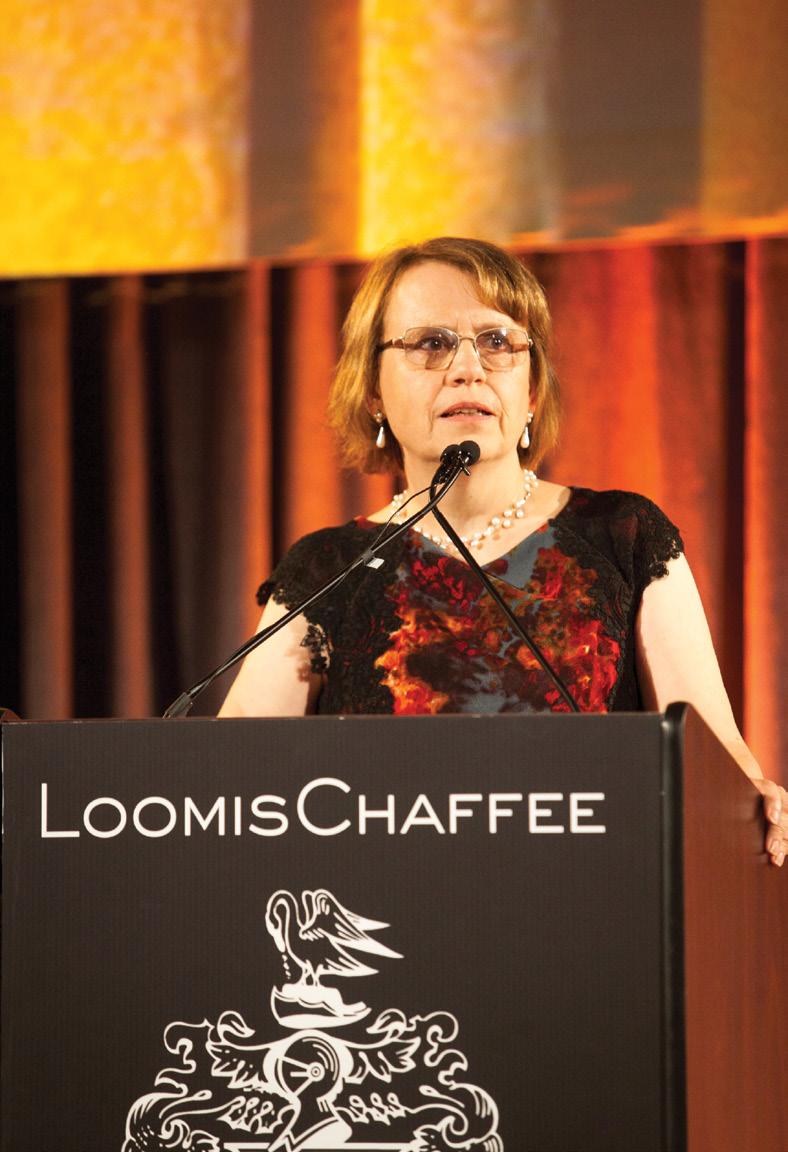

center had been before Richmond Hall was built with the new health center. Then Sandy Cutler [’69] came to us with money for another big dormitory, Cutler Hall. And that allowed us to go back to be at 725–735 students. That’s the number that comfortably fits the faculty and the students we want to have. It’s a good number. So while the impetus was, “We’ve got to get the boarding/day ratio right,” the fundraising allowed us to do it in a different way than we had planned.
Are there other changes at the school that stand out to you?
Well, I think admissions. The admissions numbers are very strong. If you think about the quality of the school today, so much of


that hinges on what the admissions officers do, and it is a virtuous circle. The admit rate my first year was around 45 percent. And today it’s 17 percent. Applications have gone up from about 1,150 when I got here to about 2,500 last year. Yield was 47 percent and is much better, 54 percent, today.
The quality of our faculty and students has only strengthened. I’ve always been impressed with our faculty. I remember from my first interview there was a seriousness of purpose and a commitment to the life of the mind that I was really attracted to. My admiration has grown, particularly after seeing their professionalism and the outstanding work they did during the pandemic. And our students are interesting, committed, passionate, and funny. I have always enjoyed my interactions with them.
Above: Three Loomis Chaffee heads of school: Sheila Culbert, John Ratté, and Russell Weigel
Opposite page: Sheila with Linda Rossi, administrative assistant to the head of school, and Whitby. Linda also will retire this summer after 25 years at Loomis Chaffee. • In her office, Sheila shows Student Council members plans for Richmond Hall in 2012. This page: Sheila addresses the crowd at the Centennial Campaign Gala in Manhattan in 2014. • Sheila greets students at her first address to the school in 2008. • Sheila leads a summer reading book chat. • Sheila with Chief of Staff Mary Liscinsky, her longtime colleague and friend, after Commencement 2023.
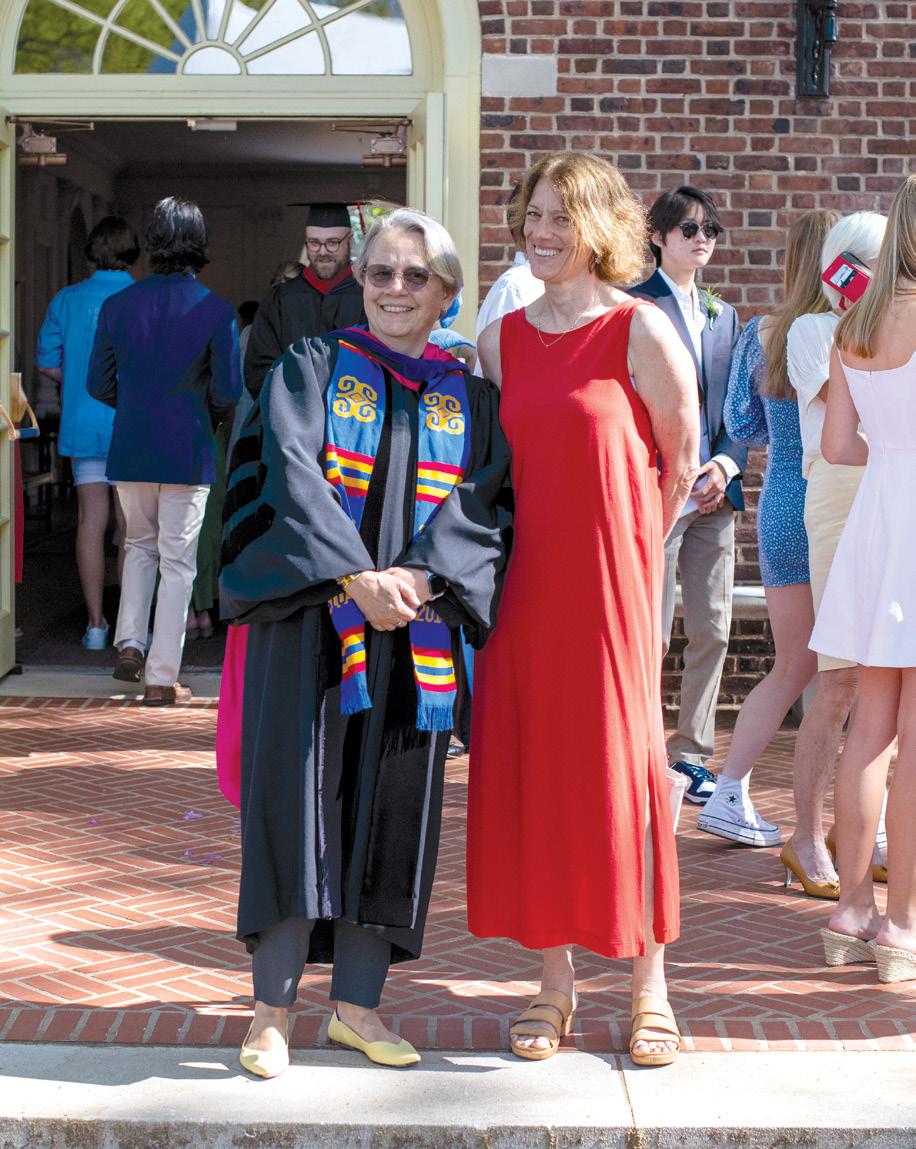
loomischaffee.org 27
Perspectives on Sheila Culbert’s Leadership of Loomis Chaffee


She is a strong leader who builds consensus when necessary, but takes action when necessary. She has had to deal with many difficult issues during 16 years and always found the right path. And you cannot overstate Sheila’s leadership during the pandemic. She was deliberate, clear in her thinking, and decisive in decision-making. The other key thing about her leadership style was the way she put the students first.
Upon first arriving on campus, Sheila began asking questions about who Loomis was and then, what needed to change. It was an exciting time watching her unravel decades of beliefs with a simple maxim, “Why can’t we do things differently?” Sheila’s early days required a certain amount of acceptance from those around her. Pushing an organization to change is never easy. However, I have found that the world steps aside for someone who knows where they are going. Sheila had a vision and we all bought into it.
Leaders are dealers in hope. Sheila has given us a great sense of purpose by opening a conversation around shared values. The world is shrinking and forcing our differences to become more pronounced. Sometimes we feel conflict between our individual beliefs. Sheila has allowed these differences to ferment. Learning to open one’s mind to new ideas and confront a world littered with conflict, breathes life into a community. Through the art of resolution, Sheila has given us all a lesson about respect and dignity so that we each can thrive as individuals.
The arc of history will look fondly upon the memory of Sheila’s tenure. Loomis is more confident, more resilient, and ultimately, a more empathetic institution. I am excited about our future.
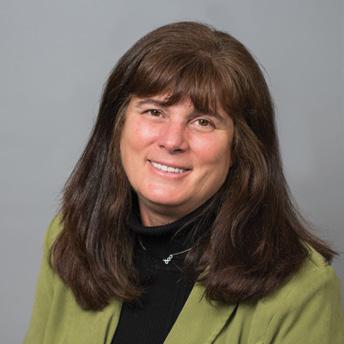
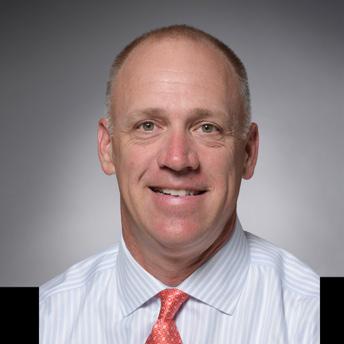
Always keeping the vision of the Loomis family as her true north, Sheila has guided the school into its second century with grace, determination, and a focus for where our students are in this complex new world of technology and innovation. … It will be clear when generations look back at the history of LC that Sheila understood fundamentally that changes in our world should not be ignored or reduced but rather acknowledged, incorporated, and promoted to allow our students to thrive in the face of that change.
It is hard to be succinct in capturing Sheila’s impact on Loomis. There are certainly some concrete changes — facilities enhancements/additions, campus beautification, programmatic additions such as the centers — but so, too, are there some habits of mind that have become ingrained in our community. Some of those that are top of mind for me are a complete dedication to making the student experience as transformational as possible, a campus-wide willingness to be flexible and willing to try new things, and a belief that adults and students alike can (and should) aspire to improve and to get better. … She has been unapologetic about her ambition and aspiration for Loomis, and that has had a profound impact on the school’s trajectory.
Christopher K. Norton ’76, former Chair of the Board of Trustees, parent of alumni
Duncan A.L. MacLean ’90, Chair of the Loomis Chaffee Board of Trustees, current parent
Elizabeth Richmond ’80, Trustee and parent of alumni
Webb Trenchard, Associate Head of School
28 Loomis Chaffee Magazine
And, as I walk through the campus a lot, I think it looks beautiful. And I credit [Director of the Physical Plant] Lance [Hall]. Lance has had a vision of what this campus could look like. You look at the great buildings he put up, yes, but he also pays attention to the simple things, like putting in the campus entranceways. They just make a difference. They make us look better. And he worries about curbs and pavement in a way that other people don’t. And it all adds up. But this is very much a shared enterprise. Fundraisers, people like Lance, the faculty. It’s not any one person.
There has been a lot of continuity in your senior team here, hasn't there?
It’s been incredible stability. We have gelled as a team. We trust one another. We work well together. We understand what our priorities are, and we’re all, I think, pulling in the same direction. There’s not a lot of confusion about what our priorities are.
How have you kept your administrative team together and effective?
I had a great mentor at Dartmouth. I worked with [former Dartmouth president] Jim Wright, who unfortunately died in 2022. He paid so much attention to relationships and being present. If you had a meeting with him, whoever was meeting, he was always on time. But he also gave you his full attention for that full time. You can’t have a relationship if you’re not present. He also would meet regularly as a team. And that’s something that I’ve tried to do, to make sure that I’m touching base. We meet regularly as a team, and I expect them to be not just concerned with their particular area, but have a sense of responsibility for the whole school. That, I think, is really important. You get that by meeting regularly and sharing those problems so that the head
of HR has something to say about the way that the dean of students is being run, for example. I’m a big believer in the wisdom of crowds. The more people at the table who are talking, the better off you’re going to be.
What are your plans for your retirement?
I’m undoubtedly going to write. I like writing. I get a lot of satisfaction out of it. I like researching. I want to travel. I’m
government. He and his colleagues on the research team are looking at neighborhood diversity and changing ethnic geographies in the U.K. It’s getting a lot of press in the U.K. for the work that they have been doing.
Of all your interests and hobbies, what stands out as the first thing you’ll want to do?
I’d like to write this book I’ve been working on. It’s on 19th-century education. And then photography.
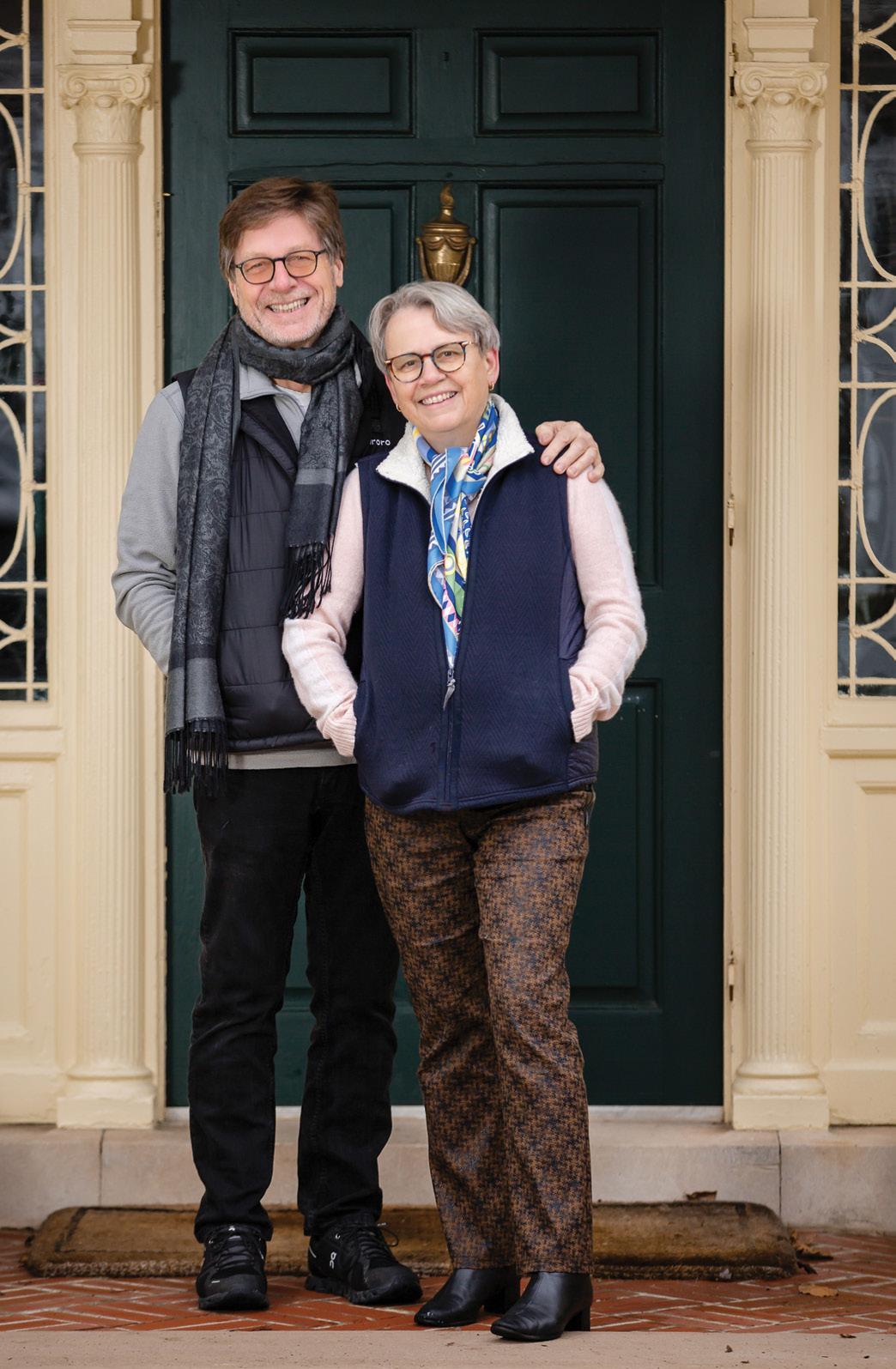
obsessed with photography. I want to get better at that, so I will continue to take classes and practice the skills. I also want to do volunteer work, working with schools or children. I know that I will be plenty busy. I have too many hobbies and interests.
Richard [Sheila's husband Richard Wright] retired from Dartmouth two years ago. What has he been doing since then?
He is part of a million-pound research project with a grant from the British
You became interested in birding first, and taking photos of birds led to your interest in photography. What about birds especially intrigues you?
Well, if you walk around this campus, they’re everywhere. I’ve always had an interest in them, but I think the more time you spend outside, the more you notice them. I don’t know what it is about birds. I just find them delightful. They’re really interesting. They’re difficult to photograph. So it’s a challenge.
Any other thoughts as you reflect back over your years at Loomis Chaffee?
Not very many people have the opportunity to come into a school that’s already great. John Ratté and Russ [Weigel] left things [in a good position] for me. I think John in particular had done a lot of heavy lifting to get the school where it was. And Russ had done a wonderful job in a number of areas, but particularly in fundraising. So it left me with a real opportunity. I felt very fortunate about that.
As a historian, how would you place the last 16 years in the arc of your career and life? And how would you characterize the school’s last 16 years under your leadership?
That one throws me a little bit because historians don’t generally write their own history. I don’t know how I would characterize it. I really don’t. I think that I’ve been blessed. It’s a great school.
This interview has been excerpted and edited for clarity and length.
loomischaffee.org 29
Above: Sheila and her husband, Richard Wright, stand outside the front door of the Head’s House this winter.
A School Transformed
Under Sheila’s tenure, the Island campus and the school’s programming have changed significantly. Major construction and renovation projects have touched every quadrangle and corner of campus over the last 16 years, and the establishment of five interdisciplinary centers has bolstered and expanded Loomis Chaffee’s innovative educational offerings. Here are some of the changes.

Dorm construction and renovation
Two new residence halls were constructed (including Richmond Hall, at right), and a third project is under way. The school also renovated and modernized three of its century-old dorms, with more slated in the near future.

Scanlan Campus Center
Construction of a campus hub, including new dining halls, an expanded servery, a new student center, the Pearse Hub for Innovation (PHI), and a variety of function spaces, was completed in 2018.
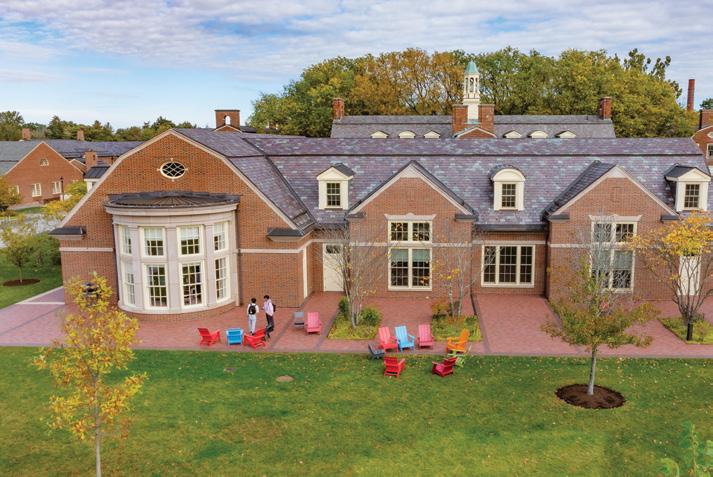
8 5 2 B 7 D A 6 11 9 14 C 15 10
30 Loomis Chaffee Magazine Spring 2024

John D. and Alexandra C. Nichols Center for Theater and Dance
One of the newest projects to be completed was construction of the Nichols Center, which opened in 2022 and contains the updated Norris Ely Orchard Theater, a new Black Box Theater, an expansive dance studio, state-of-the-art production spaces, and a welcoming lobby.

Major Construction Projects
Completed between 2008 and 2024
1 Clark Center for Science & Mathematics renovation
2 Katharine Brush Library renovation, including creation of classrooms and offices on third floor
3 Richmond Hall, 2014
4 Cutler Hall, 2016
5 Tennis Courts, renovation and addition, 2016
6 Scanlan Campus Center, 2018
7 Rockefeller Quad redesign, 2018
8 Howe Hall renovation and addition, 2020
9 Batchelder Hall renovation and addition, 2020
10 Covered Ways repair and renovation, 2020–21
11 Palmer Hall renovation, 2022
12 John D. and Alexandra C. Nichols Center for Theater and Dance, 2022
13 Ratté Quadrangle completion, 2022
14 Campus Way completion, 2023
15 New dorm under construction behind Warham Hall, expected completion by fall 2024
16 Not in aerial: baseball and softball dugouts, upper turf field, solar array, 8 houses purchased, 2 houses built

At the Center of It All
Henry R. Kravis ’63 Center for Excellence in Teaching, 2010
Alvord Center for Global & Environmental Studies, 2012
Norton Family Center for the Common Good, 2012
Pearse Hub for Innovation (PHI), 2018
Center for Diversity, Equity & Inclusion, 2021
loomischaffee.org 31 loomischaffee.org
A B C D E 1 4 12 3 13 E 5 16

Creatures of the Confluence Creatures of the Confluence
By Mary Coleman Forrester • Illustrations by Olga Baumert
In the busyness of our days, it can be easy to forget that the Loomis Chaffee campus is surrounded by a rich ecosystem — wetlands, meadows, woodlands, and rivers — all bursting with life. From the tiniest spring peeper to the largest black bear, there are creatures everywhere if you know where to look for them. Here’s a deeper look at some of the fascinating wildlife that is all around us.

Mosquito
Is there a more annoying or persistent insect than that little buzzing bloodsucker known as the mosquito? And of course, it should surprise no one that there is not just one kind of mosquito. In fact, there are more than 50 species of these pests inhabiting our small state of Connecticut. Is it comforting to know that fewer than half of those prey on humans and livestock? Not when you are outside on a humid summer’s night and the itching starts! Fortunately, we have a few other flying friends who love to eat these little buggers. You may not love seeing bats — the only mammal that can truly fly — circling overhead when you are nestled around the campfire, but when you learn that one tiny brown bat can eat up to 500 mosquitoes in one hour, somehow they look a little less menacing. Dragonflies, too — with colorful species names such as Eastern Pondhawk, Blue Dasher, and Fragile Forktail — eat a good number of mosquitoes and can be seen darting around the Meadows in summer like fighter pilots on the hunt for their miniscule prey.
In recent years, Loomis Chaffee students have erected bat houses in the Meadows to attract and protect the ailing and beneficial species of local bats that have suffered a significant decline in numbers due to an epidemic of the
EASTERN COYOTE
If you want to see coyotes on campus (from a safe distance, of course), you might consider heading down to the Meadows shortly after a major mowing of the fields. The sound of the mowers seems to draw the coyotes to the
mysterious disease known as White Nose Syndrome. Fewer bats means more flying insects, which means an increased potential for the spread of mosquito-borne illnesses. The mosquitoes, on the other hand, seem to be doing just fine.


EASTERN GRAY SQUIR re L
You would be hard-pressed to spend more than an hour on the Loomis Chaffee campus without seeing one of the innumerable examples of eastern gray squirrel that live here. These ubiquitous bushy-tailed rodents, who seem to inhabit nearly every tree inside the Loop, clearly eat well. They can often be seen scurrying around with abandoned muffins or popping out of a trash can clutching a stray pizza crust. Loomis Chaffee’s squirrel population is popular enough among students to rate their own Instagram account, and one of their number, a certain Sciurus Bushington, had a regular column in The Log for a while. The Meadows-dwelling squirrels are no less well-fed than those inside the Loop, dining on a feast of acorns, black walnuts, and the plentiful assortment of seeds and mushrooms found along the riverbanks.
Canada Goose
If our mascot wasn’t already the pelican, the Canada goose might make a good candidate for the role given its staying power on the Island. While some of the geese we see here do still migrate routinely, the Meadows are now home to a large number of year-round residents of the Branta canadensis variety. Their story is all too common for our native wildlife: These familiar birds that were nearly extinct and rarely seen 100 years ago are now so prevalent that they are often regarded as pests in suburban areas, especially because they do tend to leave a bit of a mess. On an average day on campus, you wouldn’t be surprised to see 100 or more birds take to the skies in their familiar V-formation. Close observers will notice that the birds will switch up the lead role at the top of the V, in which the birds tire more easily. The birds in the rest of the V benefit from the lift of the beating wings of the geese in front of them. It is thought that their honking in flight signals position changes in the V-formation so that the other geese know who is going where!


to associate humans with food sources. This
happens when people intentionally feed the wild canines, which they should never do. Coyotes often can be heard howling in the Meadows and the surrounding environs at night. The howling, while chilling, is really just their way of communicating with each other about a whole host of things: finding potential prey, searching for a mate, or warning nearby packs that they are crossing into the wrong territory. According to the Connecticut Department of Energy and Environmental Protection, there are an estimated 3,000 to 5,000 coyotes living in the state. No estimates on how many live on the Loomis campus, but if the night howling near Faculty Row is any indication, it’s more than a few.

34 Loomis Chaffee Magazine Spring 2024

and ponds make an ideal habitat for these semi-aquatic herbivores — the largest rodents in the United States. Several large examples have been spotted in the Hockey Pond in recent years, drawing comparisons to marine mammals such as seals, and evidence of their lumbering expeditions is apparent nearly everywhere water meets tree trunks. Sometimes regarded as pests for their habit of gnashing down trees and flooding fields, beavers were hunted to the brink of extinction for their valuable pelts. Like so many of our local woodland creatures, they have made a significant comeback in our area. Growing to as much as 65 pounds and three to four feet long and living up to 12 years in the wild, beavers are the architects of the woodlands, creating safe and warm wooden lodges with submerged entrances that protect them against predators. Their broad, flat tails are quite useful: They serve as rudders while swimming, as a place to store fat reserves for the winter, and, when slapped against the water, as a warning to other beavers of the presence of predators.
If you’ve ever encountered a black bear, you might be surprised to learn that they are considered to be “medium-sized” bears, despite the fact that the particularly well-fed among them sometimes weigh in at more than 500 pounds. In 2023, there were almost 300 bear sightings reported in the town of Windsor, including several on campus. In recent years, bears have become a bit of nuisance in our area, especially in the hills to the west of us in the towns of Avon and Simsbury, where they long ago figured out how to open French doors, dine from even locked trash barrels, and fling open garage doors. You can spot bears with many, many tags on their ears. Nearby Avon

Old Farms School has a special bear alarm reminding students not to approach a bear because the sightings there are so frequent. We don’t see nearly as many here, but they are here. One particularly bold fellow made a recent appearance on some early-morning security video footage near Longman Hall. With a diet that is largely herbivorous, they are not particularly dangerous to humans, wanting as much to do with us as we do with them. That said, females may display some aggression in protecting their young and they may get a bit “hangry” when they first come out of hibernation, which is understandable. When walking in the forest, it’s best to let the bears know that you are there by talking loudly or generally making noise. They will likely steer clear.


Great Blue Heron
Gangly yet somehow graceful, the great blue heron is a familiar visitor to the Island, especially in the Hockey and Cow ponds, where it hunts for frogs, fish, or frankly anything that moves in the water and that it can swallow whole. Longtime residents of the Island can recall a time when it was rare to see a heron on campus. These highly adaptable birds, whose wingspans rival that of bald eagles, were long hunted for the beautiful feathers and suffered negatively from the effects of PCBs and mercury in the state’s waterways. Still, they have made a remarkable comeback over the last two decades and can now be found in all towns in Connecticut and throughout the country. They roost in trees, which seems at odds with their long legs, bills, and necks. Fiercely territorial, they have been known to attack anything or anyone, including humans, to defend theirs.
BOBCAT

Elusive, secretive, stealthy: all words used to describe lynx rufus, also known as the bobcat, our area’s only native wild cat. While not nearly as commonly observed as some of the other creatures of the confluence, sightings have increased considerably in recent years. There have been more than 800 reported sightings in Connecticut this year alone. On-campus sightings are now far less newsworthy than they were even five years ago. Not long ago, a particularly large fellow was seen wandering out in the open in the middle of Beckwith Circle off Island Road; another smaller example,
most likely a female, was seen recently — albeit from a considerable distance — on a late-afternoon walk by the lacrosse fields. Since the cats like to hide in low, thick brush around lightly forested areas, the Meadows and its environs make an ideal habitat for them, full of their favorite prey — squirrels, rabbits, chipmunks. Even the occasional small or injured deer might become supper. So what explains the dramatic increase in sightings of this common but (previously) largely unseen feline? One reason may be that, since being designated “protected furbearers” by the Connecticut Department of Energy and Environmental Protection in 1972, which prohibits hunting or trapping of bobcats, they have developed less fear of humans over time. They are highly adaptable animals too, and they may have learned that living in closer proximity to humans offers both access to easy meals (that squirrel at the birdfeeder or the bunny scampering through the yard, for example) as well as some level of protection from animals who might prey on their young.

Whatever the explanation, no need to worry about these exquisite, solitary cats being nearby. Unless sick, they are extremely unlikely to tangle with humans or our contained pets and livestock.
Spring Peepers
After a long, cold winter, the joyful sound of spring peepers emanating from the Meadows on a March evening has filled many a heart with joy. While these “Chorus frogs” are hard to spot, they are easy to hear — tiny heralds of the warmer days ahead. All together, their evening concerts can reach 90 decibels in volume, according to the Meigs Point Nature Center in Madison, Connecticut — about the same volume as a lawn mower, though far more pleasant a sound. Like many amphibians, peepers have a kind of anti-freeze in their blood that allows them to hibernate over the winter in vernal pools all across the Meadows and surrounding wetlands in cold conditions, only to “thaw out” when warmer temperatures return.


36 Loomis Chaffee Magazine Spring 2024
Monarch ButTErfly
When you think of a butterfly, more than likely the image that comes to mind is that of the iconic black-and-orange Monarch butterfly.
These beautiful insects can often be seen flitting about the Meadows in late spring or early summer. Since they cannot tolerate our cold New England winters, some of them that had hatched here the previous summer travel enormous distances to overwinter in large roosts in the Sierra Madre Mountains of Mexico. Then they come back in the late spring or early summer for breeding. Monarch caterpillars are particular eaters, sticking primarily to the native milkweed and butterfly bush where their eggs had been laid. They gorge themselves on the plants before cocooning and then emerging as butterflies. The monarchs who returned from Mexico, however, will not be heading back there. Once they start off the summer breeding season, mating and laying eggs, they will live out the rest of their brief lives here in Windsor. During the summer, the monarchs that hatch typically live 2 to 5 weeks, each “generation” repeating the breeding cycle. That is until the last summer generation appears. It is that group that makes the long trip to the same overwintering grounds in

Mexico that their parents or grandparents left months before — a place they have never been — and it is this group that will return north once again the following spring.
It's not clear how exactly the monarchs manage this trip of several thousand miles, but it is an astounding feat. Do they navigate by the sun? Do they have an internal map? Can they sense magnetic fields? Theories abound, but one thing is clear: The Windsor Monarch Project, which is promoting the planting of butterfly-friendly plants and providing education about this important pollinator, is working hard to make sure that there are plenty of plants that the butterflies require here when they do make it back.


American shad
Most Loomis Chaffee alumni have probably at least heard of and have possibly attended the nearly-70-year-old Shad Derby in Windsor during their time on the Island. But how many know it was named for a fish? The annual derby or fishing contest began in 1955; in 1966, the festival on the Town Green and a parade were added to celebrate this important fish. Shad spend most of their lives downriver in the Atlantic Ocean but

swim upstream to spawn every spring, hence the Shad Derby’s motto: “The Shad Always Return.” Known at one time as either the “poor man’s salmon” or “the fish that fed our nation’s founders,” their roe is considered a delicacy by some. The fish, which generally live around five years and weigh between two and six pounds, travel up and down the river every year, covering thousands of miles in their lifetimes.
EasTERN Screech OWL
Though perhaps more often heard than seen, there are plenty of owls here on campus, and it’s relatively easy to hear the distinctive nighttime calls of the Barred Owl and the Great Horned Owl, among others. Even an occasional migrating snowy owl has been known to pass through these parts. One example of one of the smallest owl species in Connecticut — the Eastern Screech Owl — became a bit of a local celebrity during the pandemic when it took up residence in a cavity of a sycamore tree near the football field. Because it faces south (owls like to sun themselves on sunny winter days) on Island Road and is a good 20 feet (a safe height for protection from predators) above the ground, this cavity is the perfect place for a small owl to roost. Reduced pedestrian and car traffic on Island Road might have encouraged its choice of home, because it left shortly after life on campus began to return to its normal pace post-pandemic. These tiny owls are about the size of a robin and can be difficult to spot even when sunning on the edges of their cavities because of their excellent camouflage. Because of their exceptional vision and even better hearing, owls can detect the movements of tiny critters burrowing under the snow at night from a considerable distance. When they do pounce, they do so with open wings, rarely missing their mark and occasionally leaving beautiful evidence of their nighttime activities in the form of a detailed impression of their wingspan in the snow for observant passersby to see.




• W A G Y U C R O Q U E T TA S • P O N Z U & P I N K P E P P E R C O R N M I G N O N E T T E • A 5 ST R I P LO I N M I Y A Z A K I GY U • M I L K & P A T I E N C E C O C O N U T Y O G U R T • G R E E N C I R C L E C H I C K E N • R O A S T E D L I P S T I C K P E P P E R S • A T O M I C H O R S E R A D I S H • TO M A H A W K S E A B E A N & F E N N E L S A L A D, V A D O U V A NS P I C E D C U R R Y A I O L O • S M O K Y A K A U S H I W A G Y U TA R TA R E • S U R F & T U R F B O N E M A R R O W • S Y M P H O N Y O F T O M AT O E S , A S I A N P E A R S & B U R RATA • S T I C K Y I B E R I C O R I B S • R E G I I S O V A C A V I A R •
Given a choice, Elizabeth Blau ’85 would head straight for the desserts. She has a sweet tooth, and one heck of a sweet job. She eats in the finest restaurants, stays in the finest hotels, and travels the world as the co-founder and chief executive officer of a restaurant development company. She operates nine restaurant concepts with her world-class chef husband, Kim Canteenwalla; is involved in various philanthropic work; and the family has homes in Nevada and on Cape Cod.
To think it all started one day with what she refers to as a “funny Loomis story.”
By Jeff Otterbein
MORE THAN JUST A TASTE OF SUCCESS
From Planning Restaurants to Owning Them, Alumna Has a Full Plate

Elizabeth was the business manager for the school newspaper, The Log, and went to a restaurant in West Hartford to sell an ad.
“They said, ‘Sure,’” Elizabeth recalls. “We’ll do a two-for-one margaritas ad. And I said, ‘We’re a high school. That won’t work,’ and they said, ‘Sure, we’ll do two-for-one appetizers, and would you want a job?’”
This time she was the one saying sure.
The restaurant needed someone to help make food for happy hour. “I said that sounds fun,”
Elizabeth says, “That was my first job in the restaurant industry, and I fell in love with it.”
After graduating from Loomis Chaffee, she went to Georgetown as a government and international relations major but never strayed far from her passion. She started working at a café in the student union and at some local five-star restaurants. “I started a little catering business my senior year — The Butler Did It — I guess I just got the hospitality bug,” Elizabeth says.
Today Blau + Associates is a strategic restaurant planning and development
company that has taken her from Dallas to Dubai. From strategic master planning to design coordination and layout and from marketing and public relations strategy to revenue assessment, Blau + Associates serves up a full course of assistance in an industry known to grind up and spit out restaurants at an alarming rate.
“It is a very difficult business, long hours, a lot of personal sacrifices,” Elizabeth says. “And the restaurant industry has a 50 percent mortality rate. That’s not a very good statistic to want to enter our industry. A restaurant has a 50-50 chance of succeeding.”
There is much more to it than what gets brought to the table.
“You might be good at service, you might be a great chef and have a great culinary idea, but the real estate deal, your marketing and business acumen are equally as important as your service and food,” Elizabeth says.
And let’s not forget the power of social media, which can be a successful marketing tool. Yet every guest with access to social media can choose to become a restaurant critic. Just think of your favorite restaurant, Elizabeth says. You might feel it always rises to the occasion, but you might not know it from social media posts.
loomischaffee.org 39
Above: Elizabeth Blau with her husband, Kim, and son, Cole
Remaking Las Vegas
Las Vegas used to be known for bets and buffets, but Elizabeth helped remake the city into a culinary destination. After getting her start in New York City with Sirio Maccioni, proprietor of Le Cirque, she worked with him in Las Vegas to start Le Cirque at the Bellagio, a resort that opened in 1998 under casino owner Steve Wynn. The Bellagio cost $1.6 billion at the time, with more than 3,000 rooms, high-end shops and restaurants, a casino, even a musical fountain on an 8.5-acre man-made lake. Before long Elizabeth was recruited as vice president of restaurant development, overseeing all
aspects of food and beverage, first for Mirage Resorts and later for Wynn Resorts.
She founded Blau + Associates in 2002. Mirage Resorts had been sold to MGM, for whom she worked two years before taking the next step.
“I have a dream job,” Elizabeth says. “I am always learning. I get to travel around the world, stay in the finest places and eat in the finest places, and each project is part of an incredible changing paradigm in our industry. When I moved to Las Vegas 29 years ago, it was the start of the change of Las Vegas as a culinary destination.



“You might be good at service, you might be a great chef, have a great culinary idea, but the real estate deal, your marketing and business acumen are equally as important as your service and food.”
— ELIZABETH BLAU
40 Loomis Chaffee Magazine Spring 2024
PHOTOS


Many people say Steve Wynn’s opening of Bellagio changed Vegas.” She feels fortunate to have been part of that change in Las Vegas and then in Asia, including Macau and Singapore.
Now she is consulting on the development of the Wynn Resort project on Al Marjan Island in Ras Al-Khaimah in the United Arab Emirates. It will be the first casino in the Middle East. She also is advising one of Saudi Arabia’s “giga” projects, massive multibillion enterprises.
“Even in five years, to have seen how Saudi Arabia has changed and opened up as
destination and [to think] what will happen over the next 10 years,” Elizabeth says. “These are extraordinary things. When you get to do one, you think that is incredible, but when that continues, that's why I consider it a dream job.”
That dream job also means owning restaurants. On these pages: Crown Block in the historic Reunion Tower in Dallas offers a feast for the eyes everywhere you turn.

loomischaffee.org 41

In 2012 Elizabeth and husband Kim, who met while each worked for Mirage Resorts, started their first restaurant, Honey Salt, in Las Vegas. It has a farm-to-table, high-end comfort food vibe that is family friendly. The restaurant is less than a half mile from their home. Honey Salt serves market-inspired cuisine that draws from Elizabeth and Kim’s travels, childhood memories, and meals they have shared in their home with family and friends. Honey Salt’s ticketed Farm Table dinners are a big hit, featuring pre-fixe menus and local partnerships.
The regular menu has gluten-free, vegetarian, and vegan options, a filet mignon if you want to go there or a downhome favorite like meatloaf. There’s a sweet version of monkey bread on the brunch menu and a savory version as an appetizer on the dinner menu. You can eat healthy or indulge.
There’s also a cookbook — Honey Salt Food & Drink: A Culinary Scrapbook — which was published in 2018 and might be best described as Elizabeth and Kim’s culinary journey involving things near and dear to their hearts.
“Honey Salt is personal to our family and not just a restaurant,” Elizabeth says.
The business is personal to Elizabeth, too. Though she has made it to the top, many women do not, so she helped form the Women’s Hospitality Initiative in 2020.
Even though women make up 50 percent of those who enroll in
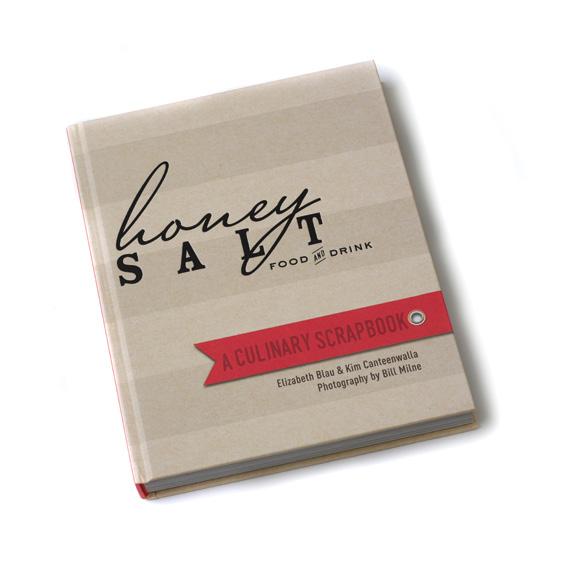
culinary and hospitality programs, only about 7 percent make it to executive chef or own their own restaurant, Elizabeth says. She is hoping that changes through education and mentorship.
Elizabeth also has taken to fighting food insecurity. As she says, her job is to dream up the most delicious, exciting, cuttingedge restaurants, but lurking everywhere is hunger.

“Right here at home in Nevada people are suffering from tremendous food insecurity,” Elizabeth says.
42 Loomis Chaffee Magazine Spring 2024
Above: Honey Salt offers high-end comfort food and draws from the lives of Elizabeth and Kim. There’s a cookbook, too.
Elizabeth is the Culinary Council chair for Three Square, southern Nevada’s largest organization for fighting hunger. The Culinary Council participates in fundraising events and volunteers in other ways.
“Elizabeth has been widely credited with transforming Las Vegas into a world-class culinary destination,” says Beth Martino, president and chief executive officer of Three Square. “As chair, Elizabeth has wholeheartedly embraced our mission. We are immensely grateful to collaborate with a renowned restaurateur of her caliber. With her influence in the community and leadership of the council, Elizabeth has helped Three Square cultivate heightened awareness and momentum for our mission.”

Elizabeth sits on the Nevada board of directors with the national organization Communities in Schools, which works with public and charter schools to help at-risk students. During the pandemic, which cut off normal channels for obtaining food and left many people at risk for hunger, Elizabeth and owners of three other restaurants joined forces to start Delivering with Dignity. The program “had an army of what we called food heroes who picked up the food and delivered it to the doorsteps of the most vulnerable,” says Elizabeth. Delivering with Dignity stopped operations in December 2023. Honey Salt continues to support the work of Three Square benefiting local community food programs.
In 2023 Elizabeth’s portfolio expanded with the opening of Crown Block in the historic Reunion Tower in Dallas, Texas. The restaurant uses local ingredients of Texas and the Gulf Coast and focuses on high-quality meats, wild-caught seafood, sushi, and a dessert bar. She also was named global ambassador for food and beverage with Forbes Travel Guide in 2023, a nod to her many years in the hospitality industry.
Elizabeth travels 100 to 150 days a year, and the house on Cape Cod can offer a respite for her and her husband. Kim has been in
the hospitality business for 40 years. He is the former executive chef of the MGM Grand in Las Vegas and has worked in restaurants and resorts around the world. Like Elizabeth, he is active in supporting the industry and the community. His paella, which he will sometimes make when they are on the Cape, hits the spot every time.
With all that food around everywhere she turns, how does Elizabeth strike a healthy balance?
“It’s always a challenge,” she says. “I love the outdoors. I’m not a gym class person, but I like biking and spinning and all kinds of outdoors activities. I’ve found pickleball, which I am obsessed with. It’s such a great cardio workout. I love hiking, I love walking, and whenever I am traveling to cities, it is a great way to immerse yourself. When I am traveling or when I am going to restaurants and chefs are cooking unbelievable meals for me, I completely indulge. But when I am home, I try to be a little more conservative and healthier. … It’s a constant battle, and getting older does not help.”
When Elizabeth reflects on her Loomis Chaffee days, she says teachers such as Sally Zimmer Knight and Nat Follansbee, both of whom taught English when she was a student, left lasting impressions as did the rigorous academics and diverse student population. “Where else would you get that opportunity to interact with people from all over the world?” she comments.
We asked Elizabeth if she were to create a signature dessert for Loomis Chaffee, what might it be? Her idea is a dessert that alludes to the Island nickname for the campus. “There is a delicious, fun, playful dessert called a Floating Island, which has a big meringue. And some of my desserts have cotton candy, so I could see a Floating Island with meringue and cotton candy being a fun signature dish.”
Food can be fun and meaningful.
“It can bring back childhood memories, memories of holidays, memories of travel. It can bring back memories of favorite restaurants that might have been where you ate on special occasions or family rituals,” Elizabeth says. “And there are so many senses involved with eating … it certainly is my passion, and I think that is why some of us choose to get into this crazy business.”



Above and below: Food is near and dear to the hearts of Elizabeth and Kim, as their presentation of the food illustrates. “There are so many senses involved with eating,” says Elizabeth, whose culinary journey started when she was business manager of The Log

loomischaffee.org 43
Jen Solomon rarely sits at her desk. You’re more likely to find her a few steps away in the Pearse Hub for Innovation (PHI), fervently engaged in her roles as associate director of innovation, robotics coach, and director of the Innovation Trimester, or in
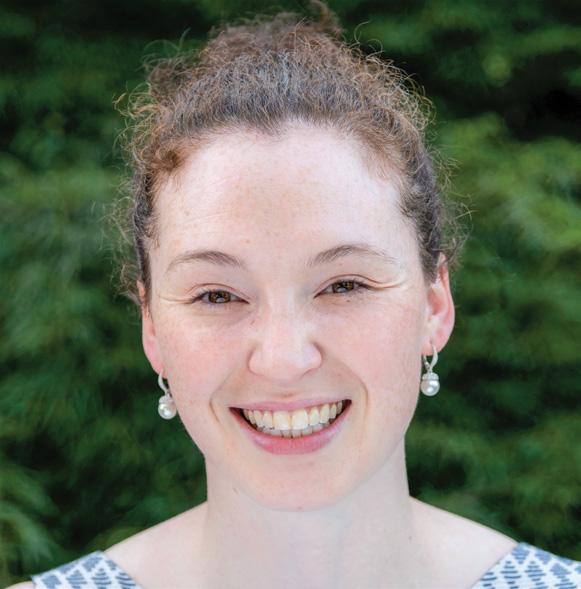
Faculty Desks
the Clark Center for Science & Mathematics teaching biology. But while sitting in an office isn’t Jen’s style, her desk still is an important repository for her works in progress. It also offers plenty of clues to her passions for creating, teaching, and learning.
JENNINE SOLOMON ASSOCIATE DIRECTOR OF INNOVATION

Several gifts Jen received from her husband, Andrew. The gnome and the music box are souvenirs from Wroclaw, Poland. The music box plays the opening song from the Harry Potter movies. The metal objects were 3D printed on metal powder bed printers.
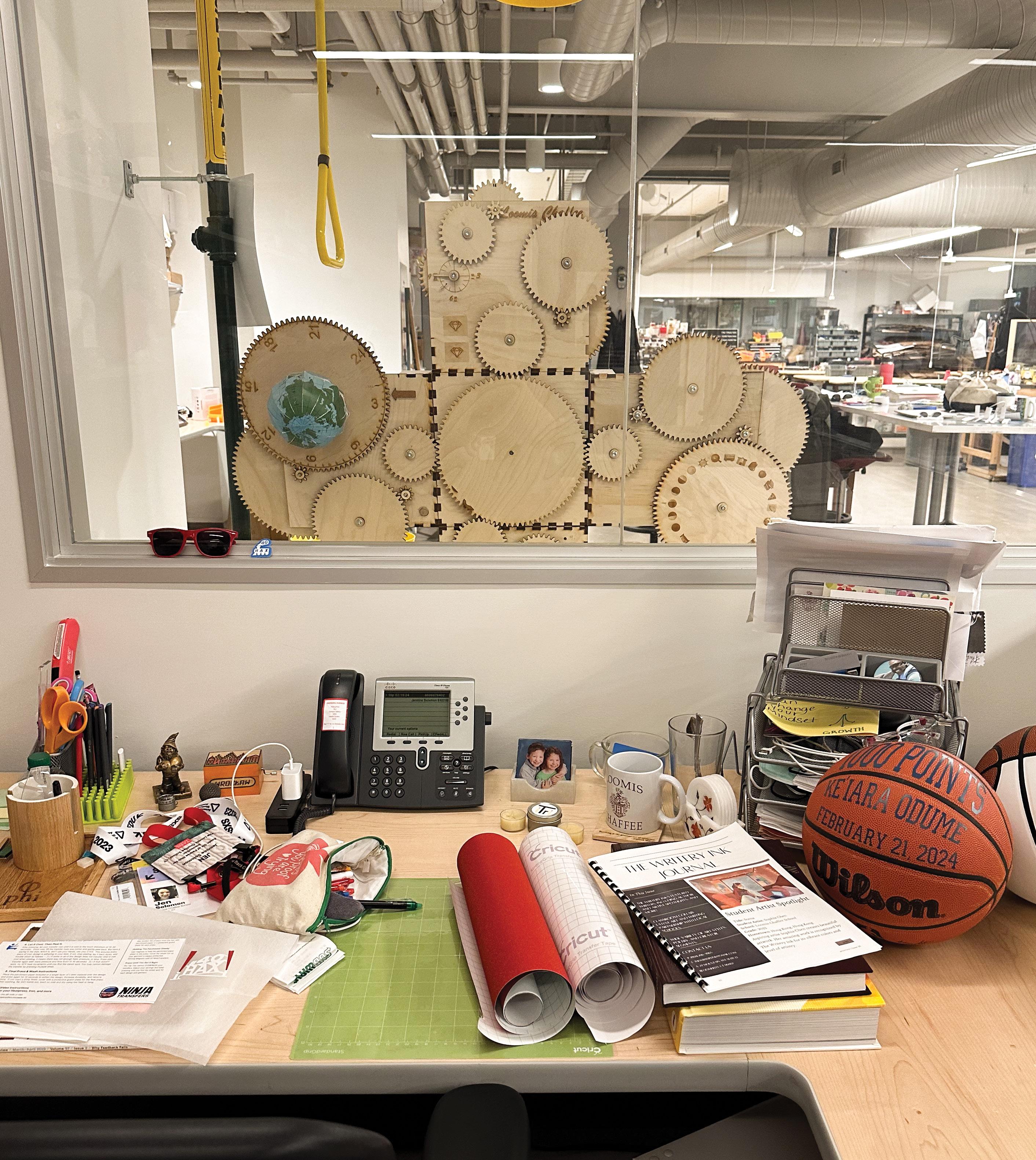
A clock made in the PHI by Ewen Ross and one of his first engineering classes during the 2018–19 school year. Ewen, who died last year, taught engineering and physics, coached the robotics team, and was integral to the PHI from its inception. The clock was inspired by the film Most Likely to Succeed.

A sticker made for the 2021–22 robotics team by now-junior Guilherme Martignago Cassol using the PHI’s Cricut cutter. The First Tech Challenge game that year was “Freight Frenzy.”
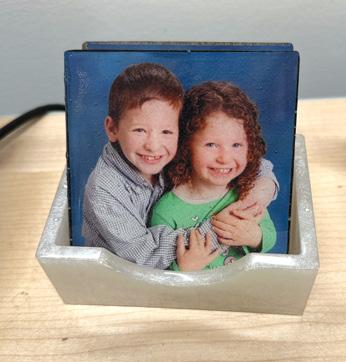
Resin coasters with photos of Jen and Andrew’s children. The coasters and the container were made in the PHI.
The pencil case, which declares “mistakes are proof you are trying,” contains Jen’s Frixion pens, which she uses with Rocketbook Notebooks, scannable and erasable notebooks.

A work-in-progress at the time. It is a prototype for a commemorative basketball to be presented to senior Ke’iara Odume when she scored her 1000th point this winter. The final ball would be adorned with white panels and bold red lettering using materials at left and the Phi's Cricut cutter.
Recent Books
by ALUMNI WRITERS
BOB JOHNSTONE ’52 Maverick
Marketer: Time to Get Creative
•
ZANE HICKCOX KOTKER ’54
These books have been published or have been brought to our attention in the last year. The editors ask alumni to send updates and corrections to magazine@loomis.org for inclusion in this annual list.
Queen of the Mountain: An Autobiographical Novel (published posthumously)
• JONATHAN F.S.
POST ’66 Elizabeth Bishop: A Very
Short Introduction
• JIM WEEKS ’69 Nodding’s People (a novel)









MARY JEPPSEN ’71 Working With Co-Parents: A Manual for Therapists
• MARY LOWENGARD ’71 The Bucknoll Cottage Chronicles: Sex and the City meets Under the Tuscan Sun, but no sex, no city and in the Poconos (memoir)
• WILL BEEBE ’76 Soccer Giants of Brazil: One American’s Take on Samba Soccer Culture
• MARY COLLINS ’79 A Play Book: Creating Writers, Creating Citizens
STEPHEN SAYERS ’84
The Carousel Man (a horror novel) and 100 Things To Do in Plymouth Massachusetts Before You Die (travel book)
• PETE CAPUANO ’93
Dickens’s Idiomatic Imagination: The Inimitable and Victorian Body Language
• BRENDAN FLAHERTY ’02 The Dredge (a novel)




loomischaffee.org 45

Garden in Granite
By Karen Parsons Loomis Chaffee History Teacher, School Archivist & Curator
The school’s first headmaster, Nathaniel Batchelder, reported on the construction-to-date of Palmer Hall in the Loomis Alumni Bulletin of fall 1937. In addition to the dormitory, which established the west facade of the main school quadrangle, he described various projects at the building’s site. His spouse, nationally acclaimed sculptor Evelyn Longman, designed “a memorial tablet to the Palmers, who so generously provided the building.” Mr. B continued, “Fred Brown ’20 was here yesterday with designs for the two gardens at the end of the building. … Boys passing from the quadrangle to the gymnasium or athletic fields will go through the gardens, and every passer-by will look into them. One will be evergreen, the other dominated by azaleas — two lovely spots for the enjoyment of faculty, boys, and visitors.” During the following spring, the gardens were planted and, Mr. B noted in a subsequent issue of the Bulletin, “Mrs. B’s garden centerpieces are set … .”
Each garden features a circular granite medallion bearing incised motifs complementing the plantings in Brown’s original vision, pine boughs and pinecones for the north medallion and dogwood blossoms for the south. Created by cutting these design elements exactingly into the stone and maintaining an overall flat surface — a process known as intaglio — and placed into the ground just slightly above the level of the gardens, these objects diverged from much of Longman’s previous works. By the mid-1930s, she was well known for her figural, allegorical sculptures done in life-size or monumental scale and her low relief art, mostly profileview portraits that emerge gracefully from their backgrounds of marble or bronze.
Longman modeled four pieces of sculpture for the building itself, and each employed,
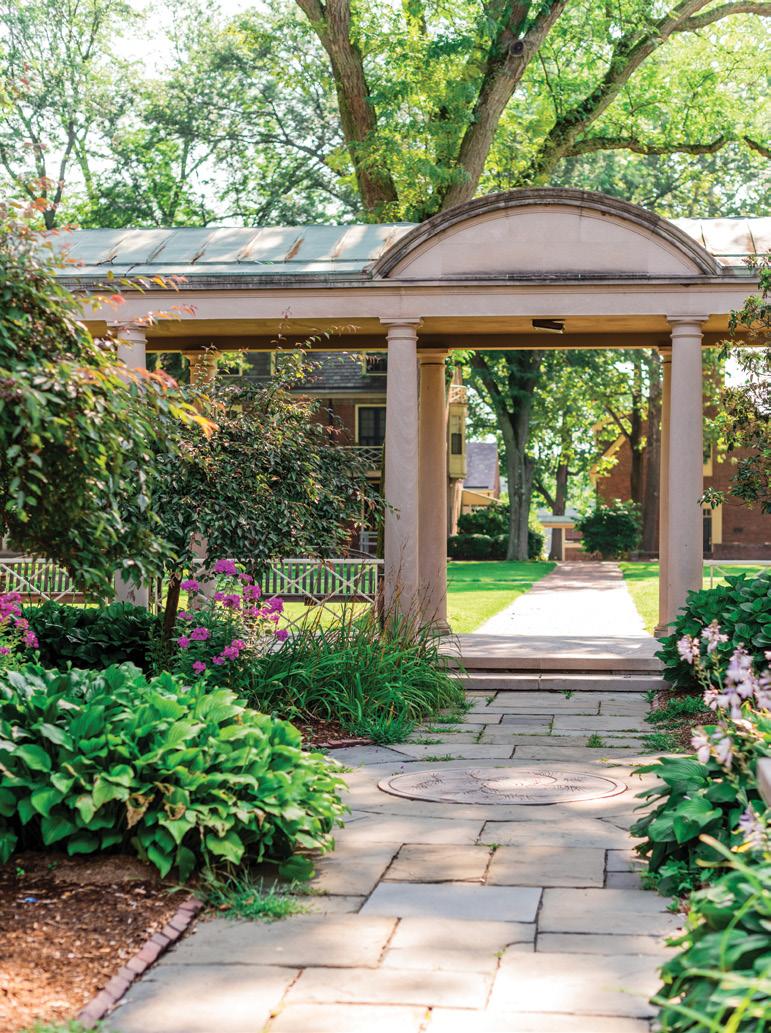
to some extent, an intaglio approach to working design elements. The Palmer memorial tablet, a low relief profile of donor Virginia Palmer, bears incised swirling vines and tendrils surrounding Virginia’s portrait. A flat bronze terrace medallion set into the dorm’s back portico is decorated with an elaborate stylized depiction of the four compass directions and an allegorical figure evoking the wind, all worked with incised features. These and the garden medallions reference Longman’s 1932 design for a frieze set along the roofline of what was then the Hartford, Connecticut, U.S. Post Office. Carved with angular steep lines, Art Deco-style riders and horses depict the Pony Express. The Palmer projects are more traditional in their subject matter and employ a lighter touch with shallower, naturalistic lines. As a group, they demonstrate Longman’s flexible thinking in using her artist’s skills to best suit the dormitory site.
In May 1940, two years after Palmer Hall opened, James Willard Williams, a faculty member at the Gunn School in Washington, Connecticut, visited campus, possibly to attend a gathering of English Department faculty from Connecticut independent schools. Just as Mr. Batchelder had predicted would happen, Williams lingered in the Palmer-flanking gardens. He wrote to Evelyn Longman with admiration for her art. “May I send you a line to tell you of the very great pleasures I had yesterday in studying the two carvings that hold the centers of the two small gardens between the buildings at Loomis? I have not seen anything so fine in many months as your pine and dogwood designs. The latter, in particular, is wonderful for its accuracy as well as for its beauty of design and its perfection of execution. Few artists would ever have done the twigs with such genuine feeling for the peculiar contours of dogwood. I must thank you for many happy moments to come, as I remember these two lovely cuttings.”
Longman contributed to the dormitory in other ways. She critiqued drawings for the Ionic caps to the building’s impressive columns and consulted on a Greek key design for the social room’s ceiling molding. She and Mr. B selected a large landscape painting from the New York studio of painter and friend Chauncey Ryder to hang in the social room. With recent renovations to Palmer, this landscape painting now hangs in the Katharine Brush Library, where students, faculty, and visitors can be found, just as James Williams had in the gardens, lingering to appreciate the beauty of its design.
Opposite Page: The dogwood blossom motif in Evelyn Longman Batchelder’s granite medallion in the garden south of Palmer Hall Above: Crossing from the gym to Grubbs Quadrangle offers an inviting garden path, centered by one of Longman’s medallions.
loomischaffee.org 47
LESSON
OBJECT

DECEMBER 5, 2023
ALUMNI GATHERINGS
Hartford Reception
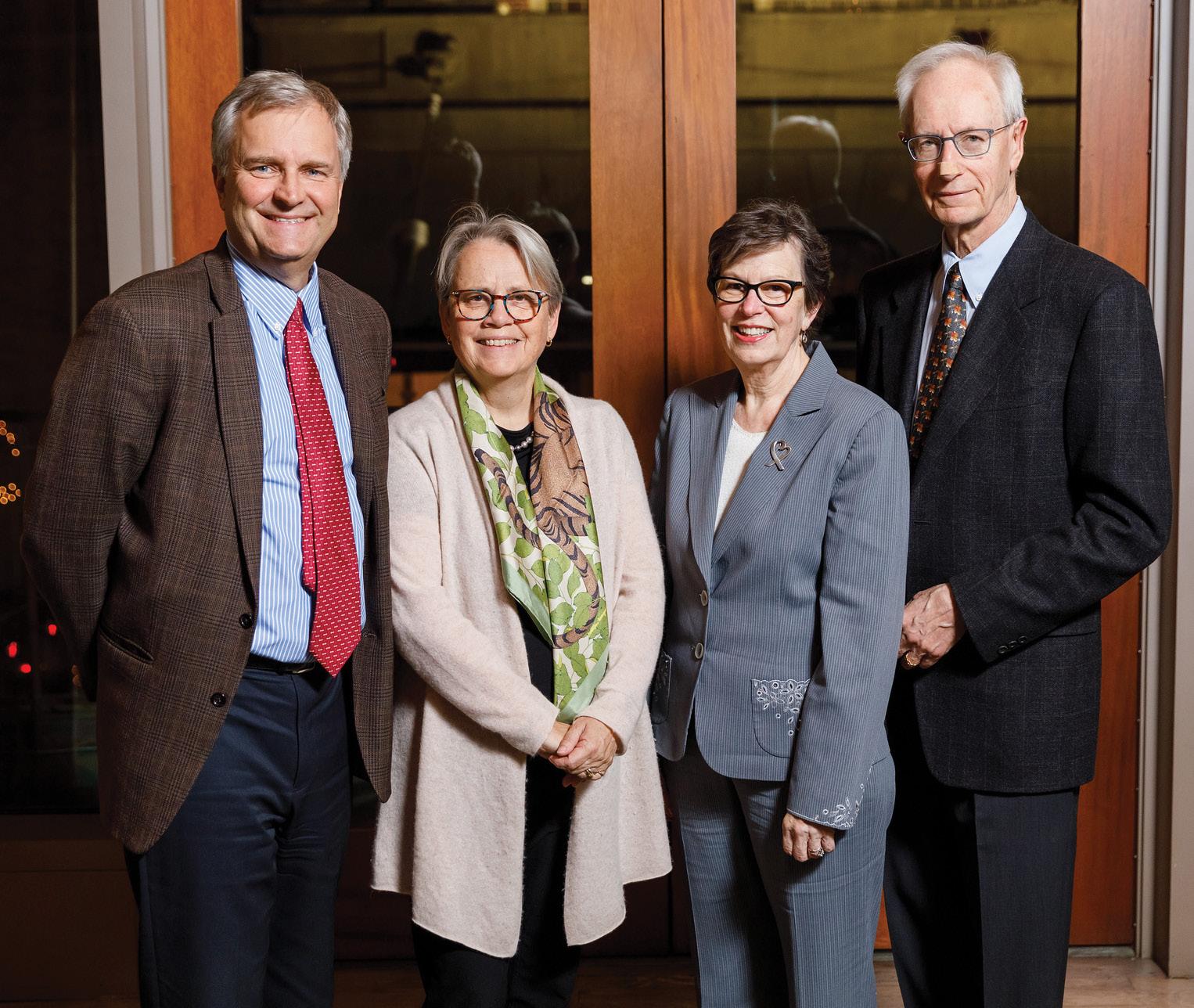

48 Loomis Chaffee Magazine Winter 2024 Spring 2024
Above: Alumni, parents, and friends gather in the Autorino Great Hall at the Bushnell in Hartford. Bottom Left: Chief Advancement Officer Tim Struthers ’85, Head of School Sheila Culbert, and hosts former Chair of the Board of Trustees Blanche ’70 and Steven Goldenberg. Bottom Right: Joseph Singh; Bhavna Sacheti Singh ’96; Philip Lahrmann P ’02, ’04; Susan Lahrmann P ’02, ’04; Jeffrey Lahrmann ’04; and Jacqueline McCay P ’02 ’03.
NEWS FROM ALUMNI / DEVELOPMENT

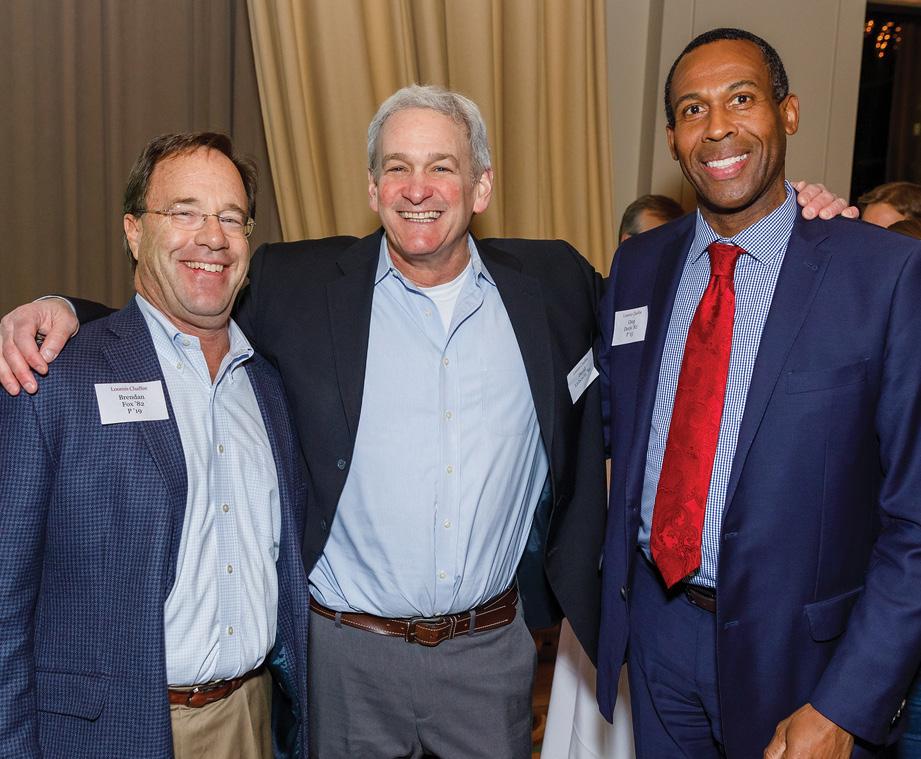

WAYS TO GIVE
Did you know that you can donate to Loomis Chaffee in a variety of ways? Thank you, as always, for your support and please let us know if you have any questions about making your gift this year. You can reach us at 860.687.6276 or annualfund@loomis.org.
The 2023–24 Loomis Chaffee Annual Fund closes on Sunday, June 30, 2024.
Credit Card
Recurring Gifts
Stock Transfers
The fastest way to support Loomis Chaffee is by credit or digital wallet online at www.loomischaffee.org/give You can also make your gift by calling 860.687.6276 to provide your credit card information.
Recurring gifts are a great option for donors who want to maximize their gift, with the convenience of automatic renewal. Donors can give to Loomis Chaffee in monthly or yearly installments at www.loomischaffee.org/give.
Gifts of securities offer significant tax advantages and are easy to make. Donors avoid capital gains tax on the appreciation and receive a deduction for the fair market value of the stock. Please refer to our website for transfer instructions.
IRA Transfers
Donor-Advised Funds
Wire Transfers
If you are 70 ½ or older and own a traditional or Roth IRA, you can transfer up to $105,000 in a given tax year to a public charity of your choice, including Loomis Chaffee.
A donor-advised fund (DAF) is a type of giving vehicle that allows donors to easily support their favorite charities. Donors may also be eligible for certain tax benefits. An increasingly popular charitable option, DAFs are an excellent way to both simplify charitable giving and facilitate your strategic philanthropic goals.
Donors may support the school by making their gift via domestic or international wire transfer. Electronically transferred funds should be payable in U.S. dollars. Please notify our office in advance of your intent to wire funds.
Check Donors can make checks payable to: “The Loomis Chaffee School.”
Further details on how to support Loomis Chaffee can be found on our Ways to Give site at www.loomischaffee.org/giving/ways-to-give.
Support of Loomis Chaffee is always appreciated and will continue to make a direct and positive impact on the lives of our students, faculty, and staff.

STAY IN TOUCH
CONNECT WITH US ON SOCIAL MEDIA

loomischaffee.org 49
Loomis Chaffee Alumni
@lcclassnotes
Loomis Chaffee Alumni
Top: Deb Shulansky ’77, P ’07, ’14, ’14, Kathy Danielczuk P ’12, ’14, Jane Breckinridge P ’14, Bob Breckinridge P ’14 Middle: Brendan Fox ’82, P ’19, David Liebowitz ’82, Greg Davis ’82, P ’15 Above: Dick Schechtman ’58; Felix Springer ’64, P ’93, ’95; and Peter Seigle ’65 Below: Senior Mina Ruffle, sophomore Sonia Barinskaya, senior Anthony Ndika, junior Deyuan Liao and the rest of the Loomis Chaffee Chamber Singers perform at the reception.
Leadership Reception, NYC ALUMNI GATHERINGS

JANUARY 25
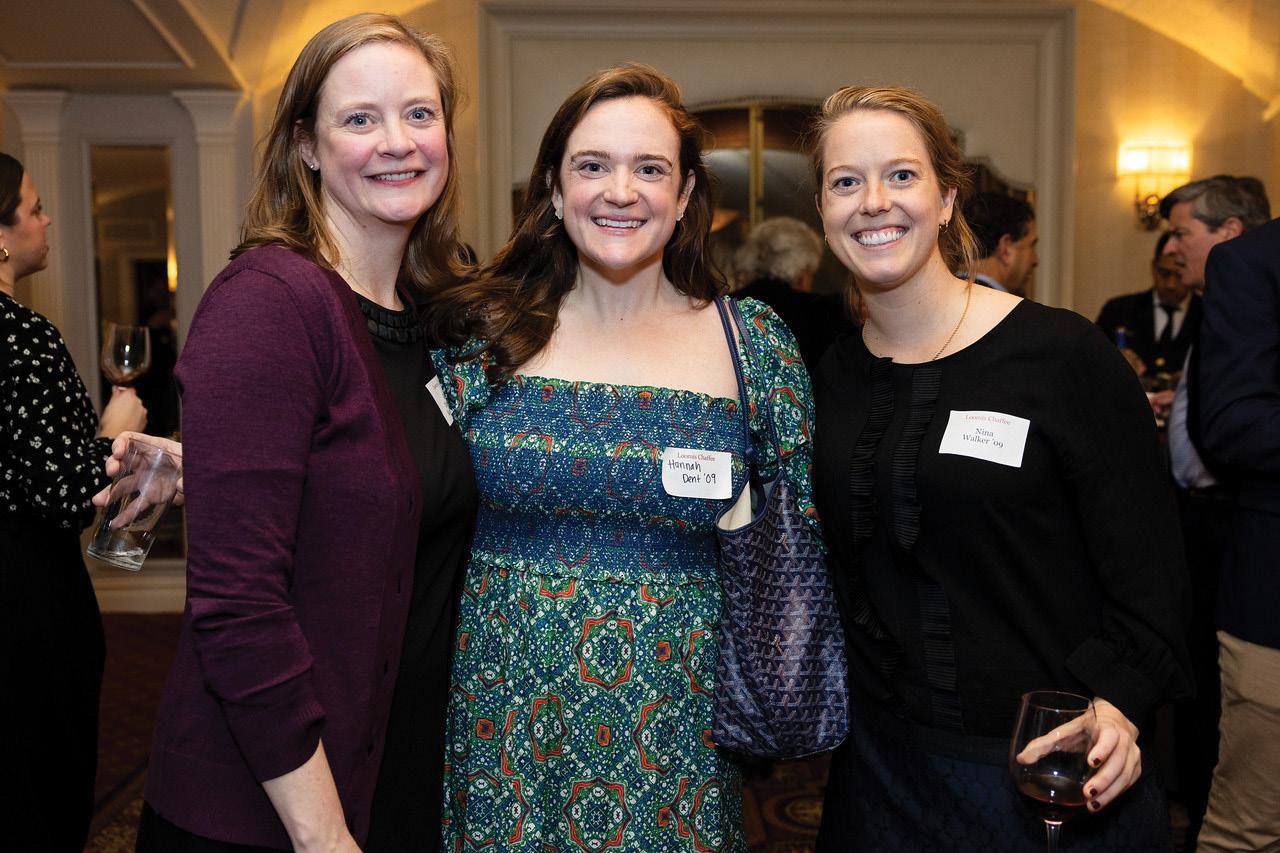




50 Loomis Chaffee Magazine Spring 2024
NEWS FROM ALUMNI / DEVELOPMENT
Above: Former Chair of the Board of Trustees Chris Norton ’76, P ’04, ’05, ’07, ’10, Head of School Sheila Culbert, and Chair of the Board of Trustees Duncan MacLean ’90, P ’24, ’27; and; Top Right: Trustee Xin Tang P ’24, ’27; Patti Wu P ’26; Fong Liu P ’26, and Lauren Dang P ’21, ’27. Middle Left Kari Diamond Kayiatos ’97, Hannah Cashmon Dent ’09, and Nina Walker ’09. Middle Right: Andrew Kurian ’87, P ’23, ’25, Peter Sienkiewicz ’89, and Barnaby Horton ’87. Bottom Left: Jeremy Bogle ’14, Molly Pitegoff ’12, Stephanie Niles ’12, Tom Barry ’11, and Patrick Frigge. Bottom Right: Dang Phan ’79; Trustee Harvey Struthers ’60, P ’85, ’96, GP ’17, ’18, ’21, ’25; Mary Struthers P ’85, ’96, GP ’17, ’18, ’21, ’25; and Trustee David Rogan ’76, P ’04.
West Palm Beach ALUMNI GATHERINGS

ALUMNI GATHERINGS

FEBRUARY 20
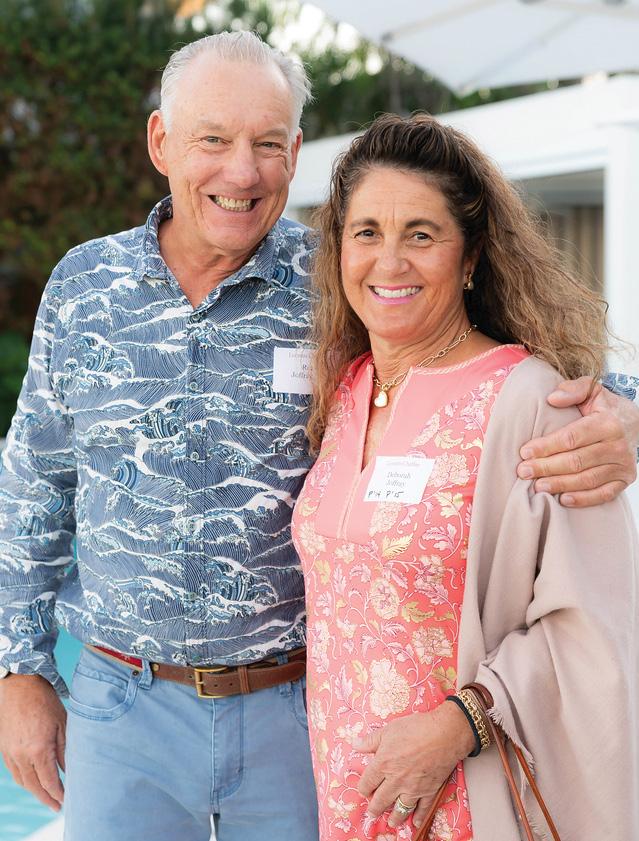
Winter Brunch for Young Alumni, Loomis Chaffee

JANUARY 10


loomischaffee.org 51 NEWS FROM ALUMNI / DEVELOPMENT
Left: Chief Advancement Officer Tim Struthers ’85, Head of School Sheila Culbert, and hosts Anderson Libert and Trustee Jessica Paindiris ’01. Above: Trustee John Bussel ’87, P ’21; Doreen Bilezikian P ’87, GP ’24, ’26; Silvia Lattova; and Arnie Weiss ’87. Right: Rex Joffray ’76, P ’14, ’15 and Deborah Joffray P ’14, ’15.
Above: Mariapaula Gonzalez ’22, Pilar Wingle ’22, Kameron Collins ’22, Matt Aljian ’22, and Gavin Anderson ’22. Top Right: Sofia Preuss ’23, Ellie Ross ’23, Zoe Alford ’23, faculty member Cathy Markowski, and Ethan Alford ’20. Right: Senior Fedora Liu, Erica Zhang ’23, and Dora Lin ’23.
Loomis Chaffee Gatherings in Asia
While traveling in Asia for the school, Head of School Sheila Culbert, Chief Advancement Officer Tim Struthers ’85, and Dean of Enrollment Amy Thompson gathered with alumni, current parents, and parents of alumni at dinners and receptions in a number of cities in November 2023.

NOVEMBER 10, 2023
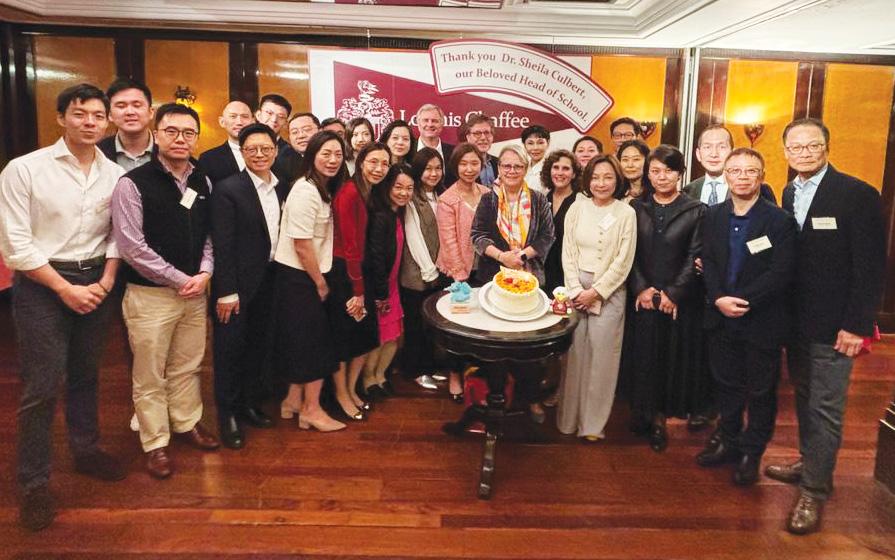
NOVEMBER 14, 2023

NOVEMBER 7, 2023

NOVEMBER 12, 2023
CHINA

NOVEMBER 9, 2023
52 Loomis Chaffee Magazine Spring 2024
• GUANGZHOU,
BEIJING
•
• SEOUL
HONG
•
KONG
SHANGHAI
•
NEWS FROM ALUMNI / DEVELOPMENT
THE RISING GENERATION OF LOOMIS CHAFFEE LEADERS
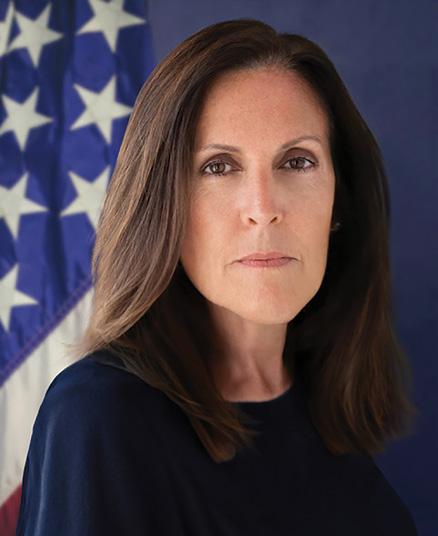
NANCY WALBRIDGE COLLINS ’91
Through quiet philanthropy, former Trustee Nancy Walbridge Collins ’91, whom friends and colleagues often call Wally, seeks to create opportunities for Loomis Chaffee students to excel. “It is my aim to develop a rising generation of leaders.” Wally credits students, faculty, coaches, alumni, and fellow Trustees with the impact of the Island experience.
Educational advancement at Loomis Chaffee comes in distinct forms, including pathways created by trailblazers, adventurers, and explorers. Wally draws attention to eight Loomis Chaffee exemplars of excellence. A classmate returned from the Olympics with a gold medal in ice hockey, an ultimate achievement of athletic training, stellar coaching, and fierce teamwork. A language teacher invited cohorts to boarding schools outside of the United States, broadening travels and sparking friendships among global citizens. An economics teacher brought students out of the classroom to nurture curiosity in American financial firms and international capital markets. A classics instructor started each lecture with the brilliant turn of phrase “Veni, vidi, vici.” A music director encouraged high schoolers, with a medley of changing voices, to sing a cappella in Founders Chapel. A coach instructed young athletes on the value and good fun of rivalry — which included a midnight van ride to the Kent School to attempt recovery of a spoon dating back to the 1920s. One alumnus, a publisher of The New York Times for three decades, offered mentorship at the pivotal postgraduate moment with impactful advice on overcoming conformity with brave action. Another alumnus, who served in four U.S. government cabinet posts, underscored the rigor of academic methods blended with the mission of national service, to build a tomorrow better than today.
Over four years as a student-athlete at Loomis Chaffee, and more than a decade as an LC Trustee focused on investments, admissions, and curriculum, Wally highlights one quality above all else: Leadership. She believes in the adage of giving while living, and calls on the Loomis community to create enduring opportunities for the rising generation with quiet philanthropy. “Our school develops leaders of character who will serve across the nation and the world. Our students welcome the rigorous academic program, thrive in athletic competition and campus camaraderie, and they will build the future. This mission extends far and wide beyond our Windsor years, guided by our core values. Ne Cede Malis.”
Nancy Walbridge Collins ’91 is a member of The John Metcalf Taylor Society, which honors alumni, parents, and friends who have remembered Loomis Chaffee, in their estate plans through charitable bequests, trusts, or other provisions.
For more information about planned gifts and the John Metcalf Taylor Society, please contact Heidi E.V. McCann ’93, P ’23, ’25 at 860.687.6273 or heidi_mccann@loomis.org
www.loomischaffee.giftplans.org
Philanthropy Day Success
February 29, 2024

The 12th Annual Philanthropy Day was a record-breaking success! Our community celebrated the people and programs that make the school exceptional and secured a generous $500,000 challenge gift from an anonymous donor in support of financial aid. This considerable gift will allow the school to continue enrolling the most outstanding applicants and create the best possible educational opportunities for them, regardless of their families’ ability to afford tuition.
New Philanthropy Day Record
1,497 Donors $721,704
Donors by Affiliation
51% Alumni
18% Parents
15% Students
10% Faculty and Staff
8% Parents of Alumni
6% Grandparents & Friends
Top Designations
Greatest Need Financial Aid
Athletics
Diversity, Equity, and Inclusion Initiatives
Arts
*Many of our donors enjoy more than one affiliation with the school.
Alumni Classes with the most Donors by Decade (or overall)
1950s Loomis Class of 1952
1960s Loomis Class of 1969
1970s Class of 1971
1980s Class of 1982
1990s Class of 1990
2000s Class of 2001 and 2009
2010s Class of 2016
2020s Class of 2023
Gifts from Around the World
Canada, China, Hong Kong, Jamaica, Singapore, South Korea, Thailand, Turkey, Ukraine, United Kingdom, United States (38 States), Venezuela, Vietnam
The success of this year's giving day was primarily due to the dedicated outreach efforts led by alumni and parent volunteers. Their enthusiastic engagement and outreach significantly bolstered participation and contributions, underscoring their invaluable role in driving the campaign’s success.
loomischaffee.org 53
Head’s Holiday ALUMNI

FEBRUARY 1
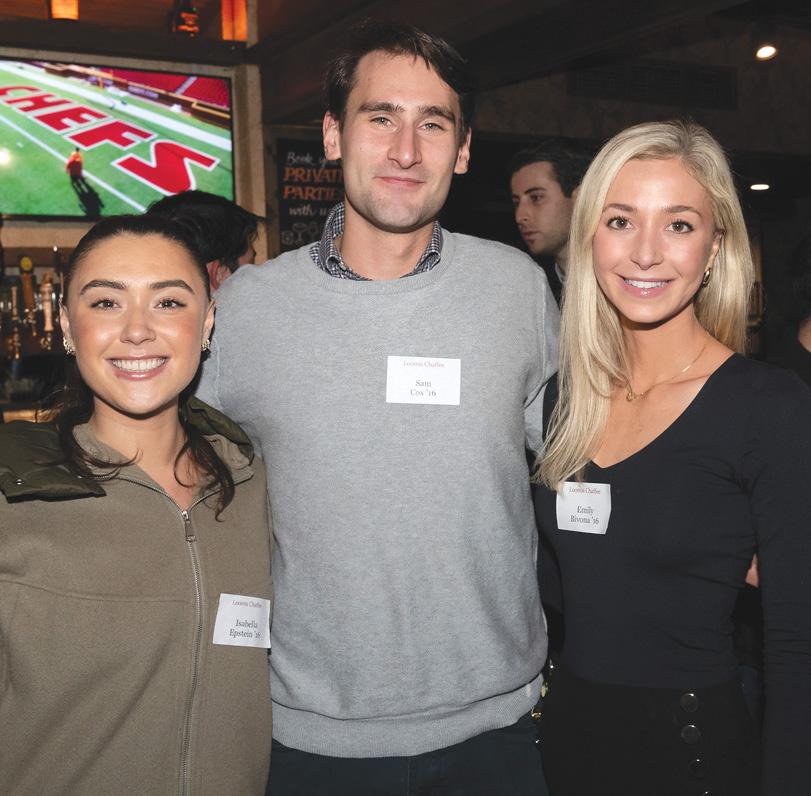


54 Loomis Chaffee Magazine Winter 2024 Spring 2024
GATHERINGS
NEWS FROM ALUMNI / DEVELOPMENT
Above: Young alumni gather to celebrate the tradition of Head’s Holiday. Bottom left: Isabella Epstein ’16, Sam Cox ’16, and Emily Bivona ’16. Bottom middle: Claire Collins ’18, Louisa Gao ’18, and Jacy Case ’18. Bottom right: Alex Chang ’16, Colin Phelan ’16, Dale Reese ’13, and Benji Rosenblatt ’16.

Pelicans at the Ballpark
Join Loomis Chaffee alumni this summer at Dunkin’ Park in Hartford and at Boston’s Fenway Park to root on your favorite team.
Hartford Yard Goats vs. New Hampshire Fisher Cats
Dunkin’ Park
Saturday, June 29, 2024
Boston Red Sox vs. New York Yankees
Fenway Park
Saturday, July 27, 2024
To register and for more information, visit www.loomischaffee.org/alumni

Reunite, Reconnect, and Reminisce • June 7–9, 2024
The countdown to Reunion 2024 is on! Classes ending in 4s and 9s this is your year! Return to the Island for a weekend that includes events and activities that entertain, educate, and celebrate the school. We look forward to seeing you back on the Island in June!
To register and learn more about the weekend, visit www.loomischaffee.org/reunion. Make your plans today!
Questions? Contact Michelle Carr at michelle_carr@loomis.org or 860.687.6815
JOIN LC Connect
LC Connect is an online community and resource for alumni that makes it easier than ever for Pelicans to stay connected to each other and with the school.
LC Connect is an opt-in networking platform, powered by Graduway, that enables alumni to:
• Find and reengage with fellow alumni through the online directory and groups;
• Expand professional connections through mentorship opportunities and a job board;
• Stay up to date with Loomis Chaffee news and activities through an alumni events board and the school’s social media channels;
• Have on-the-go access through the LC Connect mobile app.
Register at www.loomischaffeealumni.org
LC Connect replaces Loomis Chaffee’s Evertrue app and Career Network, upgrading the alumni experience by providing several resources in one platform. Loomis Chaffee’s alumni engagement platform

loomischaffee.org 55
Submit a Class Note Send us your news! Email the Class Notes Editor at magazine@loomis.org to share news with classmates and friends. High-resolution photographs are welcome; please clearly identify all people. Class Notes appear on the
NEWS FROM ALUMNI / DEVELOPMENT REGISTER TODAY!
school website and social media channels.

1944
William K. Zinke, on January 6, in Greenville, S.C. Bill was a three-year student who played football, basketball, and tennis. As a senior he was in the Glee Club and Jazz Club. In 1958, he married Barbara Rhodes, and in 1967 they moved with their five children to Briarcliff Manor, N.Y., where they lived for more than 25 years. Bill was raised in White Plains, N.Y., and graduated from Amherst College in 1948. He earned a law degree from Columbia University and worked for several law firms, in addition to serving as an assistant U.S. attorney in the Southern District of New York. He later served as assistant general counsel at GTE before becoming vice president of industrial relations for the National Association of Manufacturers. His entrepreneurial nature and desire to champion the evolution of the “human resources” field then led him to establish an independent firm in 1969 called Human Resource Services Inc. In addition to executive-search and consulting work, Bill organized several pioneering professional groups, including the Human Resources Roundtable Group and the Chief Legal Officers Group, which met regularly to discuss important topics within the human resources and legal fields. Later, Bill also founded the Center for Productive Longevity, a passion project aimed at helping people 65-plus to remain productively engaged for longer. Bill loved the outdoors, which led him to move to Boulder, Colo., in 1990, where he lived happily at the base of the Flatiron Mountains for 30 years. In 2017 he adopted his beloved dog Rocky, who was his cherished companion until the end. His hobbies included hiking, horseback riding, skiing, and competitive tennis and squash. He also loved the arts, reading, playing pool, and traveling the world. He left five children and their spouses as well as 15 grandchildren.
OBITUARIES
1946
Francis Gage Mason, of Groton Long Point, Conn., at home on February 13, 2023. Frank was a four-year student who played football and baseball all four years and was on the Senior Executive Committee. Frank was born in Paris in 1928 and grew up in Westport, Conn. He earned a degree in electrical engineering from the University of Connecticut in 1950 and was promptly drafted into the U.S. Army. He served at Fort Dix, N.J.,

where he taught radio communications and repair to troops deploying to Korea. He married Phebe George of Mystic, Conn., in 1951. Frank and Phebe built a house in Weston, Conn., where they raised their children, Catherine and Christopher. Frank started his own electronics company when the children were young and employed one other engineer. Over the years, Mason Engineering Inc. grew, eventually employing as many as 30 people. Frank designed and manufactured sophisticated audio
countermeasures equipment for the United States and its allies. After buying a shore cottage at Groton Long Point in 1969, he and the family spent summers at the beach, cruising his sloop near and far. After his retirement and upon the death of Phebe in 1992, Frank continued his lifelong love of sailing the New England coast. He found a kindred spirit in Cynthia Buffington, and the two were happily married for 26 years, sailing and traveling the world together. Their primary residence was “Spindrift” at Groton Long Point, but they shared a nearby home at Mystic Run and spent every winter in Florida at Sanibel Island. Throughout the years, generations of family members and friends met for holidays, birthdays, and soirees at Spindrift. After Cynthia passed away in 2020, Frank remained at the Point and continued many of his interests, including his painting and photography. Under the umbrella of Spindrift Arts, he exhibited his work at the Mystic Art Museum, the Noank Historical Society, Noah’s Restaurant in Stonington Borough, The Big Arts Gallery in Sanibel, Fla., and the Groton Long Point Arts and Crafts Show.
Lucy Elmer Townsend, at home in Wellesley, Mass., on December 23, 2023. Lucy was treasurer of the Athletic Association at Chaffee and was described in the yearbook as “an all-around athlete and super square-dancer.” Lucy was a loving mother, grandmother, friend, teacher, and community member. Raised in West Hartford, Conn., Lucy graduated with a bachelor’s degree from Smith College in Northampton, Mass., and earned her master’s degree from Trinity College in Hartford, Conn. She worked as an elementary school teacher at The Chapin School in New York City and later in her career was the director of development and public relations at Connecticut Community Care. She lived in
loomischaffee.org 57
Connecticut until she was in her early 90s, when she moved to Wellesley, Mass., after the death of her husband, George Townsend. Community service was always important to her, as were her Quaker beliefs. She volunteered with the West Hartford Seniors Job Bank, Meals-on-Wheels, Connecticut Community Care, the Watkinson Prisoners Aid Society, and others. She was a member of the Hartford Monthly Meeting of Friends and, more recently, an attender of the Wellesley Meeting of Friends. Throughout her life, Lucy visited Squam Lake in New Hampshire, where she enjoyed hiking, canoeing, and spending time with family. Her time at Squam also inspired a commitment to conservation and a love for nature. When she was not exploring the outdoors, she was an avid reader of history and current events. A memorial service after the manner of Friends was scheduled for July 2024. Lucy was predeceased by five siblings and
three husbands. She was a mother to four children and eight stepchildren. Lucy loved her huge family of 20 grandchildren and even more great grandchildren, nieces, nephews, cousins, and friends.
1947
William W. Bernhart, on January 5, at home in Chester, Conn. Bill was a two-year student who was on the football and track teams, captaining track as a senior. He was secretary of the Student Council as a senior. For 64 years, Bill was the beloved husband of the late Elizabeth (Tanner) Bernhart. Bill graduated from Yale in 1951. During the Korean War, he served as an officer in the U.S. Navy. He then attended Cornell Graduate School before returning to Connecticut to begin a 32-year career with Pratt & Whitney Aircraft in East Hartford. During that time,

Bill received an advanced degree from Rensselaer Polytechnic Institute and was a Connecticut registered professional engineer. He retired in 1986 as vice president for manufacturing services for Pratt & Whitney Aircraft. During his early retirement, Bill and his wife, Betty, moved to East Orleans, Mass., where they designed and built their waterfront home. He enjoyed tennis and, most of all, captaining his boats, Osprey and Jubilee. He was an accomplished bird carver and woodworker (including a canoe and a grandfather clock), often donating his works to charity. After 16 years, they moved to Old Saybrook, Conn., to be closer to family. There he was a member of the North Cove Yacht Club and the Old Saybrook Rotary Club and served on the board of the HOPE Project. He also continued to pursue his love of the water, often boating down the Intracoastal Waterway to Florida. In 2010, the couple moved to Masonicare Chester Village in Chester, Conn., where Bill continued to make a great impact within this community with his warm smile, curious mind, and sharp bridge-playing skills, and he often acted as a mentor. Bill’s greatest achievement there, at age 80, was designing and helping to build a long wooden footbridge on the property. He often referred to Masonicare Chester Village as an “assisted living country inn” with caring staff, excellent nursing, and a wonderful group of people. Bill was survived by his three children, William T. Bernhart ’71 and his wife, Janet; Lawrence W. Bernhart and his wife, Juliet; and Susan Bernhart Scott ’73; five grandchildren, including Michael Bernhart ’98; and five great grandchildren. A memorial service was held in February at Masonicare Chester Village.
1951
Bruce DeWitt Dixon, on December 21, 2023, at home. Bruce was a three-year student who was a Student Council member. He also was on the football, basketball, and track teams and chaired the Senior Reception Committee. He had been a recent resident of Stamford, Conn., and previously of Greenwich, Conn., for 40 years. Bruce graduated from Harvard College. After serving two years as an officer in the U.S. Navy, he joined the accounting firm of Ernst & Ernst, now Ernst & Young, in Cleveland, Ohio, in 1957; became a partner in 1966; and transferred from Cleveland to New York City in 1981. He retired in 1991. During his
58 Loomis Chaffee Magazine Spring 2024
professional career and in retirement, he was active in several not-for-profit organizations in New York City and Greenwich. He was survived by his wife, Helen McCully Dixon; four children; two step-children; seven grandchildren; five step-grandchildren; and two step-great grandsons. He was predeceased by his first wife, Barbara Engel Dixon, in 2001; and by his sister.
Kenneth W. Weeks Jr., of Bloomfield, Conn., formerly of Farmington and West Hartford, on September 29, 2023. He was a two-year student who played football, was secretarytreasurer of the Darwin Club and vice president and secretary-treasurer of the Photography Club, and received a Senior Book Prize. Ken graduated from Babson College and served as an officer aboard the USS Saline County (LST 1101) for three years in San Diego and the Pacific. Returning to Connecticut, Ken worked with his father until his father’s death in 1966, at which time Ken became president of Walton Company, international supplier of specialized metalworking hand tools. He retired in 1998. Ken enjoyed sailing and woodworking, including boat building. In recent years he enjoyed summering in Round Pond, Maine. He was involved in a number of volunteer endeavors: holding many positions, including commander of the Hartford Power Squadron; serving as commodore of the Hamburg Cove Yacht Club; delivering Meals on Wheels; performing various services as a member of Emanuel Lutheran Church; and serving as a director and president for many years of Leonard Weeks and Descendants in America Inc., in Greenland, N.H., overseeing the ancestral home and conservation easement land. Ken was predeceased by his wife of 48 years, Sarah (Bergeson) Weeks. He left two sons and a daughter. He was predeceased by a sister, Carolyn Weeks Barter ’53; and a cousin, Daniel Wells ’34, who was on the faculty as the school’s first director of development. A memorial service was held in October of 2023 at First Church of West Hartford.
1955
Georges Peter, of Brookline, Mass., on January 11. Georges was a three-year student who played multiple sports, was on the Honor Roll from 1953 to 1955, and was involved in the Debate, Sailing, and Political clubs. Georges graduated from Harvard College. He attended the two-year program at Dartmouth Medical School and graduated
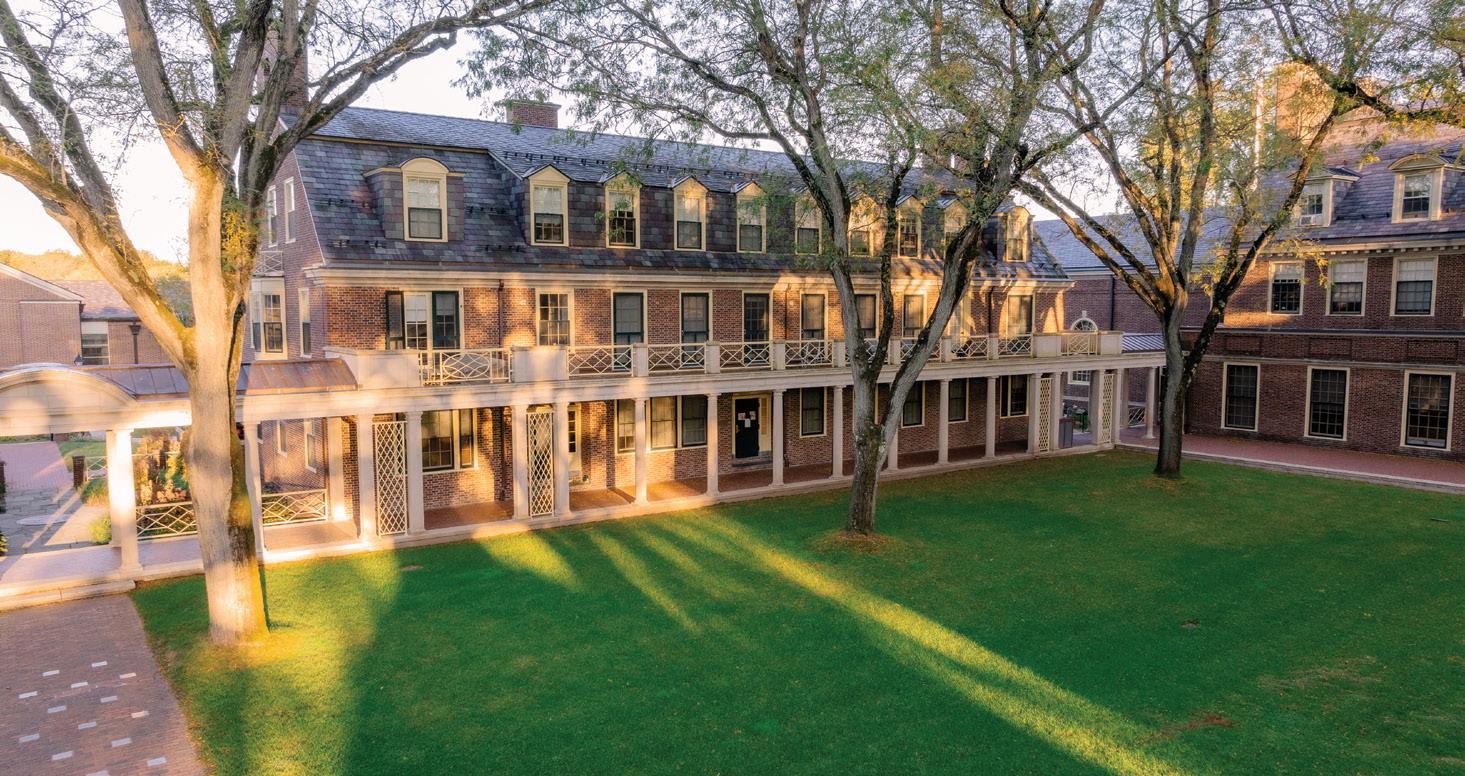
from Harvard Medical School. He trained in pediatrics at Strong Memorial Hospital in Rochester, N.Y., and Children’s Hospital in Boston, followed by fellowships at the National Institutes of Health and Children’s Hospital. In 1972, he joined the faculty at Brown Medical School until his retirement, when he was appointed professor emeritus. During his 34-year career at Rhode Island Hospital and Hasbro Children’s Hospital, he established the board-certified Division of Pediatric Diseases. He authored or co-authored approximately 175 publications. He was a devoted pediatrician, and prevention of once-common pediatric infectious diseases through immunizations was particularly important to him. During his lengthy professional career, he witnessed the disappearance of polio myelitis, marked diminution in the cases of measles, and near-elimination of bacterial meningitis. His advocacy for prevention of infectious diseases led to national recognition, respect, and leadership roles. He was an active member of the American Academy of Pediatrics (AAP), serving on the Committee on Infectious Diseases for 13 years. He was appointed the first full-time editor of the AAP’s highly influential Red Book (Report of the Committee on Infectious Diseases), of which he edited five editions. He served on three federal committees: the Advisory Commission on Childhood Vaccines, the National Vaccine Advisory Committee, and the Centers for Disease Control and Prevention’s Advisory Committee on Immunization Practices. He was a member of the World Health Organization’s Strategic Advisory Group of Experts on Immunization and a president of the Pediatric Infectious Diseases Society. An elected member of the Society of Pediatric Research, the American
Pediatric Society, and the Infectious Diseases Society of America, he was also a member of the Board of Directors of the American Committee for the American Memorial Hospital in Reims, France. Georges received numerous awards, including the Distinguished Physician Award of the Pediatric Infectious Diseases Society, the AAP Award for Lifetime Contribution to Infectious Diseases Education, and a Special Recognition Award from the U.S. Department of Health and Human Services. At Brown, he was awarded an emeritus citation “for 34 years of distinguished service as a teacher, counselor, and scholar.” Georges was dedicated to his family, often spending summers in Annisquam, Mass.; traveling; and sailing competitively with family. The family traveled frequently to Europe during the early years of his retirement, particularly to Switzerland, where Georges’s father was born and grew up, and to the Mediterranean and Caribbean. Devoted to Harvard athletics, Georges managed the Harvard Stadium scoreboard for 29 years, and he was a passionate fan of the Boston Red Sox since childhood. He loved competitive sailing, primarily in the one-design Lightning Class, in which he competed for more than 60 years, winning numerous regattas, and sailing in national and international championships. He was a member of multiple yacht clubs and was awarded the Annisquam Yacht Club’s Smith Trophy “for outstanding achievements in the sport of sailing.” He was survived by his wife of 59 years, Carolyn McClintock Peter, and their two children, Allison Fairchild Peter and Marc Phillips Peter ’88. The family lived in Barrington, R.I., for many years before moving to Brookline in 2004. Peter is also survived by two grandchildren, many nieces and nephews, and a sister.
loomischaffee.org 59
John Anthony Wallace ’55 Former Loomis Chaffee Trustee, 1975–1981

John Anthony Wallace, a former Trustee of the school, on November 15, 2023. John, who was known as Jake, was a four-year student on the Honor Roll from 1951 to 1954, played basketball all four years, and was a basketball co-captain as a senior. He also served as president of the Student Council as a senior, was editor of The Log, and was awarded the Gwendolen Sedgwick Batchelder Prize at Commencement. He remained connected to Loomis Chaffee after graduating, and he served on the Board of Trustees from 1975 to 1981. John came to attend Loomis from St. Thomas the Apostle Grammar School in West Hartford, Conn. He was a resident of Sea Island, Ga., and previously Atlanta. After a post-graduate year at Brighton College in Brighton, England, he attended Princeton University, where he graduated Summa Cum Laude and as a member of Phi Beta Kappa, and Harvard Law School, where he graduated with honors. While at Princeton he was a member of the 21 Club and University College Club. At Harvard Law he was a member of the Holmes Club and Lincoln’s Inn Society. John moved to Atlanta in 1963 to join the law firm of Hansell Post Brandon & Dorsey. In 1965 he left to join King & Spalding, where he would practice for more than
45 years. John was nationally recognized as a leader in trust and estate law and related tax issues. He was a past president of the Atlanta Estate Planning Council, a past chair of the Fiduciary Law Section of the State Bar of Georgia, and a past president of the Southern Pension Conference. In addition, he was past president of the American College of Trust and Estate Counsel, a past chair of the Real Property Probate and Trust Law Section of the American Bar Association, an adjunct professor of law at Emory University in the graduate tax program (1977–1986) as well as an academician and Executive Council member of the International Academy of Trust and Estate Law. He published a number of articles relating to his fields of expertise and was a member of the American Law Institute and the American Bar Association Endowment Fund. John was a member of several social organizations, including the Piedmont Driving Club, Capital City Club, Nine O’Clocks, and Homosassa Fishing Club. An avid golfer, he was a regular at Ocean Forest Golf Club and Sea Island Golf Club for many years. He was particularly proud of being a non-resident member of the Shinnecock Hills Golf Club in Southampton, N.Y., having joined in 1976. John was devoted to serving the Atlanta community. He was an emeritus trustee of Morehouse College, a member of the board of curators of the Georgia Historical Society, and an emeritus trustee of the Westminster Schools. During his career, he served on other boards, including the Atlanta Symphony Orchestra League, the Boys and Girls Club of Metro Atlanta, and the Westover School in Middlebury, Conn. He served on the board of Piedmont Hospital for 35 years. He was survived by two children; six grandchildren; and several nieces and nephews. He was preceded in death by Laura Sauls Wallace, his wife of 53 years; his parents; two brothers, including David Francis Wallace Jr. ’53; and his son, John Anthony Wallace Jr. A celebration of John’s life was held November 28, 2023, at the Cathedral of Christ the King.
1956
Charles Chalmers MacLean III, on December 4, 2023. Charles was a three-year student who played basketball each year and was a football captain as a senior. He also was vice president of his senior class and was awarded a General Prize at Commencement. At age 9, Charles, known as “Chas” to many, moved to what would become the family home in Lloyd Neck, Long Island, N.Y. This place of childhood memories was one to which he would often return in his adult years for a familial retreat and recharge. Lloyd Neck ever remained, to Charles, home. Charles received his bachelor’s degree in 1960 from Yale and completed graduate studies in architecture at Yale in 1964. Charles had a long, successful career as an architect. His designs now stand as small monuments to honor his stellar career. From Puerto Rico to Guam, and in many lands in between, Charles left an indelible mark. His Roberto Clemente Coliseum in San Juan, Puerto Rico, was noted as the largest indoor event facility in Puerto Rico for many years. When that island was devastated by Hurricane Maria in 2017, this coliseum not only withstood the massive storm, but was also used as a place of refuge for displaced citizens. Similarly, when an earthquake with a magnitude of 8.0 struck Guam, causing many buildings to crumble, there were reports of his structure swaying as much as seven feet from side to side, but never giving way. That facility also was used to house refugees after that devastating event. It was on a flight to San Juan that Charles met his future bride, Barbara, and her young son, Eric. Charles and Barbara were married in 1974 in Kentucky then moved to Phoenix, Arizona, to begin a journey that spanned nearly 50 years. In 1976, their lives were blessed with the arrival of their daughter, Heather Lee. Charles opened his own design firm in the early 1980s, Charles Chalmers MacLean III Architects. Meanwhile, Barbara opened her own successful interior design firm and boutique. The couples’ respective businesses thrived in tandem for many years, one often complementing the other. As time passed, Charles dissolved his company and returned to his architectural work as a solo artist. It was also in the years to come that Charles opened space for a pursuit of passion — painting. In August 2002, Charles and Barbara purchased a home in Galena, Md. Resting on a hill, high above the banks of the Sassafras River, their new home would be known as Ducks Landing. Charles
60 Loomis Chaffee Magazine Spring 2024
and Barbara split time between Phoenix and Galena until 2016, when they made Ducks Landing their primary home. Charles lived out his remaining days there. Charles was survived by his wife of 49 years, Barbara Weathers MacLean; his daughter and son; three siblings, including William MacLean ’57; three grandchildren; and other family, including his cousin Burton A. MacLean ’60. A funeral service was held December 8, 2023, in Warwick, Md.
1960
Jonathan Waxman, of Washington, D.C., on August 15, 2023. Jonathan was a four-year student who played multiple sports and was features editor of The Log and an associate editor of The Loom. He was born in Hartford, Conn., graduated from Yale University and Yale Law School, and worked for New Haven Legal Assistance for seven years before moving to Washington to work in the Solicitor’s Office of the U.S. Department of Labor. He joined a private practice representing American Indian tribes for several years and returned to the Department of Labor for the rest of his career. He was a loving husband, father, and grandfather. He left behind his wife, Laura DeKoven Waxman; two children; two grandchildren; and a sister. A celebration of his life was held in the fall of 2023.
1963
James “Jay” Farrell Barrett Jr., on September 24, 2023. Jay was a four-year student who grew up in West Hartford, Conn., but spent most of his adult life in Simsbury, Conn., before relocating to Stoddard, N.H., a few years ago. He attended Colgate University before enlisting in the U.S. Army during the Vietnam War. He served from 1966 to 1969 and was stationed in Germany. While in the military, Jay competed as a member of the pistol team. His interest in target shooting continued throughout his life as a member of both the Metacon Gun Club in Simsbury, Conn., and Ferry Brook Range in Keene, N.H. After military discharge, Jay began his career with Pratt & Whitney in East Hartford, Conn. In time, he completed his bachelor’s degree in mechanical engineering at the University of Hartford and spent the rest of his career at Electric Boat in Groton, Conn. Jay’s childhood introduction to flying was a cockpit visit with pilots of a DC3 en route to Florida. Later, a coworker at Pratt & Whitney taught him to fly. He earned his private license as a member of the CAP Flying Association in Hartford and then used the G.I. Bill to get his instrument, commercial, and multi-engine ratings. Many members of the family have stories to tell about flying with Jay. Jay was 9 years old

when his dad built the family’s first Blue Jay sailing dinghy in the basement of their West Hartford home and brought it to Niantic. As summer residents of Crescent Beach and members of the Niantic Bay Yacht Club, Jay and his siblings sailed throughout their lives. After owning and racing an Atlantic (Hull A91), Jay became interested in cruising and eventually purchased the Tartan 41 VIB that he owned from 1983 until a few years ago. Jay enjoyed cruising and racing, always with his brother Dick managing the crew and deck work. Jay and his wife, Deb, shared a passion for viewing wildlife — from mountain gorillas in Uganda to Bengal tigers in India to grizzlies in Alaska to narwhals in Greenland and Emperor penguins in Antarctica. An accounting of Jay’s life would not be complete without mentioning the pets he loved, including childhood pets Taffy and Freddie. Over the years with Deb, their pack included dogs Queenie, Chelsea, Greta, Morgan, Timmy, Jags, Phoebe, Lacey, and puppy Wednesday. In addition to his wife, Debra A. Barberi, with whom Jay spent 40 wonderful years, he was survived by a sister, two brothers, and many other family members, including his cousin Harriet Dower Stephenson ’61.
1970
Donald Terhune Massey, of Freeport, Maine, on March 15, 2023, from complications with liver cancer. Don was a four-year student who played baseball and football and was a reunion fundraising volunteer. He went on to study American History at Yale University, where he graduated in 1974. Don received his law degree in 1977 from the University of Connecticut Law School. For the next 35 years, Don practiced law in southern Maine, where he was respected for his talents in diverse areas of the law. Although Don was proud of his professional accomplishments, his greater joy in life was his children, Bailey and Andrew, and his granddaughter, Maggie. A dedicated member of St. Bartholomew’s Episcopal Church in Yarmouth, Maine, Don volunteered in many areas, including serving as a lector, maintaining the church grounds, and leading the vestry. Don also demonstrated his stewardship when, after Yarmouth Daycare lost its local campus, he encouraged St. Bart’s to open its doors, and the childcare center thrives there to this day. Don loved music, especially the work of English singer-songwriters. He took his children to their first
loomischaffee.org 61
concerts, insisted on tidying the house to rock and roll, and wore out the cassette player in his car and the six-CD changer in the living room. Don was a talented singer and performed tenor in the church choir for decades. A consummate performer, Don demonstrated his snarky humor both on and off the stage. From starring in his high school productions, to reciting Shakespeare to his children, to directing the church Christmas pageant, to participating in a community production of Our Town in 2022, Don was a thespian at heart. He also enjoyed reading nonfiction and literary classics. Don even volunteered to run the church book sale — no doubt so he could get first dibs. Don inspired his children with his ever-growing bookshelf and was also a wonderful bedtime storyteller. He kept up with this tradition by recommending books to his 2-year-old granddaughter, including the whimsical poems of T.S. Eliot. In addition to his love of art and music, Don was a sports fan who enjoyed playing golf, softball, and baseball. He was a beloved player and teammate on the Giants of Maine Woods Baseball in Bath, playing across several age groups until 2022. Always a supporter of his children’s passions, Don loved coaching Little League and watching games with his son. Don was survived by his son, Andrew Massey; his daughter, Bailey Magrann-Wells; his partner, Barbara Ann McHugh; his co-parent, Pam Wills Waite ’71; as well as two sisters, a granddaughter; his pets; and numerous friends and extended family members. A celebration of Don’s life was held at St. Bartholomew’s Church.
1973
Tally Louise Tripp, an internationally recognized art therapist who brought healing, understanding, and connection to those she taught and mentored around the world, on December 6, 2023, in Alexandria, Va., from cancer. Tally was a three-year student who was president of the Ski Club, an editor of both The Loom and Loomiscellany, and a Photography Club member. As one of the first cohorts to graduate from the George Washington University Art Therapy Program, Tally was taught by some of the pioneers in the emerging field of art therapy. She later returned to the program, first as an adjunct professor in 1992, and then as a full-time faculty member in 2005 until she retired in 2021. Tally was known in the art therapy community and among her hundreds of former students as an inspiring, engaged,
and much-loved educator. Her work also had an impact on her local community through the George Washington University Art Therapy Clinic, a ground-breaking, hands-on student training facility that opened in 2008 with Tally as founding director. The clinic provided affordable art therapy sessions to local and regional communities. Tally had a deep and abiding connection to Africa and its people, a love that began with a four-month National Outdoor Leadership School (NOLS) sojourn in Kenya after she graduated from Roanoke College in Roanoke, Va., in 1979. However, it was not until 2014, when she began leading groups of her George Washington students on study abroad courses (teaching them how to adapt art therapy for use by other cultures) at the Bokamoso Youth Foundation in the township of Winterveldt in South Africa, that she re-engaged with her passion for Africa. Tally’s work there dominated her professional interests for the rest of her life. After she retired from George Washington, Tally engaged fully with her international work, particularly through the Common Threads Project, where she was the director of training. Her work with multiple international groups frequently took her around the world, to Kenya, Tanzania, Ukraine, Democratic Republic of the Congo, Croatia, Nigeria, and Nepal. Tally’s adventurous spirit was ever present, and she took every opportunity afforded her on her travels to explore new regions and their people. Tally
received many awards, including the 2023 International Society for the Study of Trauma and Dissociation Lifetime Achievement Award. She also brought a love of travel to her family, planning adventures throughout Europe and the United States, each trip curated for time spent in interesting places that were not necessarily on tourists’ maps. It was a deliberate attempt to facilitate a direct connection with local residents and to mirror for her children (and her husband) the joy that can be found in every instance of unfettered human interaction. Tally was adopted at birth by William Henry Tripp, a young OB-GYN resident at Women’s Hospital in New York, where she was born, and his wife, Joy Lawless Tripp. The young family later adopted a son, Richard Tripp, and moved to West Hartford, Conn. In 2018, Tally reconnected with her birth mother for the first time and as a result forged a close relationship with her large biological family that she deeply cherished. Tally, her husband, and her adult children were fully embraced by her newfound birth family, and they celebrated Christmas in 2022 together, where Tally’s 91-year-old birth mother brought tears to the family’s eyes with her beautiful piano playing. Tally was survived by her husband, Mark Morrow; two daughters, Olivia Tripp Morrow and Camille Louise Tripp Morrow; a brother, Richard Tripp ’76; and her newfound

62 Loomis Chaffee Magazine Spring 2024
biological family, including her mother, Janet Maxwell Foster Berne, and her three siblings. A celebration of life was held April 13 at Trinity United Methodist Church in Alexandria.
1982
Kathy Rubenstein, of Cincinnati, Ohio, on December 18, 2023, following a lengthy illness. Kathy was a three-year student who was a dormitory prefect, vice president of the senior class, a tour guide, and a member of Student Council as well as other committees. She was born in Shreveport, La., and was survived by her parents, David and Sue Rubenstein; her siblings, Bonnie Rubenstein Wunsch and husband Alan Wunsch and Sam Rubenstein; her nephew Ryan Wunsch; and close friend Pam Bloodgood. After Loomis Chaffee, Kathy attended Washington University in St. Louis, Mo. She had a long career with Procter & Gamble until her retirement in 2020. Kathy loved living life to its fullest, traveling the world, entertaining at home, and spending time with family and friends.
1992
Daniel Varian Jones II, on January 28, a cherished husband, father, brother, son and all-around amazing person. Danny was a two-year student who played lacrosse. Danny lived and died in Woodstock, Vt. He was raised in New Canaan, Conn., and bikes and athletics were central to Danny’s childhood and would come full circle when he moved to Vermont and started his family. As a youth, during the long days of summer, he spent countless hours building bike trails with his best buddy, Ryan Ruggiero ’91, or could be found braving the traffic on Route 123 with a tennis racket bobbing out of his backpack biking to the New Canaan Field Club. Maybe a trip to town to the Sweet Shoppe for a “grab bag” and a ride home to create anything and everything from a box of random Legos. Danny’s loves were ice hockey and lacrosse. He was fortunate to have won multiple state championships in both. Danny was a curious, intelligent, unconventional learner who loved to ask questions, research his vast interests and share his learnings with others. As a student, his path was not always linear and was more adventure than academic, but he chartered his own course and was all the better for his
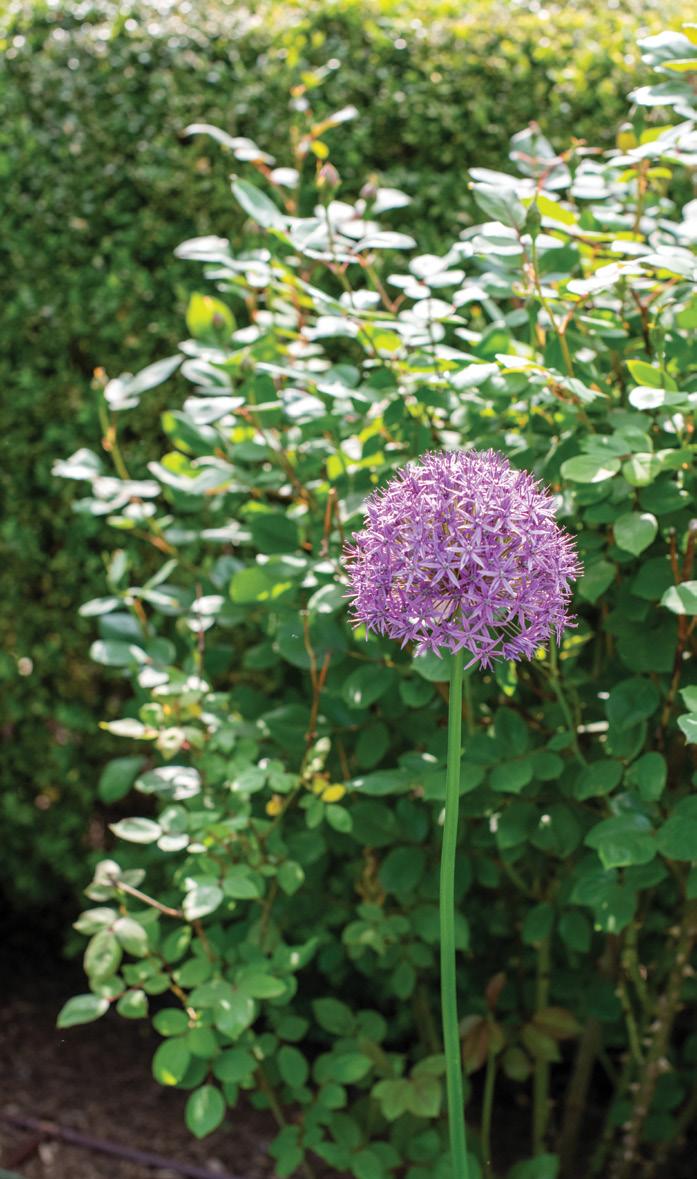
achievements. After graduating from Loomis Chaffee, he attended Lafayette College. In Chester, Vt., in 1995, Danny re-met Ann Afragola, a longtime childhood acquaintance. Danny soon convinced Ann to quit her job working for his father at NewsBank Inc. and drive across the country with a six-monthold Siberian Husky. Armed with a paper notebook listing brewpubs to visit, paper maps, and a 10-disc CD changer, their twomonth second date led to a wedding in 1999. Danny carried his love of athletics into adulthood and cherished his days coaching youth hockey and lacrosse in Woodstock. His professional life involved working alongside his father and sisters to grow NewsBank Inc. He left his mark on NewsBank as the consumer division’s first president by leveraging the company’s historical newspaper content and growing GenealogyBank into the successful product that it is today. More than anything, Danny wanted a family. His children, Isabel Grace, Daniel “Trey” Varian III, and Charles Madison, are his greatest achievements and brought him immense joy and pride. On October 19, 2021, ALS, or amyotrophic lateral sclerosis, came into Danny’s life. For more than two years, Danny and his family took on ALS with the skills he taught his athletes and children when faced with adversity: Plot a course of action with courage and rely on your inner strength. Although the disease took away his physical strength, it didn’t come close to
touching his spiritual and emotional strength. Danny was survived by his wife and best friend, Ann Jones; his three children; his parents; and many other family members. At Danny’s wishes, a celebration of life was to be scheduled for early summer with music, friends, stories, and love.
1996
Matthew Ryan Lawson, in his home in Portsmouth, N.H., on January 2. Matt was a two-year student from West Hartford, Conn., who played football. He was known for his smile, kindness, warm heart, and loyalty to those he loved. He was an intellect, a deep thinker, and a ponderer. Matt traveled with a book in hand or in his pocket. Reading was a hobby and an interest, yet it also offered a way to find solace in the words of others and move himself beyond whatever was on his mind. His numerous tattoos told a story of his journey through life. The tattoo on his left hand was evidence of his priorities and deep love for his family: a compass rose with the initials of his nephews and nieces in place of the cardinal directions. Matt knew that the purest love would guide him to safe harbors and bring him home in times of need. In recent years, Matt relied on this guidance and would always be welcomed with an “Uncle Matt!” when he came home. Matt benefited from the services and support of Safe Harbor as he worked to address his addictions. His loved ones are forever grateful for Safe Harbor’s support and services as it helped Matt regain his true self. Matt graduated from St. Michael’s College in Burlington, Vt., with an academic focus in Irish literature, although his true major and passion was snowboarding. After an injury left him unable to continue the sport at a competitive level, he sought other ways to use his creativity and passion, including copper-smithing, diving, construction, and working as a cook in various New Hampshire seacoast restaurants. Matt moved around New England, living in Vermont, Connecticut, Massachusetts, and New Hampshire in the past 25 years. Matt left behind a family who will miss him beyond measure: his father, Richard Lawson, and his spouse, Shay Foster; his sisters Meegan Reis, Erin Lawson, and Courtney Lawson and their spouses; his nephews and nieces; and extended family and friends who were like family. He was predeceased by his mother, Marilyn Stolz Lawson. A celebration of life was held in Portsmouth on January 6.
loomischaffee.org 63
Former Faculty
David John Beare, on December 27, 2023, after a seven-month battle with an aggressive form of brain cancer. David taught at Loomis Chaffee from 1987 to 1992. He was born in Seattle, Wash., and grew up in Olympia, Wash., with the same core group of friends from elementary to high school. His friend group of smart, budding classical musicians, Francophiles, and dramaturgs — affectionately dubbed his “nerd herd” by his daughter — were destined to do big things beyond Olympia, and David was no exception. In Washington, David also developed his lifelong relationship with the great outdoors by hiking and climbing in the Cascade and Olympic mountains. He traveled across the country to attend Georgetown University’s School of Foreign Service and was immediately drawn in by the Jesuits’ commitment to thoughtful scholarship, servant leadership, and global outreach. This path led him to degrees from Harvard Divinity School and Harvard Graduate School of Education, his baptism into the Catholic Church as an adult, and his career path as an educator. While starting out as a history teacher, David enjoyed teaching courses in philosophy and comparative world religions the most. He delighted in the opportunity to open students’ minds to questions and possibilities that

were new, complex, and intellectually invigorating. He reveled in the spirituality and humanity inherent in all religions, and he delighted in the shared stories that weave through the tapestry of religious thought across cultures and continents. David’s career as an educator took him from teaching to developing and implementing new interdisciplinary curricula and leading departments in boarding schools throughout New England. In addition to teaching at Loomis Chaffee, he taught at Phillips Exeter Academy, Hotchkiss School, and Lakeside School, a leading day school in Seattle, Wash. At the height of his career, he helped start Keystone Academy, a K-12 day and boarding school in Beijing, China; and served as head of Middlesex School in Concord, Mass. Throughout his professional life, he was known to act
not out of his own self-interest, but in ways that best served the needs of his students, colleagues, and school community. He was thoughtful and loving — the first to pick someone up from the airport or to drive long distances to share a special moment with a friend. As a lifelong learner he was easily engaged in conversations raging from Hindu mythology to Chinese philosophy to Zadie Smith’s latest novel or an offbeat piece of music heard on National Public Radio. His interactions with others were defined by his compassion, humility, and good humor, and his passions included playing the cello, walking in the woods, and sharing good food and wine with friends. He was survived by his partner of 33 years, Rachael Scott Beare ’86; their two children, Sarah and George; siblings Cheryl Bayle and Ken Beare and their partners; his beloved cat, Bangs; and many extended family and good friends scattered around the globe. A memorial service was held at St. Paul Parish in
More News
The alumni office has learned of the deaths of John Forbes Hobson ’41, on June 30, 2019; and Richmond Crolius ’62, on November 29, 2023. More information, as available, will be published in a future magazine.

64
Magazine Spring 2024
Loomis Chaffee

Getting the Shot

There are usually some antics behind the scenes of a photo shoot, even when the assignment is a portrait of the head of school. Sheila Culbert’s dogs provided comic relief during the photo shoot for the cover and Q&A feature of this issue of Loomis Chaffee Magazine. And then-Head of School John Ratté appeared to be up to mischief while a photographer took his portrait in his final year as head, 1995–96. No doubt the photographer — John’s wife, Lou — was a good sport about it, as was Sheila’s photographer, Jane Shauck of Iris Photography.

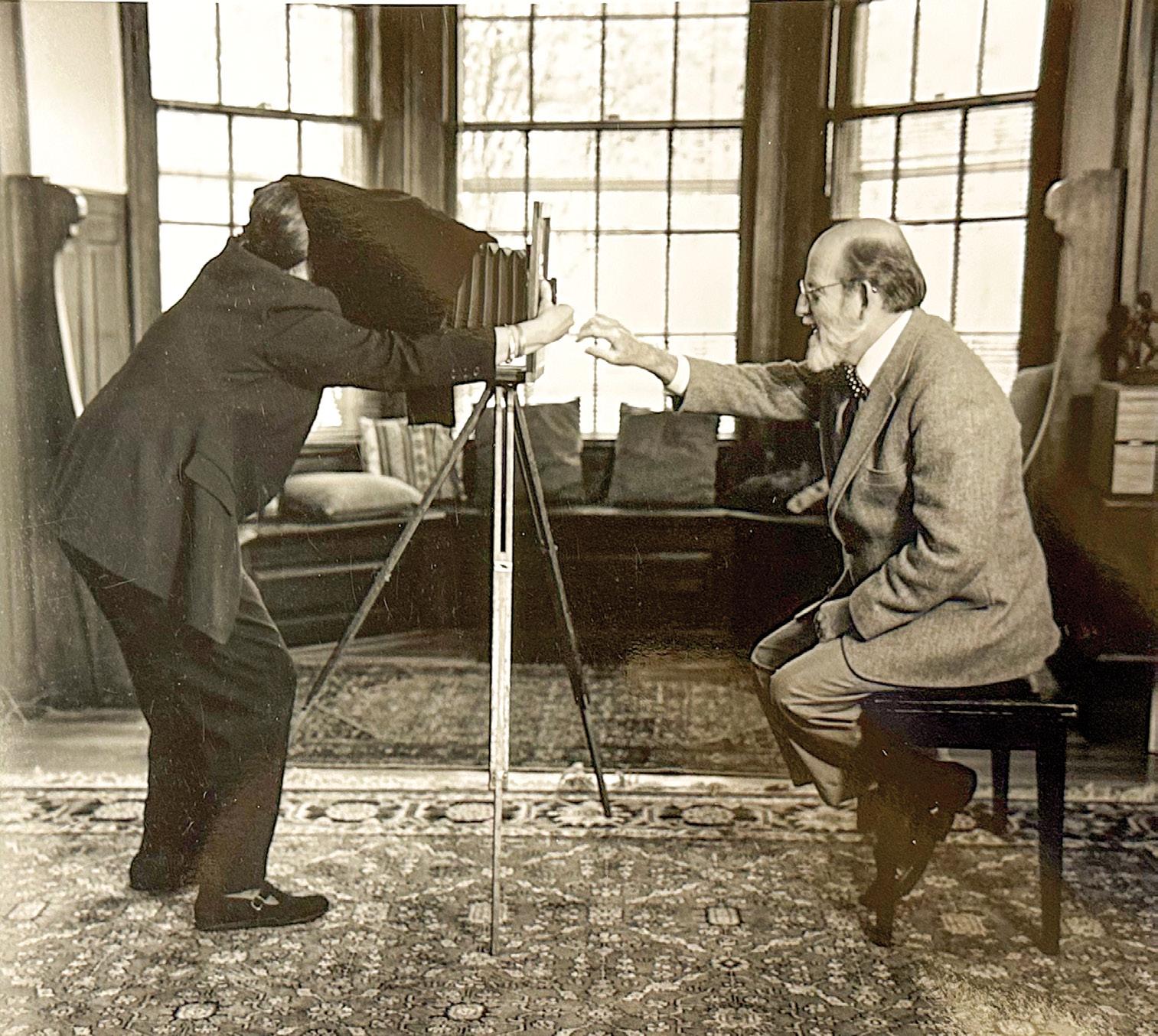
loomischaffee.org 65 REFLECTIONS
Top: Gracie steals a kiss from Jane Shauck, and Whitby steals the spotlight during a photo shoot in Sheila’s office. Bottom: In what may have been some good-natured play-acting, Lou Ratté prepares to take a portrait of John in the Head’s House.
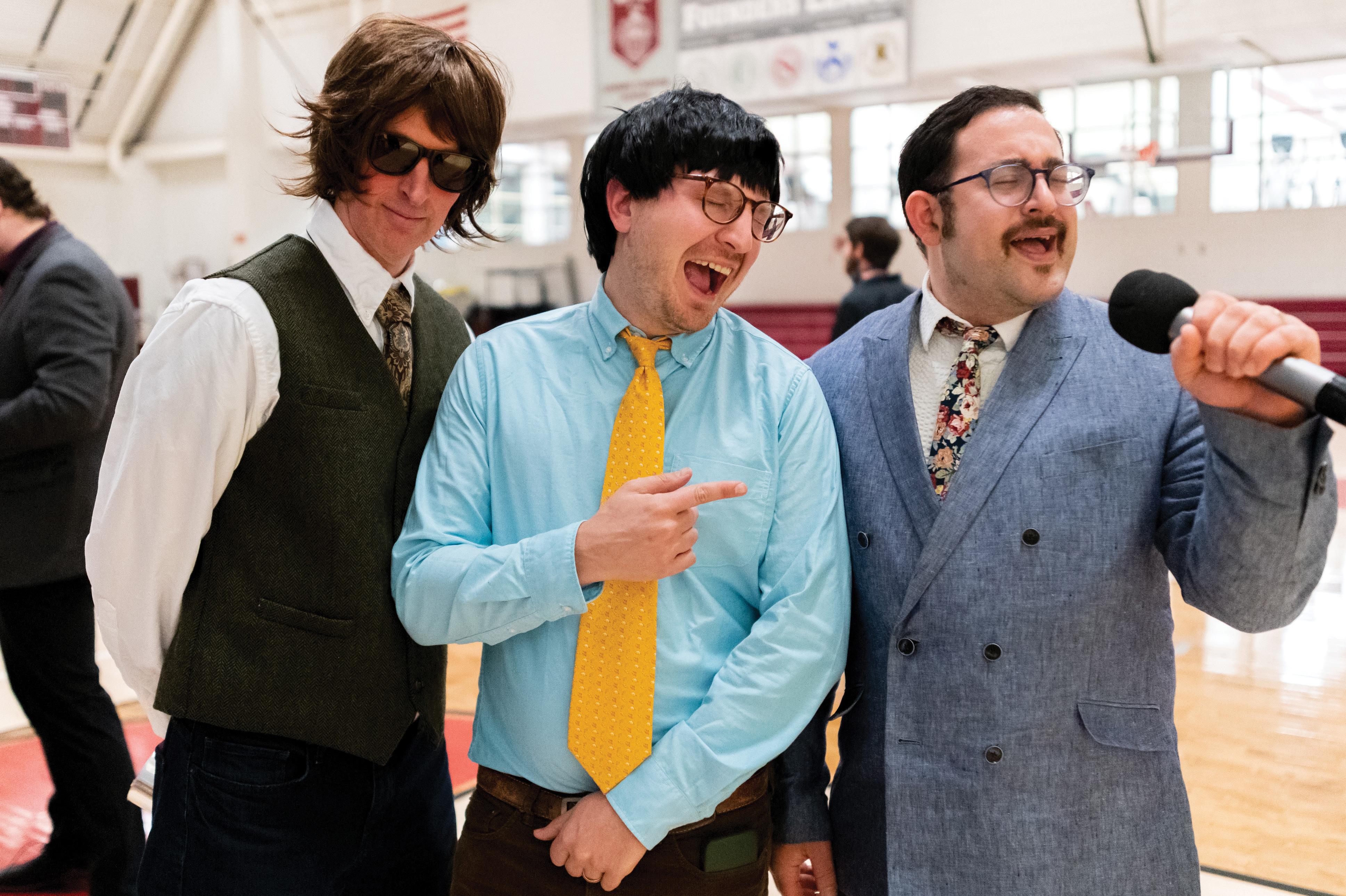
Nonprofit Org. U.S. Postage PAID Loomis Chaffee School The Loomis Chaffee School 4 Batchelder Road Windsor, Connecticut 06095
CHANGE SERVICE REQUESTED
Faculty Lip Sync stars Jeff Dyreson, Ned Heckman, and Adam Alsamadisi after their performance of “You Really Got Me” by the Kinks in February.





















































































































































































